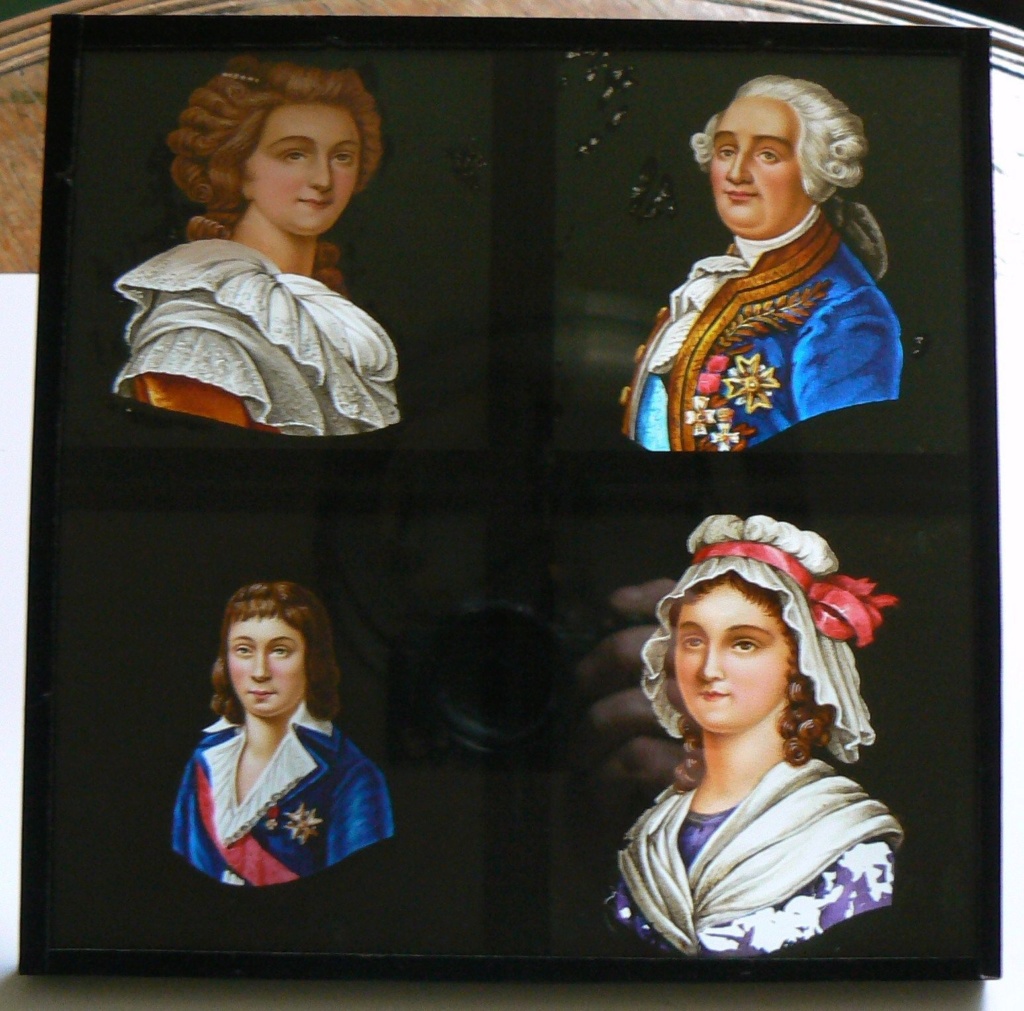La peinture sous et sur verre au 18e siècle, et la technique du verre églomisé
+2
Lucius
MARIE ANTOINETTE
6 participants
LE FORUM DE MARIE-ANTOINETTE :: La France et le Monde au XVIIIe siècle :: Les Arts et l'artisanat au XVIIIe siècle :: Les arts graphiques et la sculpture
Page 1 sur 1
 La peinture sous et sur verre au 18e siècle, et la technique du verre églomisé
La peinture sous et sur verre au 18e siècle, et la technique du verre églomisé
C'est une exposition, présentée prochainement au Vitromusée de Romont (Suisse), qui me donne l'idée d'ouvrir ce sujet concernant cet art pictural que, personnellement, j'apprécie beaucoup... 
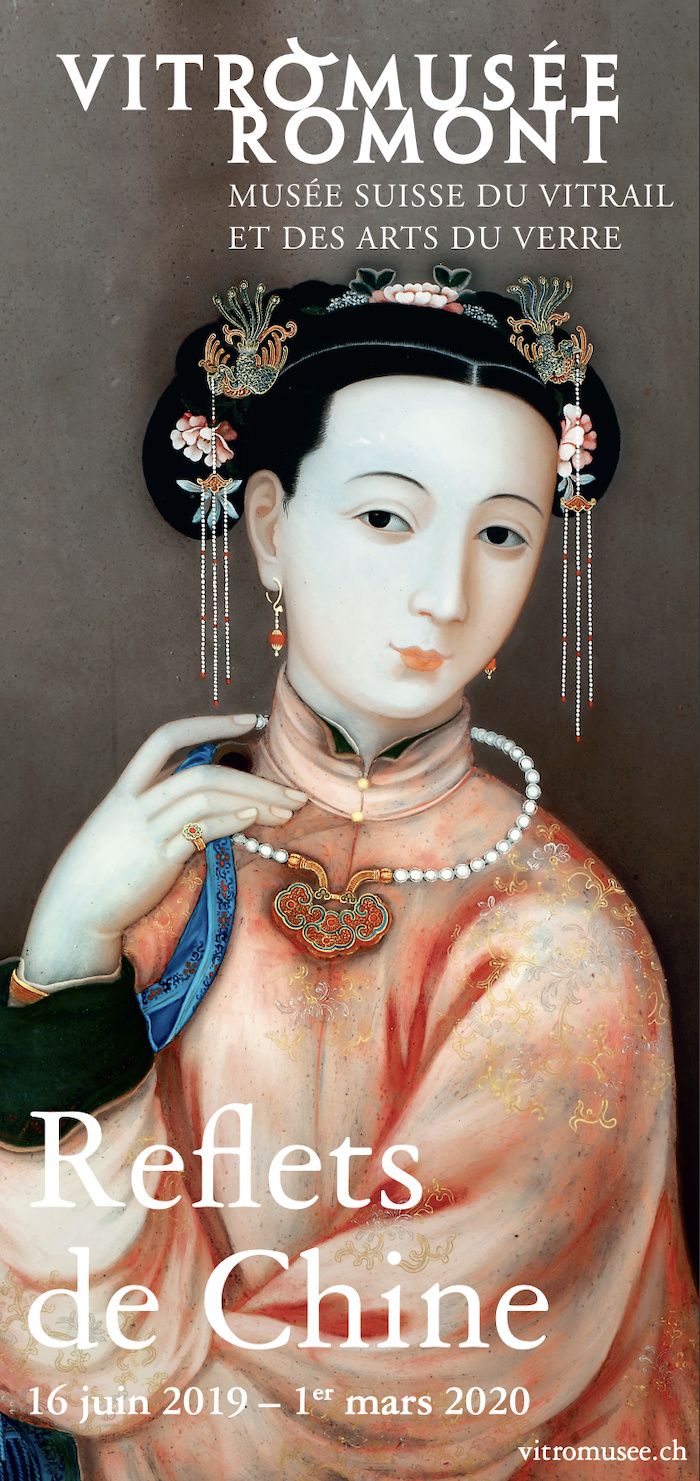
Présentation :
Reflets de Chine - Trois siècles de peinture sous verre chinoise
16 juin 2019 - 1er mars 2020
Paysages fantastiques, portraits d’enfants et de concubines, scènes tirées de la vie familiale et de grands romans épiques, créatures issues de la mythologie, représentations de symboles : le Vitromusée propose la première grande exposition présentant un panorama de la peinture sous verre chinoise, une production artistique exceptionnelle et peu connue à ce jour.

La bonne bergère, vers 1760
Image : Collection Vitrocentre
A travers un choix exclusif d’environ 130 œuvres provenant de deux collections privées majeures d’Allemagne et de France ainsi que de celle du Vitromusée, complétées par quelques prêts d’autres musées suisses, l’exposition retrace la longue histoire de la peinture sous verre chinoise : sa naissance au XVIIIe siècle, issue de la rencontre des traditions picturales chinoise et occidentale, sa « mondialisation » via l’exportation, avant de devenir un art populaire au XIXe siècle.
Elle témoigne du goût de la cour impériale chinoise de l’époque, de l’engouement de l’aristocratie et de la bourgeoisie européenne, puis américaine pour les chinoiseries et donne une idée de la vie du peuple chinois, en dehors des classes privilégiées.
Plongé dans un monde exotique, le visiteur découvre un domaine fascinant du patrimoine culturel chinois, et des œuvres d’une extrême finesse d’exécution.
* Source et infos complémentaires : Vitromusée de Romont
INTRODUCTION TECHNIQUE :
 Avant de présenter quelques illustrations d'origine chinoise, faisons un bref détour en Europe, grâce à des extraits d'articles qui présentent les arts de : la peinture sous verre, de la peinture éludorique (fixée sous/sur verre), et enfin celui du verre églomisé.
Avant de présenter quelques illustrations d'origine chinoise, faisons un bref détour en Europe, grâce à des extraits d'articles qui présentent les arts de : la peinture sous verre, de la peinture éludorique (fixée sous/sur verre), et enfin celui du verre églomisé.
Grosso modo, la production que je désigne ici sous le titre de ce sujet comme "peinture sous verre", était déclinée selon ces différentes techniques, parfois combinées entre-elles au point qu'il serait trop fastidieux de présenter les nuances et nombreuses sous-techniques.
Il s'agit juste de comprendre le principe général...
 La peinture sur verre inversée, ou peinture sous verre
La peinture sur verre inversée, ou peinture sous verre
La peinture sur verre inversé (ou peinture sous verre) est une technique artistique difficile qui s'exécute directement sur une feuille de verre. Le verre supporte la peinture comme le ferait une toile.(...)
Ainsi le verre sert à la fois de support et de vernis protecteur. C'est une technique de peinture « à froid » de sorte que le procédé n'exige pas de cuisson au four.
Le pigment est lié au verre par un véhicule huileux le plus souvent à base de vernis.

Marie Leszczynska, reine de France
Pierre Jouffroy, d’après Jean-Marc Nattier
Gouache sur verre, 1760
Image : RMN-GP (Château de Versailles) / Gérard Blot
En peinture sur verre inversé la technique est unique car l'œuvre est réalisée sur le dos du verre. Alors que sur une toile on esquisse la composition à grands traits pour ensuite exécuter les aplats de couleur pour terminer graduellement par les détails, en peinture sur verre inversé on procède à l'inverse.
C'est donc dire que l'artiste peintre sur verre commence par les finesses de l'œuvre pour terminer avec les fonds.
Ainsi jusqu'au moindre détail, le peintre doit imaginer dès le départ la version définitive de l'image à réaliser sachant bien qu'il devra aussi composer avec un « effet miroir » lors de l'exécution de l'image puisque ce qui est peint à l'envers à droite se trouve à l'endroit à gauche.
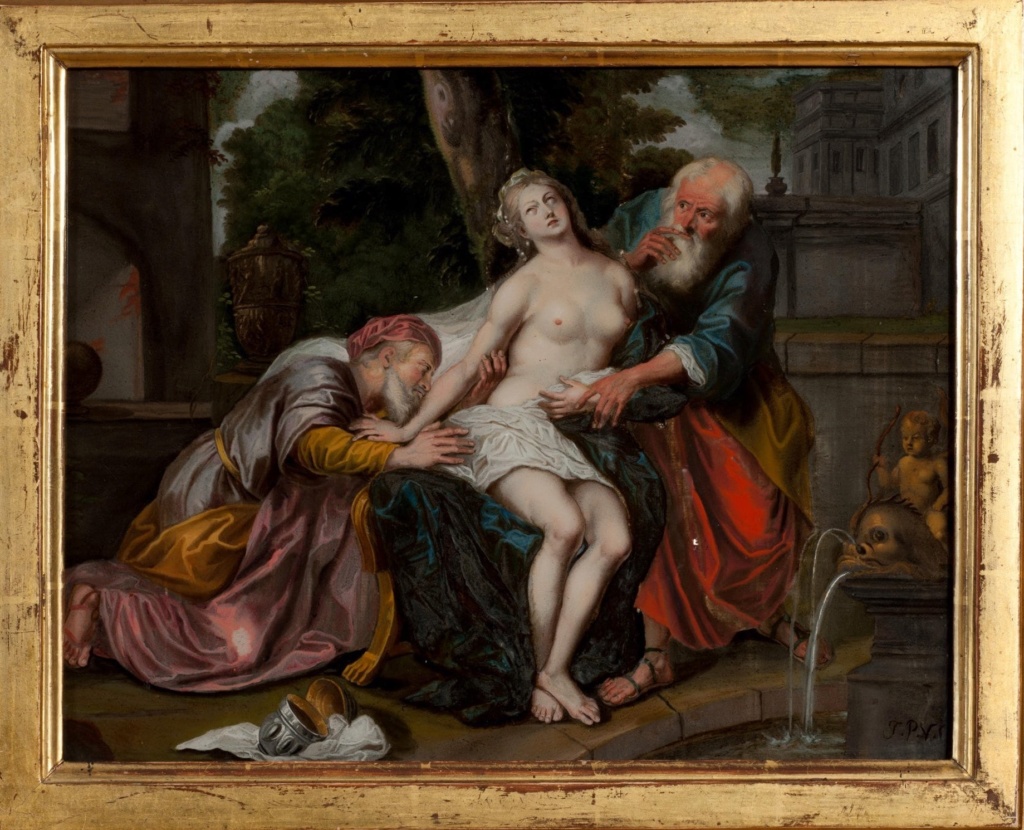
Susanna im Bade und die beiden Alten
Johann Peter Abesch
Hinterglasmalerei, um 1720
Image : Vitrocentre Romont (Foto: Yves Eigenmann, Fribourg)
La peinture sur verre a pour avantage d'offrir une bonne protection à la peinture mais elle demande une grande maîtrise technique car la couche peinte en premier sera la première couche visible.
La vitre protège la peinture et lui donne son aspect lisse et brillant caractéristique. (...)
Histoire :
La peinture sur verre inversé est connue en Occident depuis l'Antiquité. Qualifiée d'« art savant », c'est au cours de la Renaissance que cette forme d'art atteignit son apogée en ce que les compositions devinrent très élaborées, les coloris harmonieux, la virtuosité de la technique étourdissante.
Jusque-là réservée à une élite d'artistes, la peinture sur verre inversé s'est largement diffusée et deviendra un art populaire en Europe lors de la seconde moitié du XVIIIe siècle. (…)

Marie-Antoinette
Anonyme, XIXe siècle
Gouache fixée sous verre
RMN-Grand Palais (MuCEM) / Jean-Gilles Berizzi

Incroyable
Peinture sous verre
Fin XVIIIe, début XIXe siècle
Musée Borély Marseille
Image : Wikipedia

Regency Reverse-Glass Painted Silhouette Group
By Charles Rosenberg (1745-1844), circa 1800
Depicting, from left to right: Sir William Fawcet or Master General; Frederick, Duke of York; the Duke of Wirtemburg; George III and Queen Charlotte; the Stadholder; and George IV when Prince of Wales, beneath trees, in a moulded giltwood frame (…)
Image : Christie’s
* Source et article dans son intégralité, à lire ici : Wikipédia - La peinture sur verre inversée
 La peinture éludorique ou fixé sous (ou sur) verre
La peinture éludorique ou fixé sous (ou sur) verre
La peinture éludorique un procédé qui consiste à peindre un sujet sur un tissu très fin ou sur une plaque de verre.
Au lieu d'appliquer un vernis protecteur sur la peinture, l'artiste colle directement un verre de protection sur la couche picturale. Il obtient ainsi une grande intensité de couleurs et une surface parfaitement brillante.
La technique est inventée par Armant Vincent de Montpetit (1713-1800) durant la seconde moitié du XVIIIe siècle.

Louis XV, roi de France
Armand-Vincent de Montpetit
Huile sur toile collée au revers d'une glace selon la technique de la peinture éludorique
1774
Image : RMN-GP (Château de Versailles) / Jean Popovitch

Jean-Sylvain Bailly
Anonyme, d'après Jacques-Louis David
Huile sur papier collé sur une plaque de verre
XVIIIe siècle
Image : RMN-GP (Château de Versailles) / Franck Raux
Après avoir été appliquée sur des grands formats (vu la fragilité du verre à cette époque, avec un succès douteux), cette technique est restée fréquente jusqu'au milieu du XIXe siècle pour des miniatures destinées à orner des boîtes et des presse-papiers.
Avec le temps, il arrive que le support se décolle du verre.
Certains artistes peignent directement sur la plaque de verre, puis protègent leur œuvre avec un carton.
* Source et article dans son intégralité, à lire ici : Wikipédia - La peinture éludorique
 La technique du verre églomisé
La technique du verre églomisé
La technique du verre églomisé remonte à l'Antiquité.
Elle consiste à fixer une mince feuille d'or ou d'argent sous le verre ; le dessin est exécuté à la pointe sèche et est maintenu par une deuxième couche ou une plaque de verre.
Cependant le procédé est fragile, d'une part parce que le support est le verre et d'autre part parce que l'or a tendance à se déliter avec le temps et en raison de la chaleur, qu'elle vienne du chauffage ou des rayons du soleil.
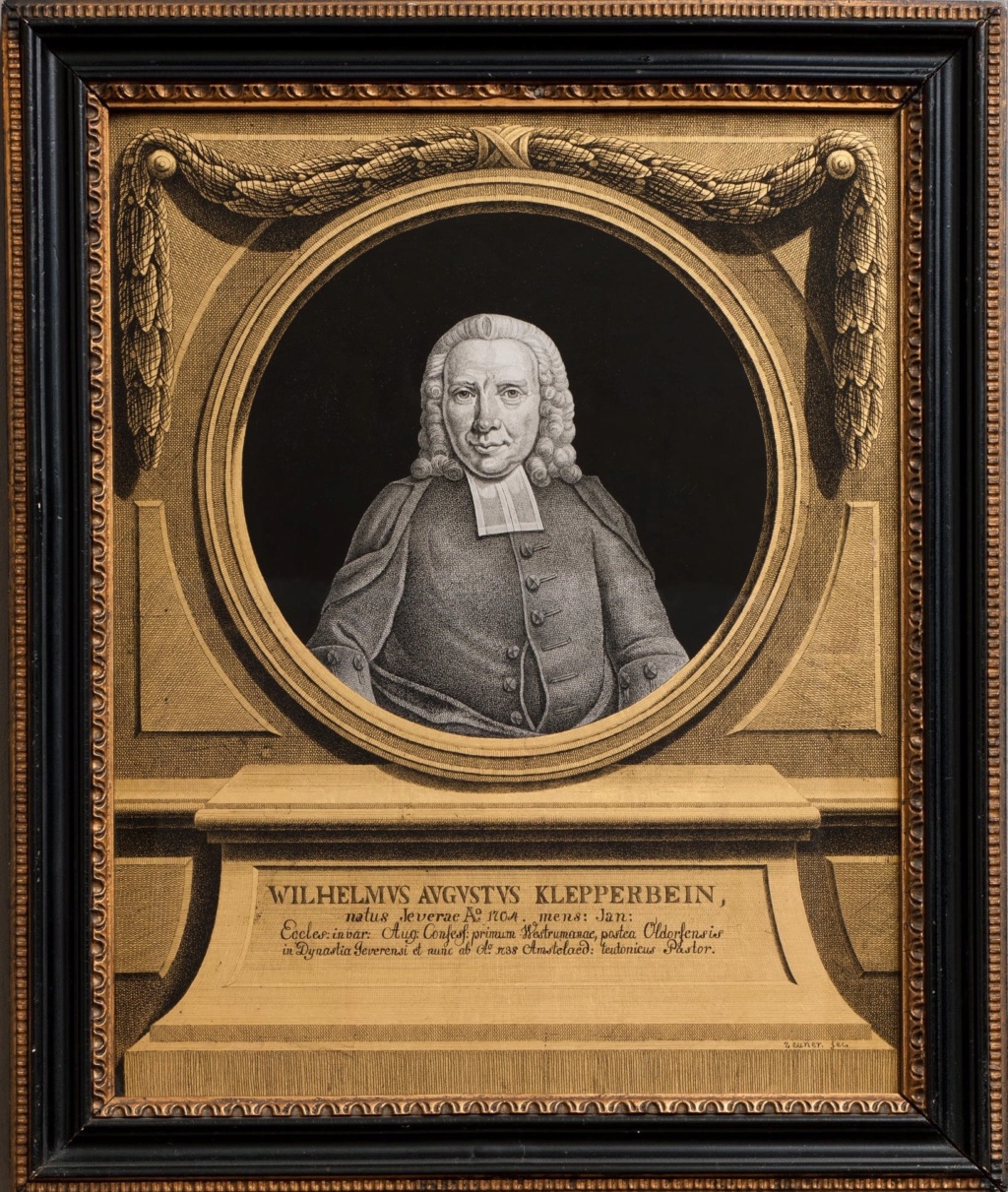
Bildnis des Pastors Wilhelm Augustus Klepperbein
Jonas Zeuner
Spiegelglas. In Gold- und Silberfolie, schwarz hintermalt.
Um 1780
Image : Vitrocentre Romont (Foto: Yves Eigenmann, Fribourg)
Histoire :
Dans l'Antiquité, les artisans égyptiens savaient déjà souder au feu des feuilles d'or entre deux pellicules de verre.
Lors de la Renaissance, la technique est utilisée dans la décoration des cabinets : des panneaux ornés de rinceaux et d'arabesques sur fond doré habillent les façades des tiroirs.
Dès le XVIIIe siècle, siècle des Lumières, la technique se répand en Europe sur le couvercle de bibelots, de bonbonnières, tabatières et sur des miroirs. Ce procédé était utilisé en Bohême sous le nom de Zwischengoldglasser.

A German Baroque verre églomisé mirror
Lohr, circa 1725-30
Count Lothar Franz von Schönborn established a mirror manufactory in Lohr, Bavaria, in 1698.
Image : Sotheby’s
En France, c'est Jean-Baptiste Glomy (vers 1711-1786), encadreur parisien des rois Louis XV puis Louis XVI, qui remit ce procédé à la mode.
Il l'appliqua au passe-partout des gravures et connut un tel succès, surtout à partir des années 1780, que le verre églomisé perpétua désormais son nom.
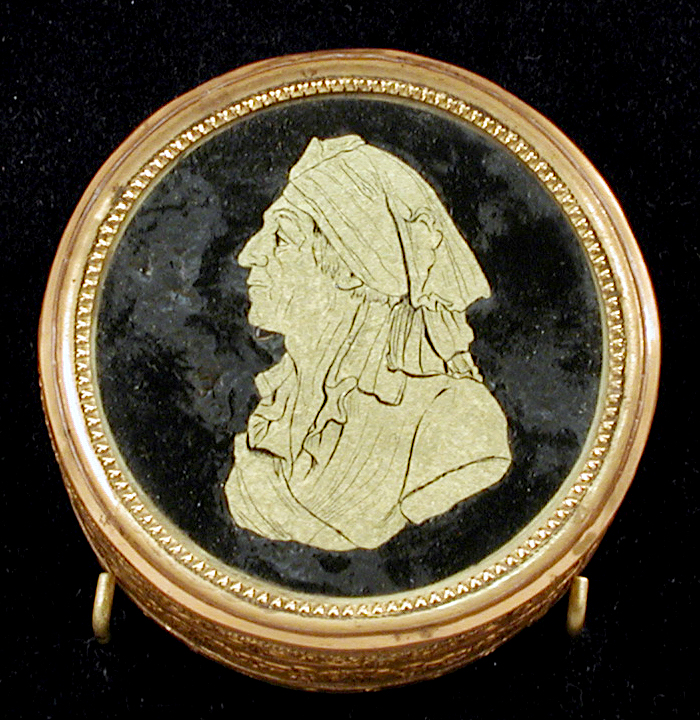
Box with portrait of Jean Paul Marat
Verre églomisé, pasteboard
France, late 18th century
Image : The Metropolitan Museum of Art

Catherine II (1729–1796), Empress of Russia
Verre églomisé
Russia, second half 18th century
Image : The Metropolitan Museum of Art
Au XIXe siècle, divers décorateurs combinèrent cette dorure avec de la gravure et des peintures toujours sous verre. Ils réalisèrent ainsi des ornements destinés à couvrir le plafond, les murs et la devanture des magasins.
De véritables chefs-d'œuvre ont égayé les rues du Paris de la Belle Époque puis de toutes les grandes villes du monde.(...)

Boulangerie, 19 rue Montgallet à Paris
Image : Lionel Allorge / Wikipedia
* Source et article dans son intégralité à lire, ici : Wikipedia - Verre églomisé
A suivre, quelques chinoiseries du XVIIIe siècle, destinées au marché européen...

Présentation :
Reflets de Chine - Trois siècles de peinture sous verre chinoise
16 juin 2019 - 1er mars 2020
Paysages fantastiques, portraits d’enfants et de concubines, scènes tirées de la vie familiale et de grands romans épiques, créatures issues de la mythologie, représentations de symboles : le Vitromusée propose la première grande exposition présentant un panorama de la peinture sous verre chinoise, une production artistique exceptionnelle et peu connue à ce jour.

La bonne bergère, vers 1760
Image : Collection Vitrocentre
A travers un choix exclusif d’environ 130 œuvres provenant de deux collections privées majeures d’Allemagne et de France ainsi que de celle du Vitromusée, complétées par quelques prêts d’autres musées suisses, l’exposition retrace la longue histoire de la peinture sous verre chinoise : sa naissance au XVIIIe siècle, issue de la rencontre des traditions picturales chinoise et occidentale, sa « mondialisation » via l’exportation, avant de devenir un art populaire au XIXe siècle.
Elle témoigne du goût de la cour impériale chinoise de l’époque, de l’engouement de l’aristocratie et de la bourgeoisie européenne, puis américaine pour les chinoiseries et donne une idée de la vie du peuple chinois, en dehors des classes privilégiées.
Plongé dans un monde exotique, le visiteur découvre un domaine fascinant du patrimoine culturel chinois, et des œuvres d’une extrême finesse d’exécution.
* Source et infos complémentaires : Vitromusée de Romont
__________________________
INTRODUCTION TECHNIQUE :
Grosso modo, la production que je désigne ici sous le titre de ce sujet comme "peinture sous verre", était déclinée selon ces différentes techniques, parfois combinées entre-elles au point qu'il serait trop fastidieux de présenter les nuances et nombreuses sous-techniques.
Il s'agit juste de comprendre le principe général...
La peinture sur verre inversé (ou peinture sous verre) est une technique artistique difficile qui s'exécute directement sur une feuille de verre. Le verre supporte la peinture comme le ferait une toile.(...)
Ainsi le verre sert à la fois de support et de vernis protecteur. C'est une technique de peinture « à froid » de sorte que le procédé n'exige pas de cuisson au four.
Le pigment est lié au verre par un véhicule huileux le plus souvent à base de vernis.

Marie Leszczynska, reine de France
Pierre Jouffroy, d’après Jean-Marc Nattier
Gouache sur verre, 1760
Image : RMN-GP (Château de Versailles) / Gérard Blot
En peinture sur verre inversé la technique est unique car l'œuvre est réalisée sur le dos du verre. Alors que sur une toile on esquisse la composition à grands traits pour ensuite exécuter les aplats de couleur pour terminer graduellement par les détails, en peinture sur verre inversé on procède à l'inverse.
C'est donc dire que l'artiste peintre sur verre commence par les finesses de l'œuvre pour terminer avec les fonds.
Ainsi jusqu'au moindre détail, le peintre doit imaginer dès le départ la version définitive de l'image à réaliser sachant bien qu'il devra aussi composer avec un « effet miroir » lors de l'exécution de l'image puisque ce qui est peint à l'envers à droite se trouve à l'endroit à gauche.

Susanna im Bade und die beiden Alten
Johann Peter Abesch
Hinterglasmalerei, um 1720
Image : Vitrocentre Romont (Foto: Yves Eigenmann, Fribourg)
La peinture sur verre a pour avantage d'offrir une bonne protection à la peinture mais elle demande une grande maîtrise technique car la couche peinte en premier sera la première couche visible.
La vitre protège la peinture et lui donne son aspect lisse et brillant caractéristique. (...)
Histoire :
La peinture sur verre inversé est connue en Occident depuis l'Antiquité. Qualifiée d'« art savant », c'est au cours de la Renaissance que cette forme d'art atteignit son apogée en ce que les compositions devinrent très élaborées, les coloris harmonieux, la virtuosité de la technique étourdissante.
Jusque-là réservée à une élite d'artistes, la peinture sur verre inversé s'est largement diffusée et deviendra un art populaire en Europe lors de la seconde moitié du XVIIIe siècle. (…)

Marie-Antoinette
Anonyme, XIXe siècle
Gouache fixée sous verre
RMN-Grand Palais (MuCEM) / Jean-Gilles Berizzi

Incroyable
Peinture sous verre
Fin XVIIIe, début XIXe siècle
Musée Borély Marseille
Image : Wikipedia

Regency Reverse-Glass Painted Silhouette Group
By Charles Rosenberg (1745-1844), circa 1800
Depicting, from left to right: Sir William Fawcet or Master General; Frederick, Duke of York; the Duke of Wirtemburg; George III and Queen Charlotte; the Stadholder; and George IV when Prince of Wales, beneath trees, in a moulded giltwood frame (…)
Image : Christie’s
* Source et article dans son intégralité, à lire ici : Wikipédia - La peinture sur verre inversée
La peinture éludorique un procédé qui consiste à peindre un sujet sur un tissu très fin ou sur une plaque de verre.
Au lieu d'appliquer un vernis protecteur sur la peinture, l'artiste colle directement un verre de protection sur la couche picturale. Il obtient ainsi une grande intensité de couleurs et une surface parfaitement brillante.
La technique est inventée par Armant Vincent de Montpetit (1713-1800) durant la seconde moitié du XVIIIe siècle.

Louis XV, roi de France
Armand-Vincent de Montpetit
Huile sur toile collée au revers d'une glace selon la technique de la peinture éludorique
1774
Image : RMN-GP (Château de Versailles) / Jean Popovitch

Jean-Sylvain Bailly
Anonyme, d'après Jacques-Louis David
Huile sur papier collé sur une plaque de verre
XVIIIe siècle
Image : RMN-GP (Château de Versailles) / Franck Raux
Après avoir été appliquée sur des grands formats (vu la fragilité du verre à cette époque, avec un succès douteux), cette technique est restée fréquente jusqu'au milieu du XIXe siècle pour des miniatures destinées à orner des boîtes et des presse-papiers.
Avec le temps, il arrive que le support se décolle du verre.
Certains artistes peignent directement sur la plaque de verre, puis protègent leur œuvre avec un carton.
* Source et article dans son intégralité, à lire ici : Wikipédia - La peinture éludorique
La technique du verre églomisé remonte à l'Antiquité.
Elle consiste à fixer une mince feuille d'or ou d'argent sous le verre ; le dessin est exécuté à la pointe sèche et est maintenu par une deuxième couche ou une plaque de verre.
Cependant le procédé est fragile, d'une part parce que le support est le verre et d'autre part parce que l'or a tendance à se déliter avec le temps et en raison de la chaleur, qu'elle vienne du chauffage ou des rayons du soleil.

Bildnis des Pastors Wilhelm Augustus Klepperbein
Jonas Zeuner
Spiegelglas. In Gold- und Silberfolie, schwarz hintermalt.
Um 1780
Image : Vitrocentre Romont (Foto: Yves Eigenmann, Fribourg)
Histoire :
Dans l'Antiquité, les artisans égyptiens savaient déjà souder au feu des feuilles d'or entre deux pellicules de verre.
Lors de la Renaissance, la technique est utilisée dans la décoration des cabinets : des panneaux ornés de rinceaux et d'arabesques sur fond doré habillent les façades des tiroirs.
Dès le XVIIIe siècle, siècle des Lumières, la technique se répand en Europe sur le couvercle de bibelots, de bonbonnières, tabatières et sur des miroirs. Ce procédé était utilisé en Bohême sous le nom de Zwischengoldglasser.

A German Baroque verre églomisé mirror
Lohr, circa 1725-30
Count Lothar Franz von Schönborn established a mirror manufactory in Lohr, Bavaria, in 1698.
Image : Sotheby’s
En France, c'est Jean-Baptiste Glomy (vers 1711-1786), encadreur parisien des rois Louis XV puis Louis XVI, qui remit ce procédé à la mode.
Il l'appliqua au passe-partout des gravures et connut un tel succès, surtout à partir des années 1780, que le verre églomisé perpétua désormais son nom.

Box with portrait of Jean Paul Marat
Verre églomisé, pasteboard
France, late 18th century
Image : The Metropolitan Museum of Art

Catherine II (1729–1796), Empress of Russia
Verre églomisé
Russia, second half 18th century
Image : The Metropolitan Museum of Art
Au XIXe siècle, divers décorateurs combinèrent cette dorure avec de la gravure et des peintures toujours sous verre. Ils réalisèrent ainsi des ornements destinés à couvrir le plafond, les murs et la devanture des magasins.
De véritables chefs-d'œuvre ont égayé les rues du Paris de la Belle Époque puis de toutes les grandes villes du monde.(...)

Boulangerie, 19 rue Montgallet à Paris
Image : Lionel Allorge / Wikipedia
* Source et article dans son intégralité à lire, ici : Wikipedia - Verre églomisé
___________________
A suivre, quelques chinoiseries du XVIIIe siècle, destinées au marché européen...

Dernière édition par La nuit, la neige le Mar 24 Mai 2022, 10:28, édité 2 fois
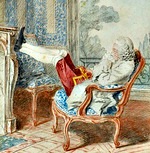
La nuit, la neige- Messages : 18132
Date d'inscription : 21/12/2013
 Re: La peinture sous et sur verre au 18e siècle, et la technique du verre églomisé
Re: La peinture sous et sur verre au 18e siècle, et la technique du verre églomisé
Encore un beau sujet, truffé d'explications techniques passionnantes ! Merci !!!
La nuit, la neige a écrit:En peinture sur verre inversé la technique est unique car l'œuvre est réalisée sur le dos du verre. Alors que sur une toile on esquisse la composition à grands traits pour ensuite exécuter les aplats de couleur pour terminer graduellement par les détails, en peinture sur verre inversé on procède à l'inverse.
C'est donc dire que l'artiste peintre sur verre commence par les finesses de l'œuvre pour terminer avec les fonds.
Ainsi jusqu'au moindre détail, le peintre doit imaginer dès le départ la version définitive de l'image à réaliser sachant bien qu'il devra aussi composer avec un « effet miroir » lors de l'exécution de l'image puisque ce qui est peint à l'envers à droite se trouve à l'endroit à gauche.
... épatant !!!
 remarquable !!!
remarquable !!! 
Cette peinture ne souffre pas le plus petit coup de pinceau malencontreux .
Quant à la technique du verre églomisé, nous l'avons déjà évoquée et expliquée au sujet de cette bague qu'Esterhazy fait tenir à Fersen de la part de Marie-Antoinette. Réversible, elle présente trois fleurs de lys sur une face et la devise "Lâche qui les abandonne" sur l'autre .
C'est ici :
https://marie-antoinette.forumactif.org/t3013-historiae-secrets-et-la-bague-dite-de-fersen?highlight=FERSEN
_________________
... demain est un autre jour .

Mme de Sabran- Messages : 55497
Date d'inscription : 21/12/2013
Localisation : l'Ouest sauvage
 Re: La peinture sous et sur verre au 18e siècle, et la technique du verre églomisé
Re: La peinture sous et sur verre au 18e siècle, et la technique du verre églomisé
Quelques "chinoiseries" ! 
Pour rappel, et en ce qui concerne en tous cas ce type de production, ces créations étaient exclusivement destinées aux marchés européens, amateurs de ce genre d'objets "exotiques".
Matériaux de base et techniques furent importés en Chine, où les artisans locaux réalisèrent ces "peintures" destinées à être exportées en Europe. Une fois arrivées dans le pays de destination, les oeuvres étaient agrémentées de bronze ou, plus précisément en ce qui concerne ce sujet, de cadre en bois doré dans le goût du temps.
 Commençons par un exemple élaboré selon la technique du verre églomisé (décrite ci-dessus), assez rare...
Commençons par un exemple élaboré selon la technique du verre églomisé (décrite ci-dessus), assez rare...

A rare pair of verre églomisé vermillion and gilt decorated wall appliques
Early 18th century
decorated with chinoiserie scenes, with brass candle-arms
77cm. high; 2ft. 6¼in.
Photo : Sotheby's

Photo : Sotheby's
Catalogue note :
These wall sconces feature the process for reverse-decorating glass with metal foil and paint which is thought to have derived its name from a French framer Jean-Baptiste Glomy (d. 1786) who rediscovered the technique in the late 18th century.
Although verre églomisé is typically associated with the borders of late 17th/early 18th century mirrors, this method of decoration was practised during the high renaissance (...)
Whilst the verre églomisé borders found on mirrors contemporary to the present lot are characterised by Berainesque influenced designs, the decoration here is more typical of the Chinoiserie motifs applied to English and continental japanned cabinets of the same period.
One of the principal design sources for japanning was John Stalker and George Parker's Treatise of Japanning, Varnishing and Guilding published in 1688 and the decoration on the appliqués here appear to be a rare example of the verre églomisé technique expressed in this style.
 Plus communes, ces autres oeuvres furent réalisées selon le même principe de "grattage et découpage" de la fine couche composant la surface arrière d'un miroir, permettant par la suite de peindre sous verre les décors et motifs choisis...
Plus communes, ces autres oeuvres furent réalisées selon le même principe de "grattage et découpage" de la fine couche composant la surface arrière d'un miroir, permettant par la suite de peindre sous verre les décors et motifs choisis...


Note au catalogue :
Although glass was widely used in ancient China, the technique of producing flat glass in China was not accomplished until the 19th Century. Even in the imperial glass workshops, set up Peking (Beijing) in 1696 under the supervision of the Jesuit Kilian Stumpf, window glass or mirrored glass was not successfully produced.
As a result, from the middle of the 18th century onwards, when reverse glass painting was already popular in Europe, sheets of both clear and mirrored glass were sent to Canton from Europe.
The practice of painting on mirrors developed in China after 1715 when the Jesuit missionary Father Castiglione arrived in Peking. He found favor with the Emperors Yang Cheng and Ch’ien Lung and was entrusted with the decoration of the Imperial Garden in Peking.
He learned to paint in oil on glass, a technique that was already practiced in Europe but which was unknown in China in the 17th century.
Chinese artists, who were already expert in painting and calligraphy, took up the practice of painting in oil on glass, tracing the outlines of their designs on the back of the mirror plate and, using a special steel implement, scraped away the mirror backing to reveal the glass that could then be painted.
The glass paintings were purely made for export, and initially depicted bucolic landscapes, frequently with Chinese figures at various leisurely pursuits.
The demand for such paintings was fueled by the mania in Europe for all things Chinese, and they were commonly placed in elaborate Chippendale or chinoiserie frames.

A Pair of Chinese Export Reverse Painted Mirrors
18th Century
Each of a river landscape, the foreground of one with a man and lady holding picked flowers with a sheep and lamb, the other with another couple admiring a painting album with a dog and a golden pheasant, in their original pierce carved giltwood Chippendale frames
overall 32" x 22.5" — 81.3 x 57.2 cm.
Image : Waddington’s Asian Art department
Note au catalogue (extrait) :
The popularity of European aesthetic and artistic techniques in the Chinese Imperial court was mirrored by the emergence of ‘Chinoiserie’ tastes in West. Glass and mirror paintings became a product of the two trends, where plates were painted with idyllic and exoticized scenes of the Far East using European painting techniques.
The operation was arduous; mirror plates were sent from Europe over to Chinese workshops, where they would strip sections of mercury and carefully paint designs on the reverse.
Once complete, the plates would be laboriously transported back to the West, further adding to their rarity and value.

Photo : Christie's
A chinese export reverse-glass mirror painting
Circa 1760
The rectangular plate depicting an elegant lady seated beneath a tree attended by a musician playing a flute and another standing figure with a basket of flowers, with a spaniel, deer and cock and hen golden pheasants at their feet and with distant buildings and mountains,
in a George III carved giltwood frame
35 x 37 in. (89 x 94 in.)
Note au catalogue (extrait) :
The technique for creating pictures on imported miror glass is thought to have been promoted by Father Guiseppe Castiglione (1688-1766) who reached Peking in 1715 and found favour with the Imperial rulers.
The process had already been used in Europe, a process termed verre églomisé, and Chinese artists adopted the method though Alvarez Semedo, a Portuguese living in China wrote that they had no knowlege of painting in oils and have 'more curiosities than perfection'.
The finished articles however were widely admired in European markets, and when sent back to Europe, enduring another hazardous sea voyage, they were quickly adopted along with Chinese porcelain, wallpaper, silks and lacquer in the most fashionable circles desirous of the exotic.

Miroir en verre églomisé à décor de chinoiseries
Fin du XVIIIe siècle
Peint en polychromie, représentant une scène de cour avec personnages ;
encadrement en bois doré Haut. avec cadre 82 cm, larg. 55,5 cm
Photo : Sotheby's

A Chinese-export Reverse Mirror Painting
Late 18th century
The bevelled plate depicting two pairs of pheasants on rocky outcrops among flowering plants, in a modern pierced giltwood frame with acanthus clasps
46½ x 31 in. (118 x 79 cm.)


Paire de miroirs en verre églomisé
Travail chinois réalisé pour le marché occidental, fin du XVIIIe siècle
Chaque miroir représentant une femme en costume traditionnel, avec des draperies et vases fleuris à l'arrière plan ; dans des cadres en bois doré de goût rocaille
Haut. 76 cm, larg. 38 cm
Photo : Sotheby's

A Chinese reverse-glass mirror painting
The mirror 18th century, the frame 19th century
The mirror painted with birds, one hanging from a branch, a hawk clutching a small bird in its claw, among flowering peonies and prunus branches, in a shaped giltwood frame, label to the rear 'John Sparks ltd, 128, Mount Street, W'
27 ¼ in. (69 cm.) high; 20 ¾ in. (53 cm.) wide



A pair of Chinese-export reverse mirror paintings
Qing Dynasty, Third quarter 18th Century
Each depicting figures in river landscapes with buildings beyond, within a George II-style giltwood frame,
one inscribed to the reverse '2' within a circle, the other inscribed to the reverse 'ODELL [?] '
27 in. (68.5 cm.) high, 33 in. (84 cm.) wide, each
Photo : Christie's
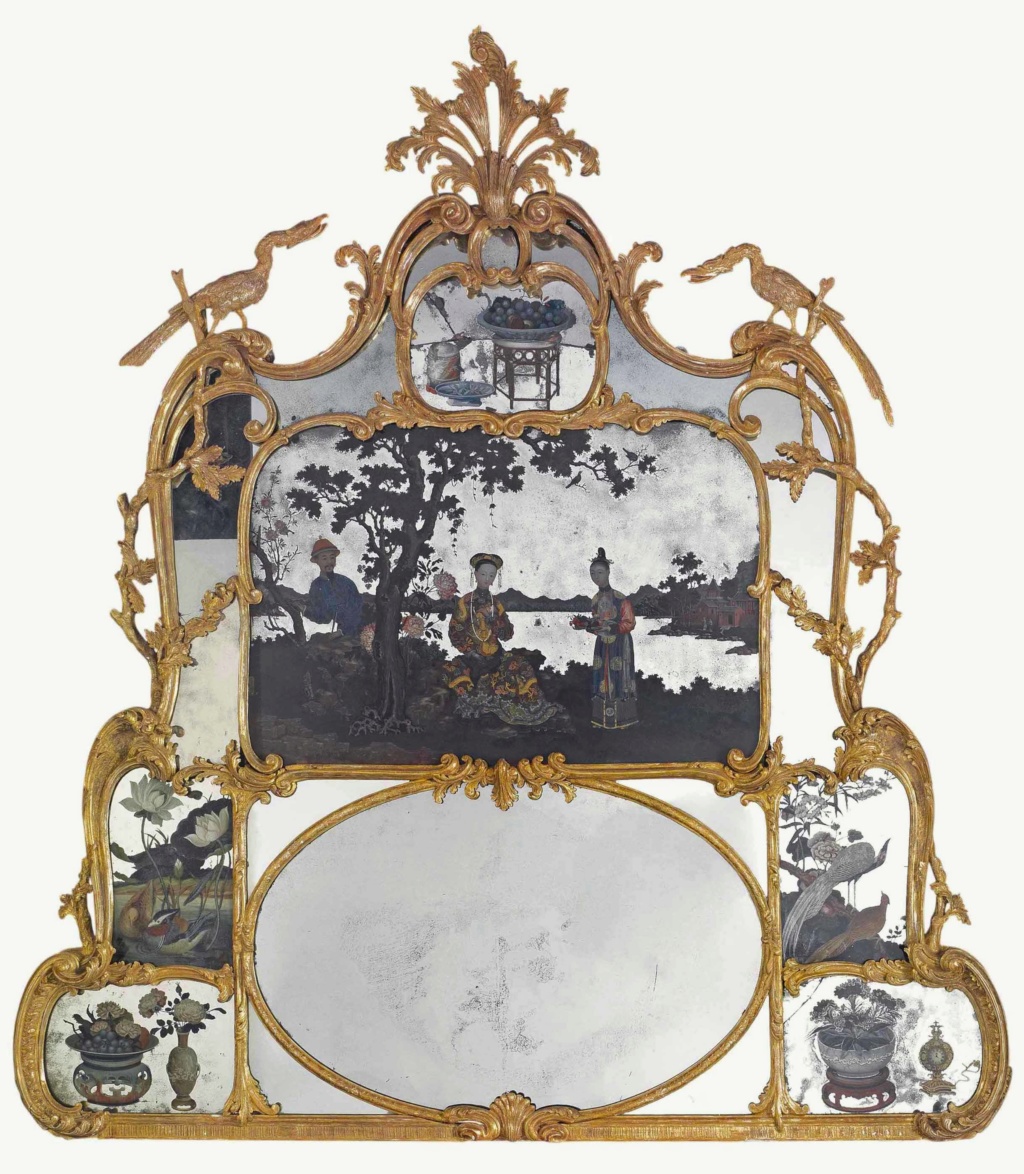
A George III Giltwood Overmantel Mirror with Chinese Export Mirror Paintings
Circa 1765
With pierced foliate cresting over a divided frame carved with scrolling foliage, leafy branches and a pair of ho-ho birds, with variously shaped plates, the upper central plate with a painting depicting a lady and her attendants within a river landscape, flanked by outer plates depicting still lives and large scale birds, restorations to the birds' heads and to the cresting, re-gilt
74¼ in. (188.5 cm.) high; 68 in. (173 cm.) wide
Note au catalogue (extrait) :
This exceptional mirror or 'chymney glass' is an accomplished amalgam of Chinese, rococo and classical design. Likely to have been supplied for a fashionable Chinese-style bedroom, the frame is beautifully conceived with deep fluid carving that effectively showcases the Chinese mirror paintings within.
The frame was undoubtedly made by one of London’s pre-eminent cabinet-makers such as Thomas Chippendale, John Linnell or the partnership of Samuel Norman and James Whittle. The mirror paintings were probably the patron's own (...).
Both the practice of painting on glass and the flat glass itself were introduced to China in the late 17th and early 18th centuries. China had a long history of producing utensils and decorative objects in glass. The glass workshop in the Forbidden city was established in 1696, but no flat glass was produced and when it was attempted it was reported that the manufacturers ‘do not know how to do manufacture it with the proper materials’ (Breton de la Martinière, China, its costume, art etc, translated 1813). However, visiting dignitaries had brought mirrors as gifts for the Emperor, such as a Dutch mission which in 1686 presented the Emperor K’ang-Hsi with a pair of large European mirrors, the quality of which was a revelation to the Chinese.
The practice of painting on mirrors developed in China after 1715 when the Jesuit missionary Father Castiglione arrived in Peking. He found favour with the Emperors Yang Cheng and Ch’ien Lung and was entrusted with the decoration of the Imperial Garden in Peking. He learnt to paint in oil on glass, a technique that was already practiced in Europe but which was unknown in China in the 17th century. Chinese artists, who were already expert in painting and calligraphy, took up the practice, tracing the outlines of their designs on the back of the mirror plate and, using a special steel implement, scraping away the mirror backing to reveal the glass that could then be painted. Common designs included still lives, birds and groups of figures, usually depicted against backgrounds of rivers or pavilions.
Many mirrors were brought back to Europe by the companies who routinely plied their trade in the far East, with some carried as ‘private trade’ by crew members (...).
The demand for such painting was fuelled by the mania in Europe for Chinese fashions, promoted by the likes of Sir William Chambers, whose Designs for Chinese Buildings, Furniture, Dresses, Machines and Utensils was issued in 1757, and which found expression in homes of the fashionable cognoscenti. Frederick, Prince of Wales (d. 1752) decorated his gallery in the state apartments with 'four large painted looking glasses from china' for the window-piers according to a description of William Kent’s work at Kew (Sir William Chambers' Plans, Elevations, etc. of the Gardens and Buildings at Kew, 1763, p. 2), while the Chinese Bedroom at Badminton House, Gloucestershire was fitted up for the 4th Duke of Beaufort by William Linnell in 1752-54.
* Source et infos complémentaires : Christie's

Rare pair of China Trade Reverse Glass Painted Mirror Pictures.
Made in Canton and Exported Exclusively for the English Upper Class.
Last Quarter of the 18th Century .
As is quite normal the finely carved wooden frames have been made in England at a later date to suit the individual taste of the purchasing client.
Image : Michael Lipitch - Fine Antique Furniture & Objects

A George III Giltwood Frame with a Chinese Mirror Painting
The frame: English, circa 1780
The mirror painting: Chinese, Qianlong, circa 1765
Height: 43 in; 109.5 cm - Width: 37 in; 94 cm
Image : Ronald Phillips - Fine Antique English Furniture
Je pense que vous avez compris le principe !
A suivre...

Pour rappel, et en ce qui concerne en tous cas ce type de production, ces créations étaient exclusivement destinées aux marchés européens, amateurs de ce genre d'objets "exotiques".
Matériaux de base et techniques furent importés en Chine, où les artisans locaux réalisèrent ces "peintures" destinées à être exportées en Europe. Une fois arrivées dans le pays de destination, les oeuvres étaient agrémentées de bronze ou, plus précisément en ce qui concerne ce sujet, de cadre en bois doré dans le goût du temps.

A rare pair of verre églomisé vermillion and gilt decorated wall appliques
Early 18th century
decorated with chinoiserie scenes, with brass candle-arms
77cm. high; 2ft. 6¼in.
Photo : Sotheby's

Photo : Sotheby's
Catalogue note :
These wall sconces feature the process for reverse-decorating glass with metal foil and paint which is thought to have derived its name from a French framer Jean-Baptiste Glomy (d. 1786) who rediscovered the technique in the late 18th century.
Although verre églomisé is typically associated with the borders of late 17th/early 18th century mirrors, this method of decoration was practised during the high renaissance (...)
Whilst the verre églomisé borders found on mirrors contemporary to the present lot are characterised by Berainesque influenced designs, the decoration here is more typical of the Chinoiserie motifs applied to English and continental japanned cabinets of the same period.
One of the principal design sources for japanning was John Stalker and George Parker's Treatise of Japanning, Varnishing and Guilding published in 1688 and the decoration on the appliqués here appear to be a rare example of the verre églomisé technique expressed in this style.


Note au catalogue :
Although glass was widely used in ancient China, the technique of producing flat glass in China was not accomplished until the 19th Century. Even in the imperial glass workshops, set up Peking (Beijing) in 1696 under the supervision of the Jesuit Kilian Stumpf, window glass or mirrored glass was not successfully produced.
As a result, from the middle of the 18th century onwards, when reverse glass painting was already popular in Europe, sheets of both clear and mirrored glass were sent to Canton from Europe.
The practice of painting on mirrors developed in China after 1715 when the Jesuit missionary Father Castiglione arrived in Peking. He found favor with the Emperors Yang Cheng and Ch’ien Lung and was entrusted with the decoration of the Imperial Garden in Peking.
He learned to paint in oil on glass, a technique that was already practiced in Europe but which was unknown in China in the 17th century.
Chinese artists, who were already expert in painting and calligraphy, took up the practice of painting in oil on glass, tracing the outlines of their designs on the back of the mirror plate and, using a special steel implement, scraped away the mirror backing to reveal the glass that could then be painted.
The glass paintings were purely made for export, and initially depicted bucolic landscapes, frequently with Chinese figures at various leisurely pursuits.
The demand for such paintings was fueled by the mania in Europe for all things Chinese, and they were commonly placed in elaborate Chippendale or chinoiserie frames.

A Pair of Chinese Export Reverse Painted Mirrors
18th Century
Each of a river landscape, the foreground of one with a man and lady holding picked flowers with a sheep and lamb, the other with another couple admiring a painting album with a dog and a golden pheasant, in their original pierce carved giltwood Chippendale frames
overall 32" x 22.5" — 81.3 x 57.2 cm.
Image : Waddington’s Asian Art department
Note au catalogue (extrait) :
The popularity of European aesthetic and artistic techniques in the Chinese Imperial court was mirrored by the emergence of ‘Chinoiserie’ tastes in West. Glass and mirror paintings became a product of the two trends, where plates were painted with idyllic and exoticized scenes of the Far East using European painting techniques.
The operation was arduous; mirror plates were sent from Europe over to Chinese workshops, where they would strip sections of mercury and carefully paint designs on the reverse.
Once complete, the plates would be laboriously transported back to the West, further adding to their rarity and value.

Photo : Christie's
A chinese export reverse-glass mirror painting
Circa 1760
The rectangular plate depicting an elegant lady seated beneath a tree attended by a musician playing a flute and another standing figure with a basket of flowers, with a spaniel, deer and cock and hen golden pheasants at their feet and with distant buildings and mountains,
in a George III carved giltwood frame
35 x 37 in. (89 x 94 in.)
Note au catalogue (extrait) :
The technique for creating pictures on imported miror glass is thought to have been promoted by Father Guiseppe Castiglione (1688-1766) who reached Peking in 1715 and found favour with the Imperial rulers.
The process had already been used in Europe, a process termed verre églomisé, and Chinese artists adopted the method though Alvarez Semedo, a Portuguese living in China wrote that they had no knowlege of painting in oils and have 'more curiosities than perfection'.
The finished articles however were widely admired in European markets, and when sent back to Europe, enduring another hazardous sea voyage, they were quickly adopted along with Chinese porcelain, wallpaper, silks and lacquer in the most fashionable circles desirous of the exotic.

Miroir en verre églomisé à décor de chinoiseries
Fin du XVIIIe siècle
Peint en polychromie, représentant une scène de cour avec personnages ;
encadrement en bois doré Haut. avec cadre 82 cm, larg. 55,5 cm
Photo : Sotheby's

A Chinese-export Reverse Mirror Painting
Late 18th century
The bevelled plate depicting two pairs of pheasants on rocky outcrops among flowering plants, in a modern pierced giltwood frame with acanthus clasps
46½ x 31 in. (118 x 79 cm.)


Paire de miroirs en verre églomisé
Travail chinois réalisé pour le marché occidental, fin du XVIIIe siècle
Chaque miroir représentant une femme en costume traditionnel, avec des draperies et vases fleuris à l'arrière plan ; dans des cadres en bois doré de goût rocaille
Haut. 76 cm, larg. 38 cm
Photo : Sotheby's

A Chinese reverse-glass mirror painting
The mirror 18th century, the frame 19th century
The mirror painted with birds, one hanging from a branch, a hawk clutching a small bird in its claw, among flowering peonies and prunus branches, in a shaped giltwood frame, label to the rear 'John Sparks ltd, 128, Mount Street, W'
27 ¼ in. (69 cm.) high; 20 ¾ in. (53 cm.) wide



A pair of Chinese-export reverse mirror paintings
Qing Dynasty, Third quarter 18th Century
Each depicting figures in river landscapes with buildings beyond, within a George II-style giltwood frame,
one inscribed to the reverse '2' within a circle, the other inscribed to the reverse 'ODELL [?] '
27 in. (68.5 cm.) high, 33 in. (84 cm.) wide, each
Photo : Christie's

A George III Giltwood Overmantel Mirror with Chinese Export Mirror Paintings
Circa 1765
With pierced foliate cresting over a divided frame carved with scrolling foliage, leafy branches and a pair of ho-ho birds, with variously shaped plates, the upper central plate with a painting depicting a lady and her attendants within a river landscape, flanked by outer plates depicting still lives and large scale birds, restorations to the birds' heads and to the cresting, re-gilt
74¼ in. (188.5 cm.) high; 68 in. (173 cm.) wide
Note au catalogue (extrait) :
This exceptional mirror or 'chymney glass' is an accomplished amalgam of Chinese, rococo and classical design. Likely to have been supplied for a fashionable Chinese-style bedroom, the frame is beautifully conceived with deep fluid carving that effectively showcases the Chinese mirror paintings within.
The frame was undoubtedly made by one of London’s pre-eminent cabinet-makers such as Thomas Chippendale, John Linnell or the partnership of Samuel Norman and James Whittle. The mirror paintings were probably the patron's own (...).
Both the practice of painting on glass and the flat glass itself were introduced to China in the late 17th and early 18th centuries. China had a long history of producing utensils and decorative objects in glass. The glass workshop in the Forbidden city was established in 1696, but no flat glass was produced and when it was attempted it was reported that the manufacturers ‘do not know how to do manufacture it with the proper materials’ (Breton de la Martinière, China, its costume, art etc, translated 1813). However, visiting dignitaries had brought mirrors as gifts for the Emperor, such as a Dutch mission which in 1686 presented the Emperor K’ang-Hsi with a pair of large European mirrors, the quality of which was a revelation to the Chinese.
The practice of painting on mirrors developed in China after 1715 when the Jesuit missionary Father Castiglione arrived in Peking. He found favour with the Emperors Yang Cheng and Ch’ien Lung and was entrusted with the decoration of the Imperial Garden in Peking. He learnt to paint in oil on glass, a technique that was already practiced in Europe but which was unknown in China in the 17th century. Chinese artists, who were already expert in painting and calligraphy, took up the practice, tracing the outlines of their designs on the back of the mirror plate and, using a special steel implement, scraping away the mirror backing to reveal the glass that could then be painted. Common designs included still lives, birds and groups of figures, usually depicted against backgrounds of rivers or pavilions.
Many mirrors were brought back to Europe by the companies who routinely plied their trade in the far East, with some carried as ‘private trade’ by crew members (...).
The demand for such painting was fuelled by the mania in Europe for Chinese fashions, promoted by the likes of Sir William Chambers, whose Designs for Chinese Buildings, Furniture, Dresses, Machines and Utensils was issued in 1757, and which found expression in homes of the fashionable cognoscenti. Frederick, Prince of Wales (d. 1752) decorated his gallery in the state apartments with 'four large painted looking glasses from china' for the window-piers according to a description of William Kent’s work at Kew (Sir William Chambers' Plans, Elevations, etc. of the Gardens and Buildings at Kew, 1763, p. 2), while the Chinese Bedroom at Badminton House, Gloucestershire was fitted up for the 4th Duke of Beaufort by William Linnell in 1752-54.
* Source et infos complémentaires : Christie's

Rare pair of China Trade Reverse Glass Painted Mirror Pictures.
Made in Canton and Exported Exclusively for the English Upper Class.
Last Quarter of the 18th Century .
As is quite normal the finely carved wooden frames have been made in England at a later date to suit the individual taste of the purchasing client.
Image : Michael Lipitch - Fine Antique Furniture & Objects

A George III Giltwood Frame with a Chinese Mirror Painting
The frame: English, circa 1780
The mirror painting: Chinese, Qianlong, circa 1765
Height: 43 in; 109.5 cm - Width: 37 in; 94 cm
Image : Ronald Phillips - Fine Antique English Furniture
Je pense que vous avez compris le principe !
A suivre...


La nuit, la neige- Messages : 18132
Date d'inscription : 21/12/2013
 Re: La peinture sous et sur verre au 18e siècle, et la technique du verre églomisé
Re: La peinture sous et sur verre au 18e siècle, et la technique du verre églomisé
Je n'ai pas encore présenté de "chinoiseries" reprenant les codes picturaux des oeuvres occidentales, car ce n'est pas ce que je préfère. 
Mais les artistes chinois n'hésitaient pas à reproduire les styles picturaux européens afin de réaliser des oeuvres dédiées à ce marché, et ainsi moins "exotiques".
Business first, il y en avait donc pour tous les goûts...
 Voici donc quelques exemples, cette fois-ci réalisés selon la technique de peinture directement "sous/sur verre" (voir explication dans mon message d'introduction), c'est à dire sans les miroirs "grattés" de type verre églomisé.
Voici donc quelques exemples, cette fois-ci réalisés selon la technique de peinture directement "sous/sur verre" (voir explication dans mon message d'introduction), c'est à dire sans les miroirs "grattés" de type verre églomisé.

A pair of Chinese export reverse-painted glass pictures
Late 18th Century
One depicting Anne Lady Lascelles (wife of Edward Lascelles, later 1st Earl of Harewood) in a landscape, the other depicting her daughter, Frances Lascelles with her dog, each in contemporary giltwood frames
24¼ x 18½ in. (62.2 x 47 cm.)
Catalogue Note (extraits) :
This fine pair of late 18th century portraits depict Anne Lady Harewood (1742/3- 1805) and her daughter Lady Francis Douglas, née Lascelles (1762-1817) with her dog. We have been able to identify the sitters for these two portraits with certainty from portraits of both sitters by Francis Cotes (1726-1770) surviving at Harewood House.
In the late 18th century acquiring a portrait of this kind was a novelty preserved for the extremely wealthy. A likeness would need to be created in England to then be exported to China along with the most expensive part of the object at that date, the glass; the likeness would then be copied in reverse to the back of the glass by the Chinese painter then to be returned to England.
By the time the portrait arrived back with the person who commissioned it, the costly, and extremely fragile glass would have completed a treacherous 10,000 mile round-trip, needless to say many such objects did not survive the trip.
The Lascelles family fortune was made from mercantile endeavour, and it would probably be through his contacts in that world that Lord Harewood would order these charming pictures of his wife and daughter.


Miniature Reverse Paintings
Anonymous
China, c. 1775-99
Images : The Corning Museum of Glass
Présentation :
During the reign of the Qing emperor Kangxi (1662–1722), Jesuit missionaries introduced European techniques of glassmaking and apparently of reverse painting on glass in China. Chinese craftsmen excelled to such a degree, that Chinese reverse paintings on glass often are misidentified as being French or English.
According to a contemporary source, most Chinese glass painters worked in Canton, which at the same time was the center of the trade with Europe.
Miniature portraits, often executed in lacquer on copper, were very popular during the late 18th century, and the glass medallions with two European ladies follow this fashion. The portraits are very delicate. They might have been executed after watercolor or pastel portraits, but it is possible they depict ladies who actually stayed in China.

The Foreign Factories (Hongs or Warehouses) of Canton
Anonymous
China, last quarter 18th century
Colorless glass, paint, wood
Image : The Corning Museum of Glass
The waterfront of the Pearl River in 18th-century Canton featured hongs (warehouses owned by foreigners) and dockyards.
The Danish flag on the far left is next to the French pre-Revolutionary flag. The imperial (Austrian), Swedish, British, and Dutch warehouses are shown at the right. Sampans and cargo boats for river trade fill the foreground.

Two Chinese Reverse Mirror Paintings, after Boucher and Eise
Anonymous
China, 18th Century
Oil on glass; gilt frame
Image : Kollenburg Antiquairs via Anticstore
Présentation (extraits) :
Reverse mirror paintings are very difficult to manufacture, because the image has to be applied in an unusual order. The details in the foreground are painted first and the background is added as the last step. Many of these reverse mirror paintings were made after illustrations and engravings of Boucher.
- L’Agréable Leçon
(...) The original is an oval shaped painting of Boucher of 1748 that was presented at the Paris Salon of the same year with exhibit number 19: ‘Un tableau ovale représentant un berger, qui montre à jouer de la flûte a sa bergère’. (an oval scene representing a shepherd who learns his shepherdess to play the flute).
On the Salon of 1750 it was part of item 24: ‘Quatre pastorale de forme ovale […] et la quatrième un berger qui montre à jouer de la flûte à sa bergère sous le même numéro.’(...)
- Le Mouton Favori
(...)The original of this painting by Charles-Dominique Eisen (1720-1778) has disappeared, but a rectangular engraving by R. Gaillard titled ‘Le Mouton Favori’ remained.

An Export Reverse-Glass Painting of Ladies
18th-19th Century
Painted within an oval with a European lady and a younger girl beneath a tall pine tree, with the girl holding up a string of flowers, all reserved on a black ground.
13 ¾ x 11 ¼ in. (34.5 x 28.5 cm.), gilt lacquered frame
Photo : Christie's

A set of four Chinese export oval reverse paintings on glass
Second-half 18th Century, the frames english, circa 1800
Each depicting courting couples, each inscribed on the reverse in pencil, 143, two pictures cracked
12 x 10¼ in. (30.5 x 26 cm.) overall, including frame
Image : Christie's
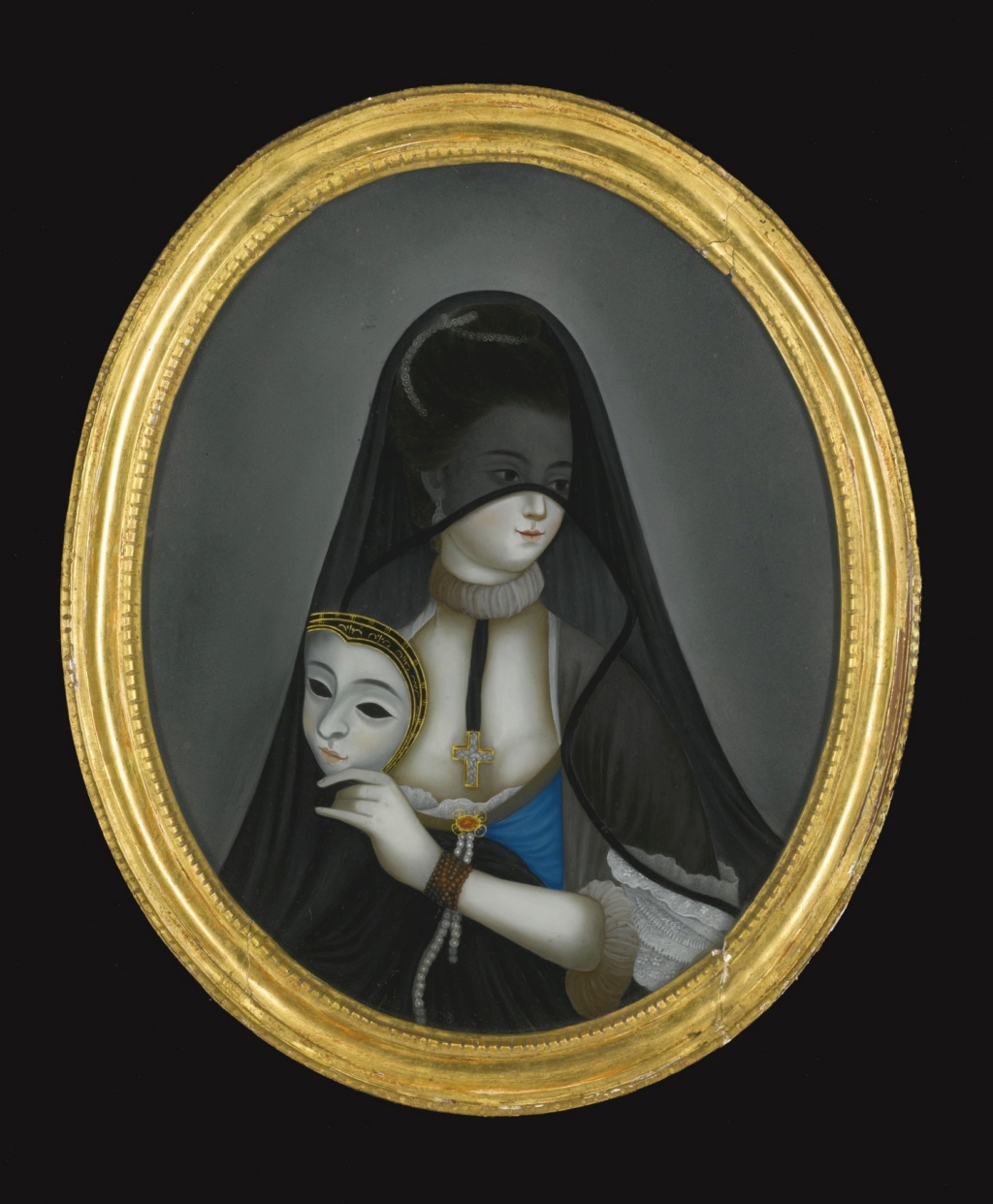
An Export Reverse Glass Painting of a Court Lady
Qing Dynasty, circa 1785
Oval shape, inspired by an engraving by Henry Moorland, delicately painted with a portrait of a lady with her left arm raised holding a mask, wearing an ornate dress embellished with jewels, her face half shielded by a translucent black veil, glazed with a gilt and lacquered frame
30cm., 11 3/4 in.
Image : Sotheby's
Voilà ! Vous avez compris le principe...
Quitte à faire dans la "chinoiserie", je préfère donc les sujets de "style chinois" à ces autres, "dans le goût" des modèles européens.
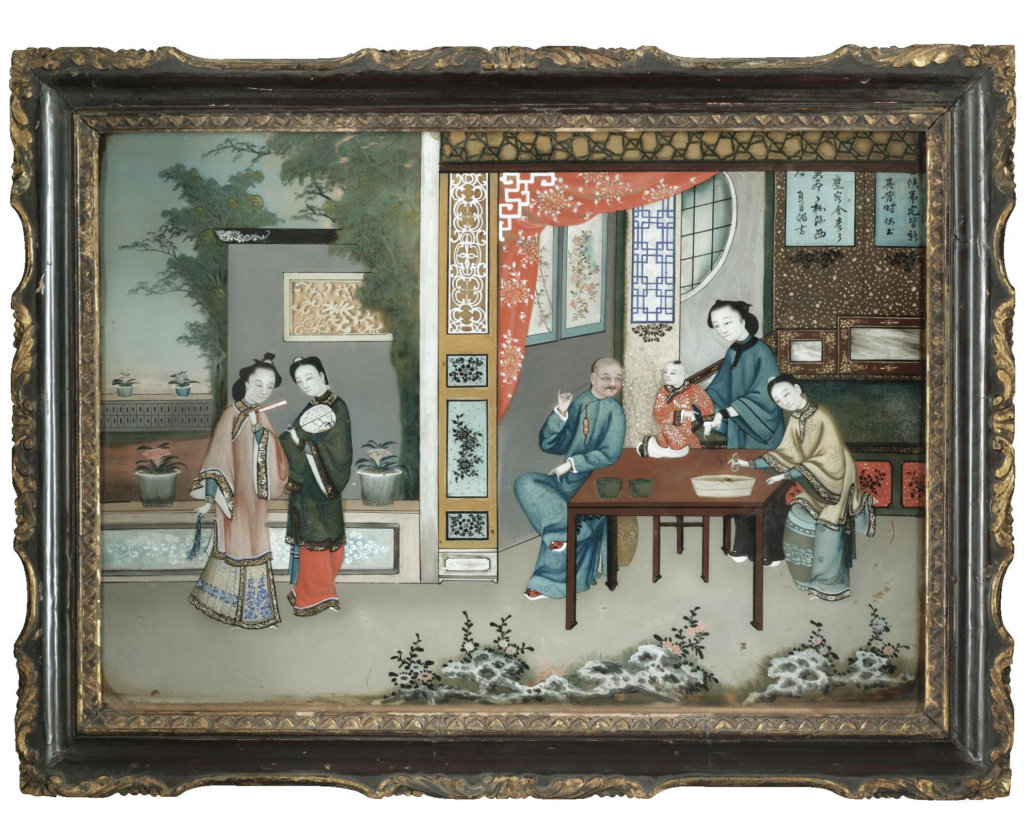
A Chinese Export Reverse Glass Painting of an Interior Scene
Qing Dynasty, 19th Century
finely painted with two elegant standing maidens looking at a group of people seated around a table,
contemporary Chinese carved and gilded wood frame
Photo : Sotheby's
 A noter que les Etats-Unis ne restèrent pas étrangers à ce commerce...
A noter que les Etats-Unis ne restèrent pas étrangers à ce commerce... 

Portrait of George Washington, after a portrait by Gilbert Stuar
Chinese artist, early nineteenth century (1800-1805).
Reverse painting on glass, 32 1/2 x 25 1/2 in. with frame (82.5 x 64.8 cm).
Peabody Essex Museum, Salem, Mass., gift of Mr. Howell N. White, 1970E78992
Image : Peabody Essex Museum. Photo by the Institute of Oriental Culture, University of Tokyo.

America, based on an engraving by Joseph Strutt
Chinese artist, about 1780.
Glass and paint, 17 1/2 x 23 3/8 in. (44.45 x 59.373 cm).
Peabody Essex Museum, Salem, Mass., museum purchase, 2001; AE85958 Peabody Essex Museum.
Photo : by Institute of Oriental Culture, University of Tokyo.
 Concernant les liens commerciaux entretenus entre les Etats-Unis et la Chine à partir de l'année 1784, et le commerce de ces "répliques" chinoises selon la technique en vogue de la peinture sous verre, lire cet intéressant article duquel proviennent ces deux illustrations :
Concernant les liens commerciaux entretenus entre les Etats-Unis et la Chine à partir de l'année 1784, et le commerce de ces "répliques" chinoises selon la technique en vogue de la peinture sous verre, lire cet intéressant article duquel proviennent ces deux illustrations :
 Washington in China - A Media History of Reverse Painting on Glass
Washington in China - A Media History of Reverse Painting on Glass
Mais les artistes chinois n'hésitaient pas à reproduire les styles picturaux européens afin de réaliser des oeuvres dédiées à ce marché, et ainsi moins "exotiques".
Business first, il y en avait donc pour tous les goûts...

A pair of Chinese export reverse-painted glass pictures
Late 18th Century
One depicting Anne Lady Lascelles (wife of Edward Lascelles, later 1st Earl of Harewood) in a landscape, the other depicting her daughter, Frances Lascelles with her dog, each in contemporary giltwood frames
24¼ x 18½ in. (62.2 x 47 cm.)
Catalogue Note (extraits) :
This fine pair of late 18th century portraits depict Anne Lady Harewood (1742/3- 1805) and her daughter Lady Francis Douglas, née Lascelles (1762-1817) with her dog. We have been able to identify the sitters for these two portraits with certainty from portraits of both sitters by Francis Cotes (1726-1770) surviving at Harewood House.
In the late 18th century acquiring a portrait of this kind was a novelty preserved for the extremely wealthy. A likeness would need to be created in England to then be exported to China along with the most expensive part of the object at that date, the glass; the likeness would then be copied in reverse to the back of the glass by the Chinese painter then to be returned to England.
By the time the portrait arrived back with the person who commissioned it, the costly, and extremely fragile glass would have completed a treacherous 10,000 mile round-trip, needless to say many such objects did not survive the trip.
The Lascelles family fortune was made from mercantile endeavour, and it would probably be through his contacts in that world that Lord Harewood would order these charming pictures of his wife and daughter.


Miniature Reverse Paintings
Anonymous
China, c. 1775-99
Images : The Corning Museum of Glass
Présentation :
During the reign of the Qing emperor Kangxi (1662–1722), Jesuit missionaries introduced European techniques of glassmaking and apparently of reverse painting on glass in China. Chinese craftsmen excelled to such a degree, that Chinese reverse paintings on glass often are misidentified as being French or English.
According to a contemporary source, most Chinese glass painters worked in Canton, which at the same time was the center of the trade with Europe.
Miniature portraits, often executed in lacquer on copper, were very popular during the late 18th century, and the glass medallions with two European ladies follow this fashion. The portraits are very delicate. They might have been executed after watercolor or pastel portraits, but it is possible they depict ladies who actually stayed in China.

The Foreign Factories (Hongs or Warehouses) of Canton
Anonymous
China, last quarter 18th century
Colorless glass, paint, wood
Image : The Corning Museum of Glass
The waterfront of the Pearl River in 18th-century Canton featured hongs (warehouses owned by foreigners) and dockyards.
The Danish flag on the far left is next to the French pre-Revolutionary flag. The imperial (Austrian), Swedish, British, and Dutch warehouses are shown at the right. Sampans and cargo boats for river trade fill the foreground.

Two Chinese Reverse Mirror Paintings, after Boucher and Eise
Anonymous
China, 18th Century
Oil on glass; gilt frame
Image : Kollenburg Antiquairs via Anticstore
Présentation (extraits) :
Reverse mirror paintings are very difficult to manufacture, because the image has to be applied in an unusual order. The details in the foreground are painted first and the background is added as the last step. Many of these reverse mirror paintings were made after illustrations and engravings of Boucher.
- L’Agréable Leçon
(...) The original is an oval shaped painting of Boucher of 1748 that was presented at the Paris Salon of the same year with exhibit number 19: ‘Un tableau ovale représentant un berger, qui montre à jouer de la flûte a sa bergère’. (an oval scene representing a shepherd who learns his shepherdess to play the flute).
On the Salon of 1750 it was part of item 24: ‘Quatre pastorale de forme ovale […] et la quatrième un berger qui montre à jouer de la flûte à sa bergère sous le même numéro.’(...)
- Le Mouton Favori
(...)The original of this painting by Charles-Dominique Eisen (1720-1778) has disappeared, but a rectangular engraving by R. Gaillard titled ‘Le Mouton Favori’ remained.

An Export Reverse-Glass Painting of Ladies
18th-19th Century
Painted within an oval with a European lady and a younger girl beneath a tall pine tree, with the girl holding up a string of flowers, all reserved on a black ground.
13 ¾ x 11 ¼ in. (34.5 x 28.5 cm.), gilt lacquered frame
Photo : Christie's

A set of four Chinese export oval reverse paintings on glass
Second-half 18th Century, the frames english, circa 1800
Each depicting courting couples, each inscribed on the reverse in pencil, 143, two pictures cracked
12 x 10¼ in. (30.5 x 26 cm.) overall, including frame
Image : Christie's

An Export Reverse Glass Painting of a Court Lady
Qing Dynasty, circa 1785
Oval shape, inspired by an engraving by Henry Moorland, delicately painted with a portrait of a lady with her left arm raised holding a mask, wearing an ornate dress embellished with jewels, her face half shielded by a translucent black veil, glazed with a gilt and lacquered frame
30cm., 11 3/4 in.
Image : Sotheby's
Voilà ! Vous avez compris le principe...

Quitte à faire dans la "chinoiserie", je préfère donc les sujets de "style chinois" à ces autres, "dans le goût" des modèles européens.

A Chinese Export Reverse Glass Painting of an Interior Scene
Qing Dynasty, 19th Century
finely painted with two elegant standing maidens looking at a group of people seated around a table,
contemporary Chinese carved and gilded wood frame
Photo : Sotheby's


Portrait of George Washington, after a portrait by Gilbert Stuar
Chinese artist, early nineteenth century (1800-1805).
Reverse painting on glass, 32 1/2 x 25 1/2 in. with frame (82.5 x 64.8 cm).
Peabody Essex Museum, Salem, Mass., gift of Mr. Howell N. White, 1970E78992
Image : Peabody Essex Museum. Photo by the Institute of Oriental Culture, University of Tokyo.

America, based on an engraving by Joseph Strutt
Chinese artist, about 1780.
Glass and paint, 17 1/2 x 23 3/8 in. (44.45 x 59.373 cm).
Peabody Essex Museum, Salem, Mass., museum purchase, 2001; AE85958 Peabody Essex Museum.
Photo : by Institute of Oriental Culture, University of Tokyo.

La nuit, la neige- Messages : 18132
Date d'inscription : 21/12/2013
 Re: La peinture sous et sur verre au 18e siècle, et la technique du verre églomisé
Re: La peinture sous et sur verre au 18e siècle, et la technique du verre églomisé
en 1989 j'ai transporté en bus deux cadres présentant le roi et la reine jeunes prêtés pour l'exposition à la mairie du V° arrondissement par la BARONNE ELIE, dans un simple grand sac en plastique BHV (j'en tremble encore !!!)
ces deux portraits étaient charmants, mais les personnages avaient les yeux bridé !!!!
MARIE ANTOINETTE
ces deux portraits étaient charmants, mais les personnages avaient les yeux bridé !!!!
MARIE ANTOINETTE

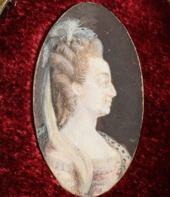
MARIE ANTOINETTE- Messages : 3729
Date d'inscription : 22/12/2013
Age : 78
Localisation : P A R I S

MARIE ANTOINETTE- Messages : 3729
Date d'inscription : 22/12/2013
Age : 78
Localisation : P A R I S
 Re: La peinture sous et sur verre au 18e siècle, et la technique du verre églomisé
Re: La peinture sous et sur verre au 18e siècle, et la technique du verre églomisé
Présentés prochainement en vente aux enchères, ces exemplaires de peintures sous verre illustrent deux styles appréciés par les acheteurs européens : des compositions " d'inspiration chinoise " et d'autres " à l'européenne ".

A CHINESE EXPORT REVERSE-PAINTED MIRROR
SECOND HALF 18TH CENTURY
The rectangular plate depicting a lady holding a feather fan, seated on rocks by a riverside, a boy seated beside her playing a pipe, and a man holding a bird to the left, with a village and mountains beyond, in chalk to the reverse 'S1229 Horlick', in a later japanned frame
21 ¾ in. (55 cm.) high; 29 ½ in. (75 cm.) wide

A CHINESE EXPORT REVERSE-PAINTED MIRROR
SECOND HALF 18TH CENTURY
The rectangular bevelled plate depicting a lakeside view with a bearded man seated beneath a tree and a lady holding a basket of flowers, with buildings and mountains beyond, in an 18th-century pierced and foliate-carved giltwood frame, altered to fit, re-gilt
32 ¼ in. (82 cm.) high; 46 ¾ in. (119 cm.) wide, including frame

A CHINESE EXPORT REVERSE-PAINTED MIRROR
LATE 18TH CENTURY
The rectangular plate depicting a seated woman holding a watch, beneath a floral garland, within a bead-and-reel and ribbon-carved giltwood frame with ribbon-tied cresting
23 ¼ in. (46 cm.) high; 16 in. (34.5 cm.) wide, overall

A CHINESE EXPORT REVERSE-MIRROR PAINTING
LATE 18TH/EARLY 19TH CENTURY
The rectangular plate depicting Clairon and Melpomene, Clairon seated with volumes by Corneille, Racine, Voltaire and Crebillon beside her, Pegasus and a tempietto beyond, in a painted border simulating a frame, with ribbon-tied laurel garland, inscribed 'PROPHETIE ACOMPLIE.', the lower edge inscribed 'J'ai prédit que CLAIRON illustreroit la Scene Et mon espoire n'a pomtété decu: Ella a couronné Melpomene, Melpomene lui rend cequelle en a recu. GARRICK.', enclosed by a border of trailing flowers, in a 19th century giltwood frame
14 in. (35.5 cm.) high; 11 ¾ in. (30 cm.) wide
* Source et infos complémentaires : Christie's Londres - Vente du 23 juillet 2020

A CHINESE EXPORT REVERSE-PAINTED MIRROR
SECOND HALF 18TH CENTURY
The rectangular plate depicting a lady holding a feather fan, seated on rocks by a riverside, a boy seated beside her playing a pipe, and a man holding a bird to the left, with a village and mountains beyond, in chalk to the reverse 'S1229 Horlick', in a later japanned frame
21 ¾ in. (55 cm.) high; 29 ½ in. (75 cm.) wide

A CHINESE EXPORT REVERSE-PAINTED MIRROR
SECOND HALF 18TH CENTURY
The rectangular bevelled plate depicting a lakeside view with a bearded man seated beneath a tree and a lady holding a basket of flowers, with buildings and mountains beyond, in an 18th-century pierced and foliate-carved giltwood frame, altered to fit, re-gilt
32 ¼ in. (82 cm.) high; 46 ¾ in. (119 cm.) wide, including frame

A CHINESE EXPORT REVERSE-PAINTED MIRROR
LATE 18TH CENTURY
The rectangular plate depicting a seated woman holding a watch, beneath a floral garland, within a bead-and-reel and ribbon-carved giltwood frame with ribbon-tied cresting
23 ¼ in. (46 cm.) high; 16 in. (34.5 cm.) wide, overall

A CHINESE EXPORT REVERSE-MIRROR PAINTING
LATE 18TH/EARLY 19TH CENTURY
The rectangular plate depicting Clairon and Melpomene, Clairon seated with volumes by Corneille, Racine, Voltaire and Crebillon beside her, Pegasus and a tempietto beyond, in a painted border simulating a frame, with ribbon-tied laurel garland, inscribed 'PROPHETIE ACOMPLIE.', the lower edge inscribed 'J'ai prédit que CLAIRON illustreroit la Scene Et mon espoire n'a pomtété decu: Ella a couronné Melpomene, Melpomene lui rend cequelle en a recu. GARRICK.', enclosed by a border of trailing flowers, in a 19th century giltwood frame
14 in. (35.5 cm.) high; 11 ¾ in. (30 cm.) wide
* Source et infos complémentaires : Christie's Londres - Vente du 23 juillet 2020

La nuit, la neige- Messages : 18132
Date d'inscription : 21/12/2013
 Re: La peinture sous et sur verre au 18e siècle, et la technique du verre églomisé
Re: La peinture sous et sur verre au 18e siècle, et la technique du verre églomisé
Superbe, merci pour cette belle présentation.

Lucius- Messages : 11656
Date d'inscription : 21/12/2013
Age : 33
 Fixés sous verre illustrant la fin de la monarchie française
Fixés sous verre illustrant la fin de la monarchie française
Voici un rare ensemble de " fixés sous verre " illustrant des événements de la Révolution. Nous les connaissons plutôt sous la forme d'estampes ou de dessins. 
Cet ensemble sera prochainement présenté en vente aux enchères. Je cite des extraits de la présentation (et zappe les cadres sur la plupart des images).
EXCEPTIONNEL ENSEMBLE DE DOUZE FIXES SOUS VERRE REPRESENTANT LES DIFFERENTES ETAPES DE LA FIN DE LA MONARCHIE FRANCAISE
1.Arrestation de Louis XVI à varennes (le 22 juin 1791)
2. Retour de varennes arrivée de Louis XVI à Paris le 25 juin 1791
3. La Séparation de Louis XVI et de sa Famille le 29 Septembre 1792. (Il y a eu à l'époque interversion des bandes-titres n° 3 et 11)
4. La 2e Séparation ou dernier Adieu du Roy d'avec sa Famille désolée le 20 Janvier 1793
5. La Dernier Entrevue de Louis XVI avec sa Famille la veille de son Exécution le 20 janvier 1793
6. Le dernier Moment de la vie du Roi Louis XVI le 21 Janvier 1793 Très bel état.
7. Le Dauphin enlevé à sa Mère le 1 Juillet 1793
8. La Reine Marie-Antoinette conduite publiquement ou supplice dans un Tombereau Le 16 Octobre 1793
9. Madame Anne Elisabet Soeur de Louis XVI Condamne au Supplice le 10 May 1794
10. Le dernier Supplice de Madame Elisabet Soeur du Louis XVI le 10 May 1794
11. La Princesse Marie Thérèse Carlotte Fille de Louis XVI part de Paris pour se Rendre en Suisse le 19 Xbre 1795 (Il y a eu à l'époque interversion des bandes-titres n° 3 et 11)
12. Le départ pour Vienne de la Princesse Marie Térèse Charlotte Fille du Roy Louis XVI


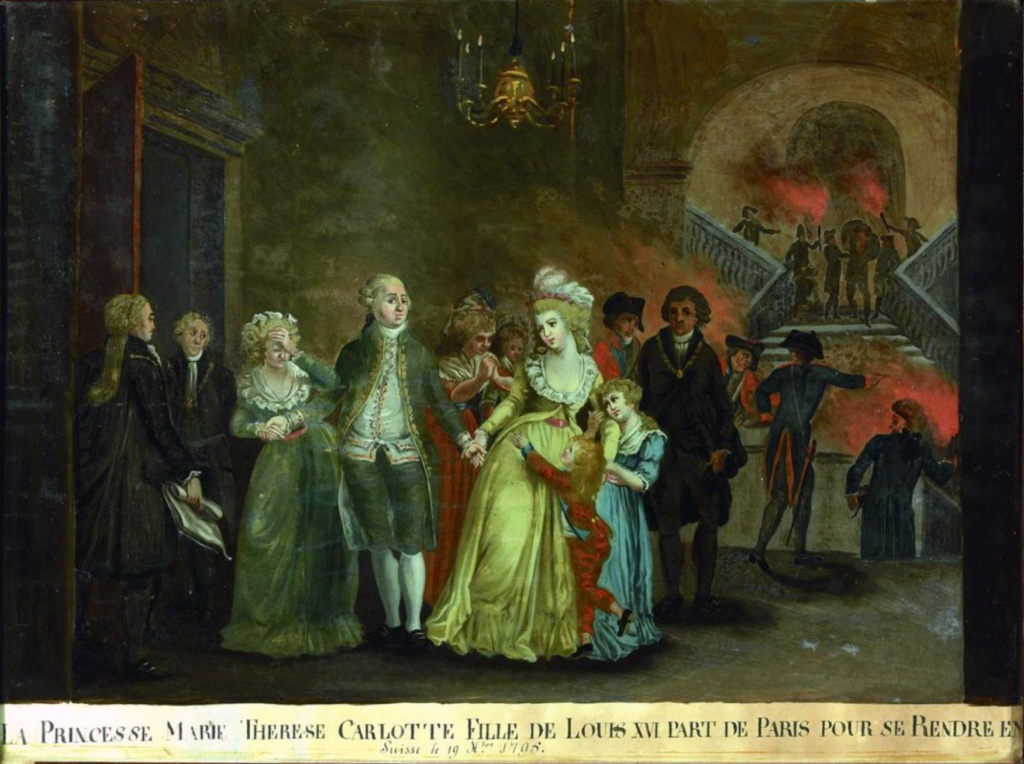

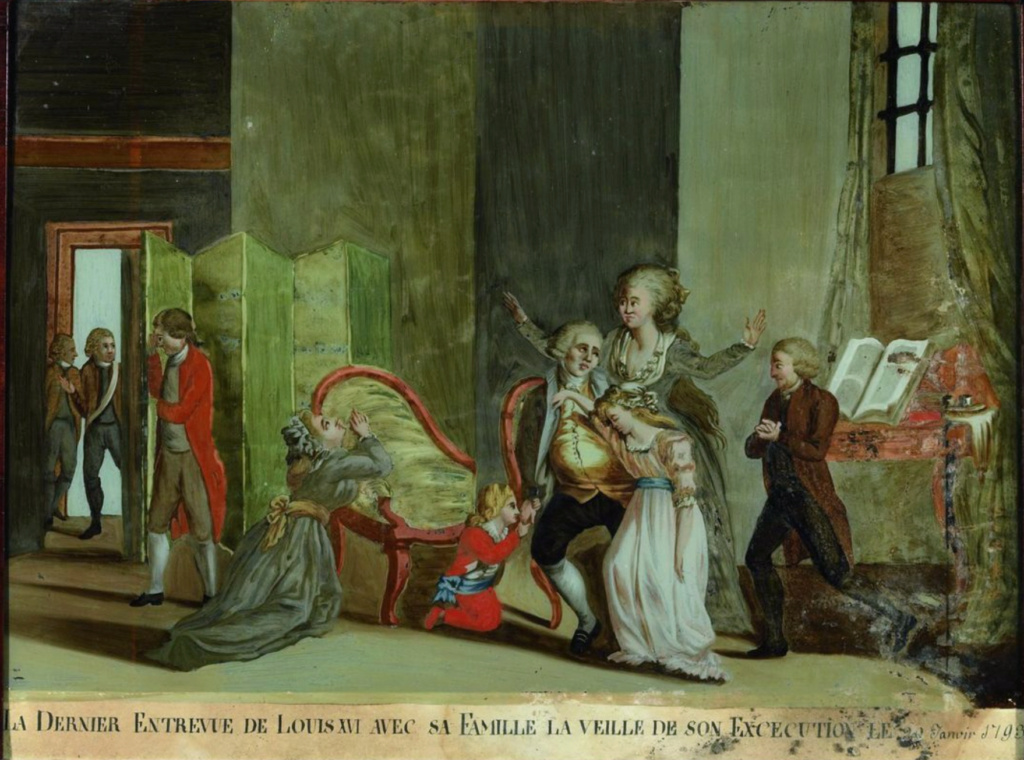
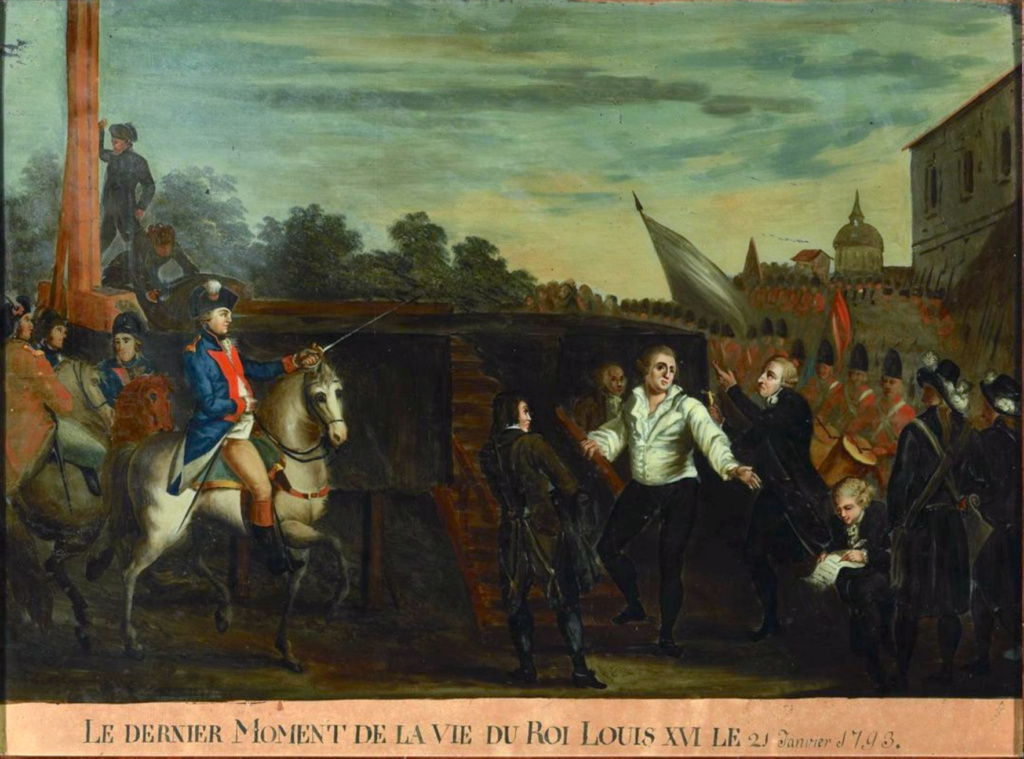
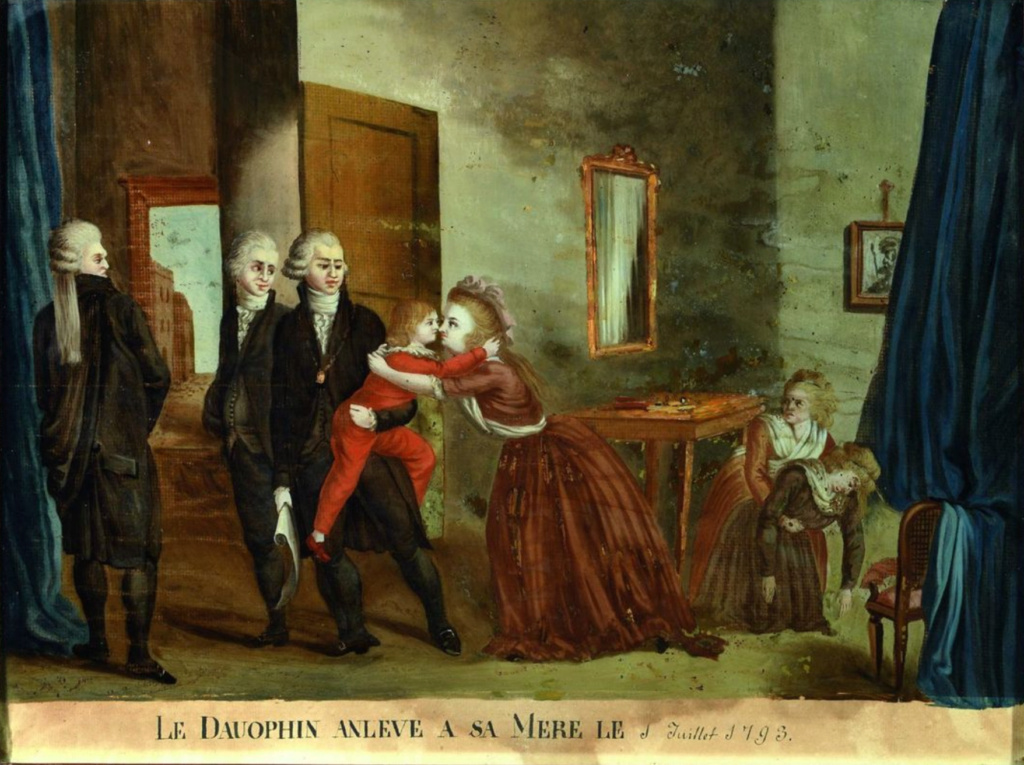

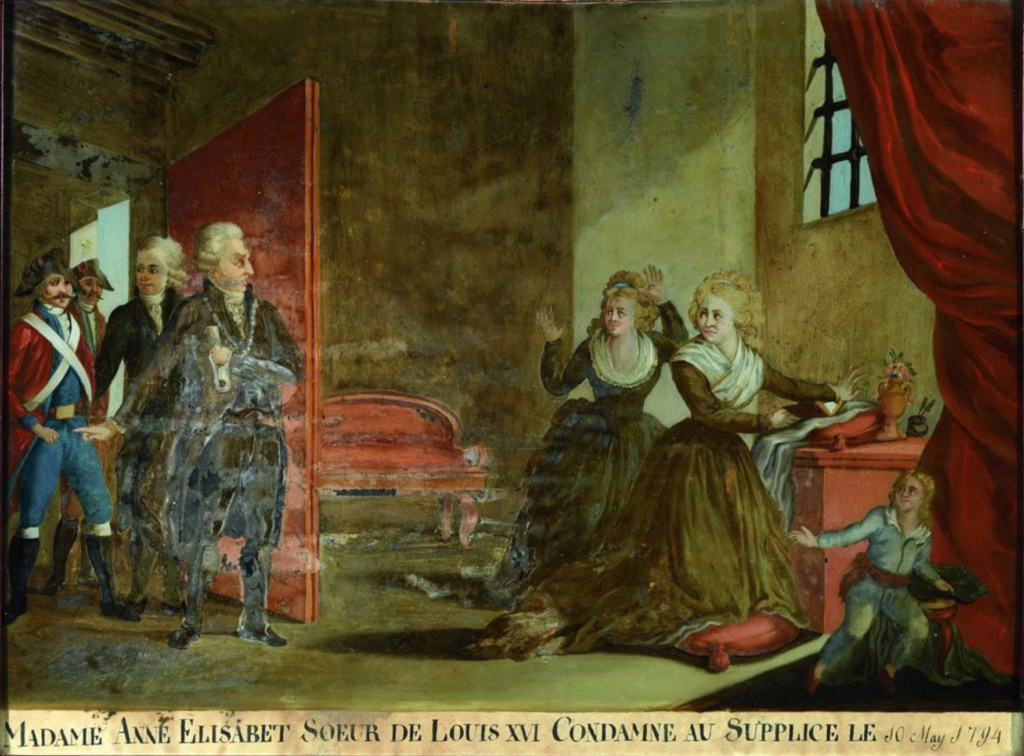

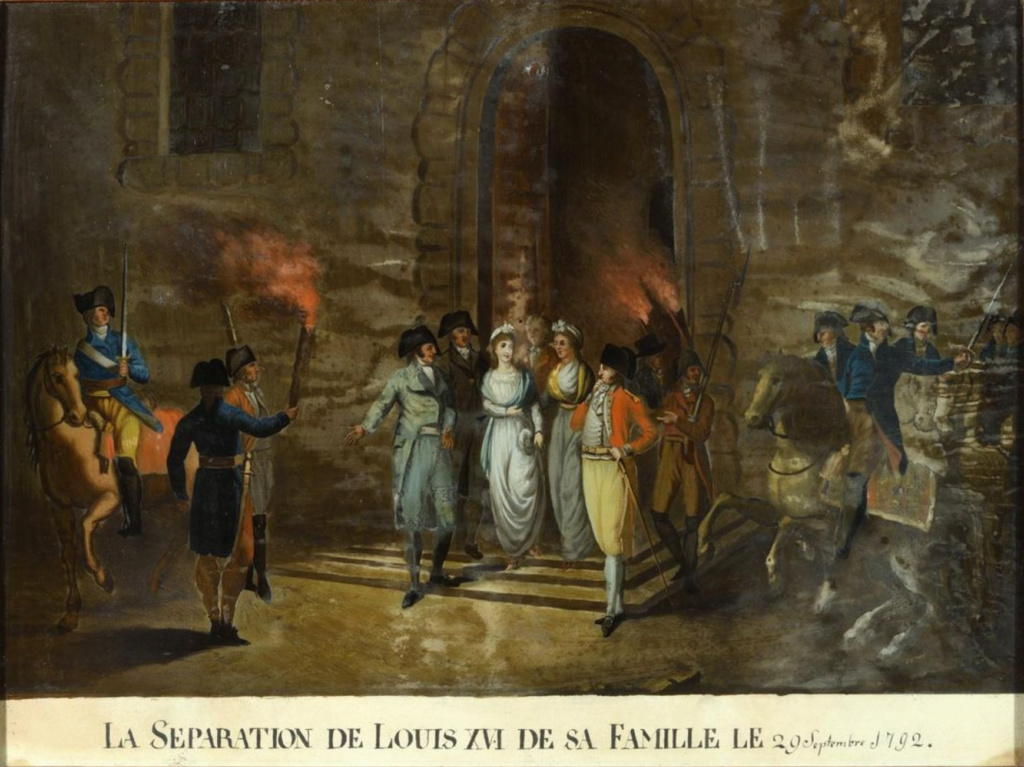

Description au catalogue :
La difficile technique de la peinture sous verre est ici parfaitement maîtrisée, les légendes ont été rédigées à part sur des bandes de papier fixées en-dessous, dont nous avons scrupuleusement respecté le graphisme et la rédaction. Celles-ci sont presque toujours identiques aux titres des gravures. (Il y a eu à l'époque interversion des bandes-titres n° 3 et 11).

Ces tragiques évènements ont inspiré de nombreux artistes, parmi lesquels Jean-Louis PRIEUR (1759-1795) auteur de plusieurs dessins à la mine de plomb conservés au Musée Carnavalet, et Charles BENAZECH (1767-1794) pour trois tableaux, dont deux sont conservés au Château de Versailles, lesquels ont été repris en gravure par plusieurs artistes.
Nous avons retrouvé les oeuvres reproduites par notre peintre, il semble évident qu'il a eu sous les yeux toute la série de gravures (les sujets sont inversés par rapport aux originaux : l'artiste copie ce qu'il voit, et le sujet apparaît une fois le verre retourné) :
1. Dessin de Prieur au Musée Carnavalet, nombreuses copies en gravures. Notre artiste n'a retenu que les personnages centraux.
2. Dessin de Prieur au Musée Carnavalet, nombreuses copies en gravures. Notre artiste est resté très proche de l'original.
3. Gravure de Jean Auvril d'après le tableau de Charles Benazech.
4. Reprend très exactement le tableau de Charles Benazech. Gravure de C. Siliano.
5. Reprend très exactement le tableau de Charles Benazech, (au château de Versailles).
6. Reprend très exactement le tableau de Charles Benazech, (au château de Versailles).
7. Dessin de Domenico Pellegrini, gravure de Carlo Lasinio.
8. Dessin d'Aloisin, gravure de C Siliano.
9. Dessin de Domenico Pellegrini, gravure de Carlo Lasinio.
10. Dessin de Domenico Pellegrini, gravure de Carlo Lasinio.
11. Dessin d'Antoine Deif, gravure de Carlo Lasinio.
12. Dessin d'Antoine Deif, gravure de Carlo Lasinio.
Historique (extraits) :
L'histoire de cet ensemble de fixés sous-verres est aussi incroyable qu'étonnante. Très probablement arrivés dans son équipage lors de l'exil de Marie-Adelaïde de Bourbon, duchesse d'Orléans, accompagnée de son fils, le futur Louis-Philippe Ier, roi des Français, et de Jacques-Marie Rouzet, dont elle était la maîtresse, en décembre 1808.
accompagnée de son fils, le futur Louis-Philippe Ier, roi des Français, et de Jacques-Marie Rouzet, dont elle était la maîtresse, en décembre 1808.
Ils sont restés dans la même famille et n'ont jamais quitté l'île de Minorque depuis plus de deux siècles. Nos douze peintures ont été conservées dans la finca Torre del Rey, propriété de la famille Orfila, à Es Castell. Cette finca fut achetée le 5 mars 1783 au comte de Cifuentes qui était le représentant du Roi d'Espagne à Minorque. Ce domaine fut érigé sur les terrains de l'ancien château de San Felipe, forteresse bâtie au XVIe siècle pour défendre Mahon, la capitale de l'île.
En 1889 les 6 derniers héritiers achetèrent une maison dans Mahon où ils résidèrent tout en gardant la finca entièrement meublée.
(...)
Jamais exposés au public, jamais présentés à la vente, ils sont restés à Minorque jusqu’à ce que nous les découvrions l’année dernière, et reviennent pour la première fois en France.
* Source, descriptif complet, et informations complémentaires : Magin Wedry, Paris - Vente du 9 juillet 2021
Cet ensemble sera prochainement présenté en vente aux enchères. Je cite des extraits de la présentation (et zappe les cadres sur la plupart des images).
EXCEPTIONNEL ENSEMBLE DE DOUZE FIXES SOUS VERRE REPRESENTANT LES DIFFERENTES ETAPES DE LA FIN DE LA MONARCHIE FRANCAISE
1.Arrestation de Louis XVI à varennes (le 22 juin 1791)
2. Retour de varennes arrivée de Louis XVI à Paris le 25 juin 1791
3. La Séparation de Louis XVI et de sa Famille le 29 Septembre 1792. (Il y a eu à l'époque interversion des bandes-titres n° 3 et 11)
4. La 2e Séparation ou dernier Adieu du Roy d'avec sa Famille désolée le 20 Janvier 1793
5. La Dernier Entrevue de Louis XVI avec sa Famille la veille de son Exécution le 20 janvier 1793
6. Le dernier Moment de la vie du Roi Louis XVI le 21 Janvier 1793 Très bel état.
7. Le Dauphin enlevé à sa Mère le 1 Juillet 1793
8. La Reine Marie-Antoinette conduite publiquement ou supplice dans un Tombereau Le 16 Octobre 1793
9. Madame Anne Elisabet Soeur de Louis XVI Condamne au Supplice le 10 May 1794
10. Le dernier Supplice de Madame Elisabet Soeur du Louis XVI le 10 May 1794
11. La Princesse Marie Thérèse Carlotte Fille de Louis XVI part de Paris pour se Rendre en Suisse le 19 Xbre 1795 (Il y a eu à l'époque interversion des bandes-titres n° 3 et 11)
12. Le départ pour Vienne de la Princesse Marie Térèse Charlotte Fille du Roy Louis XVI












Description au catalogue :
La difficile technique de la peinture sous verre est ici parfaitement maîtrisée, les légendes ont été rédigées à part sur des bandes de papier fixées en-dessous, dont nous avons scrupuleusement respecté le graphisme et la rédaction. Celles-ci sont presque toujours identiques aux titres des gravures. (Il y a eu à l'époque interversion des bandes-titres n° 3 et 11).

Ces tragiques évènements ont inspiré de nombreux artistes, parmi lesquels Jean-Louis PRIEUR (1759-1795) auteur de plusieurs dessins à la mine de plomb conservés au Musée Carnavalet, et Charles BENAZECH (1767-1794) pour trois tableaux, dont deux sont conservés au Château de Versailles, lesquels ont été repris en gravure par plusieurs artistes.
Nous avons retrouvé les oeuvres reproduites par notre peintre, il semble évident qu'il a eu sous les yeux toute la série de gravures (les sujets sont inversés par rapport aux originaux : l'artiste copie ce qu'il voit, et le sujet apparaît une fois le verre retourné) :
1. Dessin de Prieur au Musée Carnavalet, nombreuses copies en gravures. Notre artiste n'a retenu que les personnages centraux.
2. Dessin de Prieur au Musée Carnavalet, nombreuses copies en gravures. Notre artiste est resté très proche de l'original.
3. Gravure de Jean Auvril d'après le tableau de Charles Benazech.
4. Reprend très exactement le tableau de Charles Benazech. Gravure de C. Siliano.
5. Reprend très exactement le tableau de Charles Benazech, (au château de Versailles).
6. Reprend très exactement le tableau de Charles Benazech, (au château de Versailles).
7. Dessin de Domenico Pellegrini, gravure de Carlo Lasinio.
8. Dessin d'Aloisin, gravure de C Siliano.
9. Dessin de Domenico Pellegrini, gravure de Carlo Lasinio.
10. Dessin de Domenico Pellegrini, gravure de Carlo Lasinio.
11. Dessin d'Antoine Deif, gravure de Carlo Lasinio.
12. Dessin d'Antoine Deif, gravure de Carlo Lasinio.
Historique (extraits) :
L'histoire de cet ensemble de fixés sous-verres est aussi incroyable qu'étonnante. Très probablement arrivés dans son équipage lors de l'exil de Marie-Adelaïde de Bourbon, duchesse d'Orléans,
Ils sont restés dans la même famille et n'ont jamais quitté l'île de Minorque depuis plus de deux siècles. Nos douze peintures ont été conservées dans la finca Torre del Rey, propriété de la famille Orfila, à Es Castell. Cette finca fut achetée le 5 mars 1783 au comte de Cifuentes qui était le représentant du Roi d'Espagne à Minorque. Ce domaine fut érigé sur les terrains de l'ancien château de San Felipe, forteresse bâtie au XVIe siècle pour défendre Mahon, la capitale de l'île.
En 1889 les 6 derniers héritiers achetèrent une maison dans Mahon où ils résidèrent tout en gardant la finca entièrement meublée.
(...)
Jamais exposés au public, jamais présentés à la vente, ils sont restés à Minorque jusqu’à ce que nous les découvrions l’année dernière, et reviennent pour la première fois en France.
* Source, descriptif complet, et informations complémentaires : Magin Wedry, Paris - Vente du 9 juillet 2021

La nuit, la neige- Messages : 18132
Date d'inscription : 21/12/2013
 Re: La peinture sous et sur verre au 18e siècle, et la technique du verre églomisé
Re: La peinture sous et sur verre au 18e siècle, et la technique du verre églomisé
C'est un bel exemplaire de miroir décoré de peintures sous verre importées de Chine qui sera prochainement présenté en vente aux enchères :
A GEORGE II GILTWOOD OVERMANTEL MIRROR INSET WITH CHINESE EXPORT REVERSE MIRROR PAINTINGS
CIRCA 1760
The shaped plates within a gilt foliate scroll frame, the outer panels decorated with scenes of landscapes, colorfully plumed birds, flora and fauna
58 in. (147.5 cm.) high, 73 in. (185.5 cm.) wide
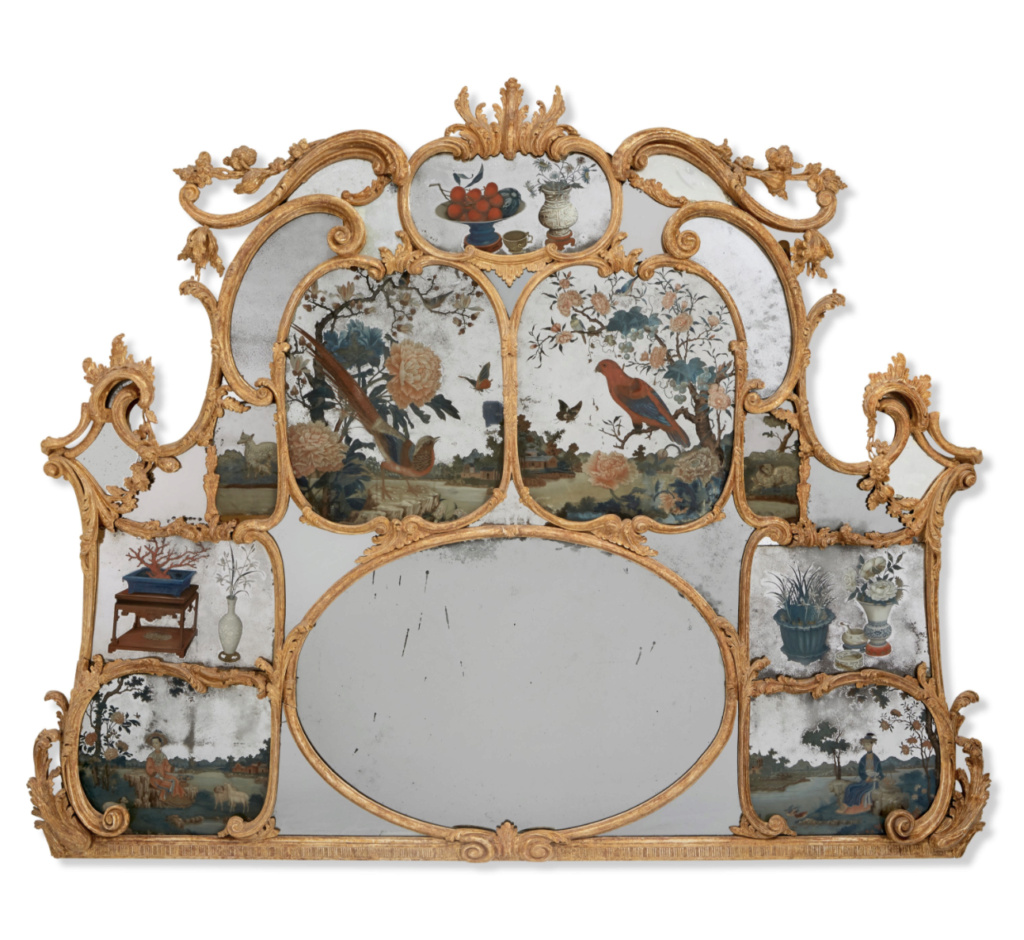
Lot Essay
This monumental mirror is remarkable not only for its unusually large scale but equally for its elaborate scene painting within a beautifully drawn giltwood frame. The frame follows the designs of London's pre-eminent cabinet-makers such as John Linnell or Thomas Chippendale. The pairing of reverse painted mirror glass with flat glass represents the ingenuity and collaboration between Chinese and British artists of the mid-18th century.
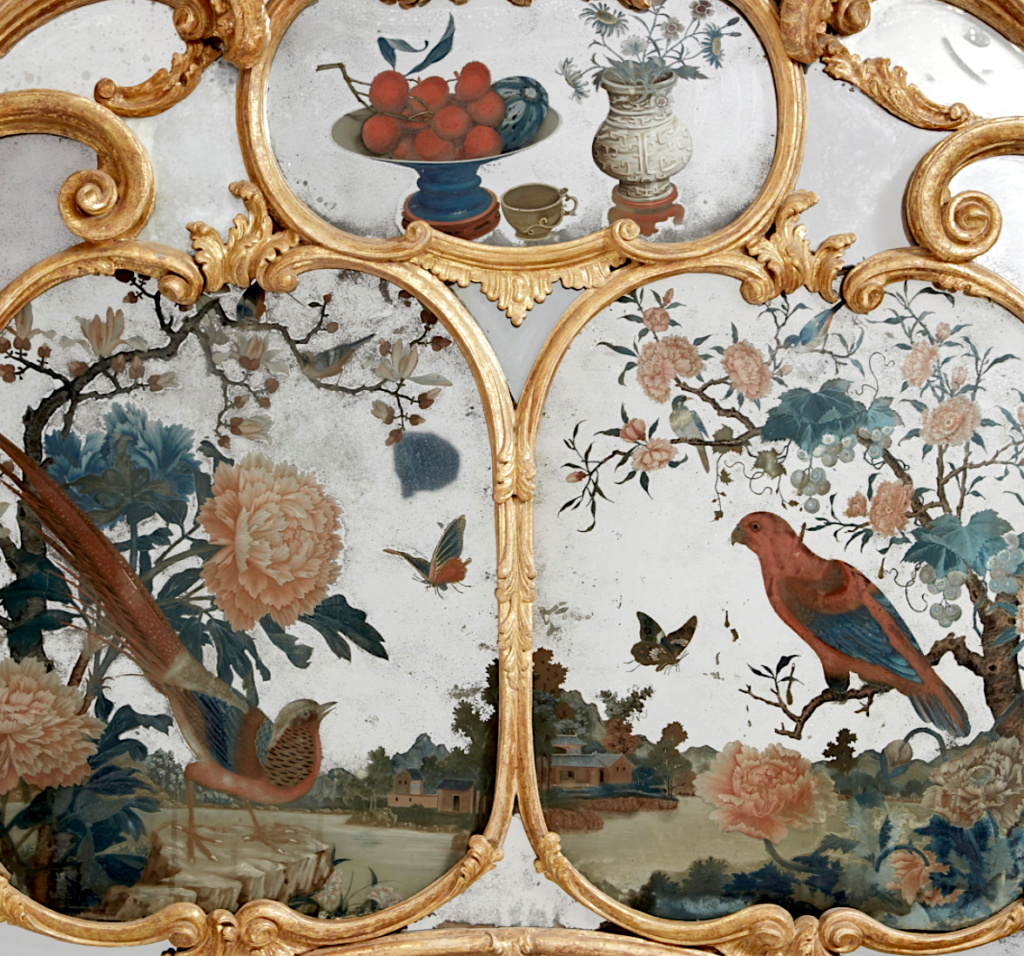
THE ART OF CHINESE MIRROR PAINTING
The practice of painting on mirrors developed in China after 1715 when the Jesuit missionary Father Castiglione arrived in Beijing. He found favor with the Emperors Yongzheng and Qianlong and was entrusted with the decoration of the Imperial Garden in Beijing. He learned to paint in oil on glass, a technique that was already practiced in Europe but which was unknown in China in 1715.
Chinese artists, already expert in painting and calligraphy, took up the practice, tracing the outlines of their designs on the back of the plate and, using a special steel implement, scraping away the mirror backing to reveal glass that could then be painted.

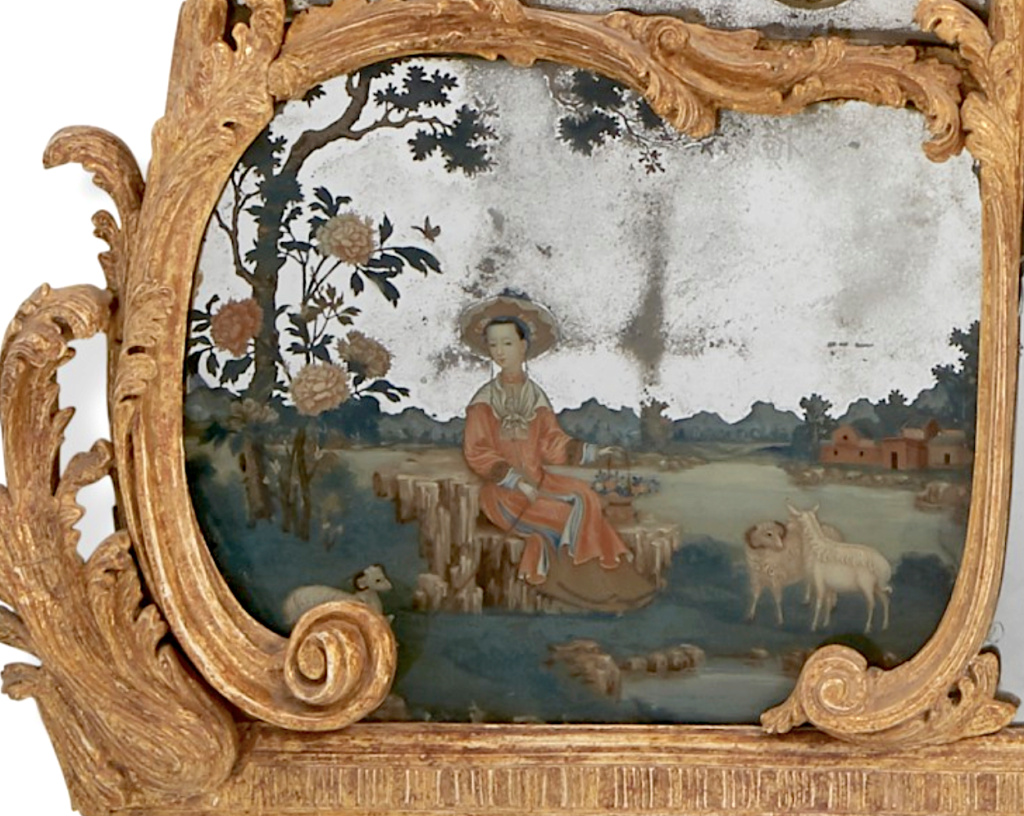
Glass paintings were made almost entirely for export, fueled by the mania in Europe for all things Chinese. Although glass vessels had long been made in China, the production of flat glass was not accomplished until the 19th century. Even in the Imperial glass workshops, set up in Beijing in 1696 under the supervision of the Bavarian Jesuit Kilian Stumpf, window glass or mirrored glass was not successfully produced. As a result, from the middle of the 18th century onwards, when reverse glass painting was already popular in Europe, sheets of both clear and mirrored glass were sent to Canton from Europe. They most often depicted bucolic landscapes, frequently with sumptuously dressed Chinese figures at leisurely pursuits. Once in Europe the best were often placed in elaborate giltwood Chippendale or Chinoiserie frames.
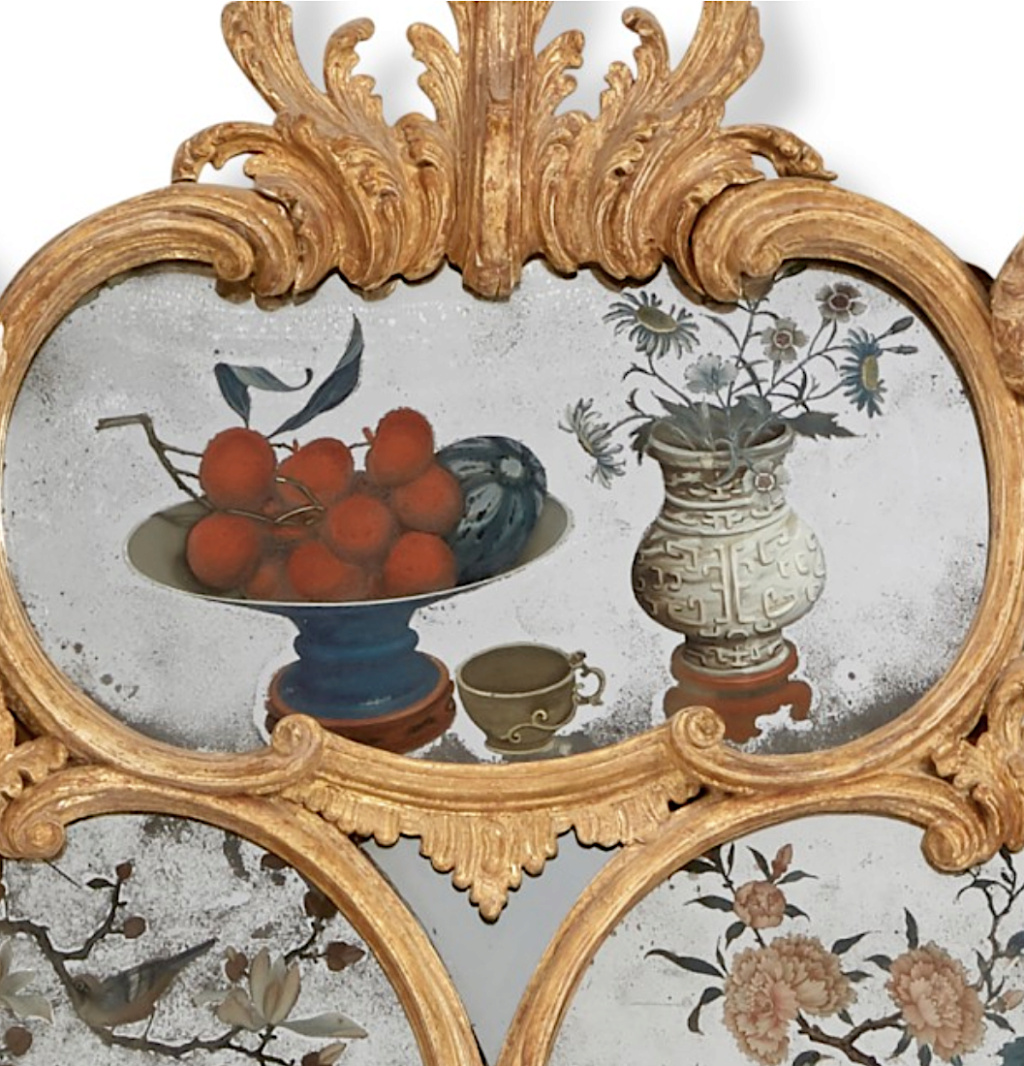
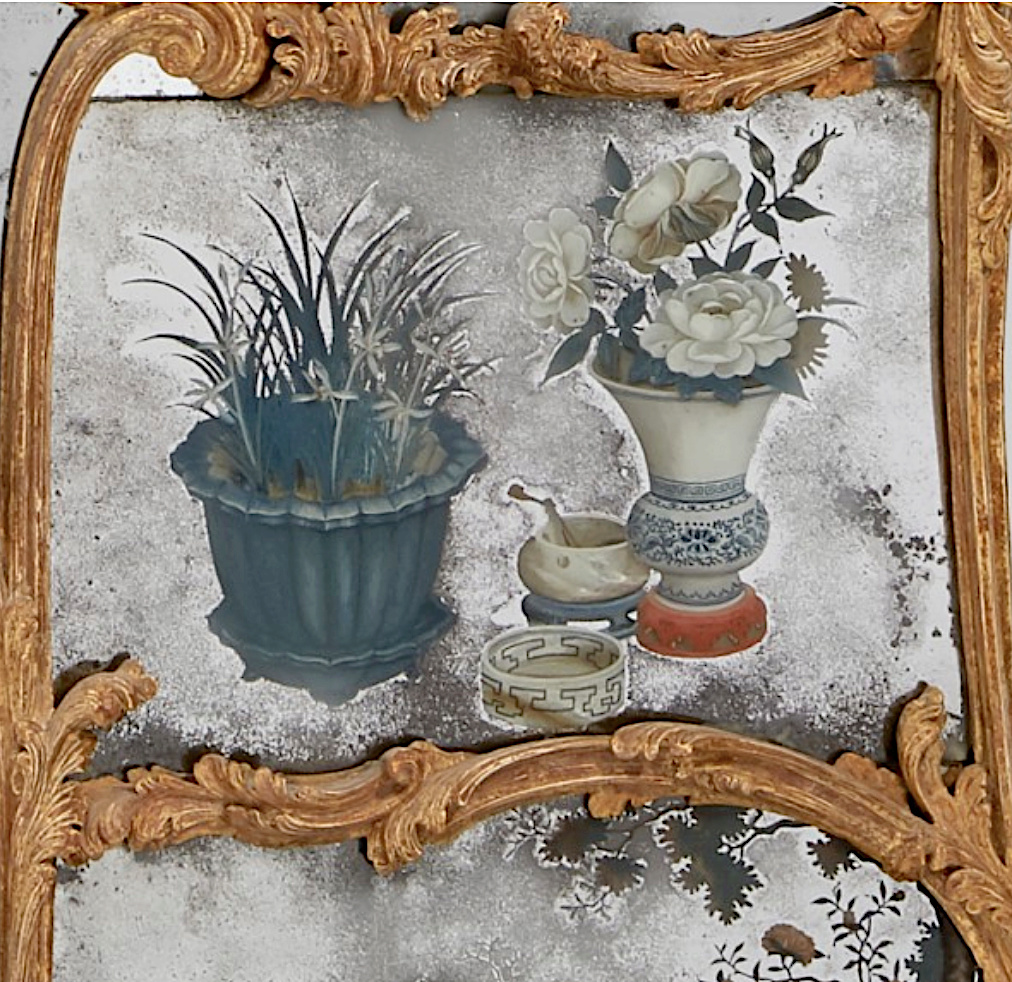
Related examples of overmantel mirrors incorporating Chinese mirror paintings include one sold Christie’s, New York, 21 January 1999, lot 557 ($85,000) attributed to William and John Linnell and dated from 1755. For another example that features similarly beautiful reverse-painted panels dated from 1765 and previously in the collection of the Hon. Mrs. George Keppel see Christie’s, New York, 18-19 April 2012, lot 57 ($290,500) and subsequently sold Christie's, London, 7 July 2016, lot 322 (£194,500).
* Source et infos complémentaires : Christie's NY - Auction Collection of Pierre Durand (27 January 2022)
A GEORGE II GILTWOOD OVERMANTEL MIRROR INSET WITH CHINESE EXPORT REVERSE MIRROR PAINTINGS
CIRCA 1760
The shaped plates within a gilt foliate scroll frame, the outer panels decorated with scenes of landscapes, colorfully plumed birds, flora and fauna
58 in. (147.5 cm.) high, 73 in. (185.5 cm.) wide

Lot Essay
This monumental mirror is remarkable not only for its unusually large scale but equally for its elaborate scene painting within a beautifully drawn giltwood frame. The frame follows the designs of London's pre-eminent cabinet-makers such as John Linnell or Thomas Chippendale. The pairing of reverse painted mirror glass with flat glass represents the ingenuity and collaboration between Chinese and British artists of the mid-18th century.

THE ART OF CHINESE MIRROR PAINTING
The practice of painting on mirrors developed in China after 1715 when the Jesuit missionary Father Castiglione arrived in Beijing. He found favor with the Emperors Yongzheng and Qianlong and was entrusted with the decoration of the Imperial Garden in Beijing. He learned to paint in oil on glass, a technique that was already practiced in Europe but which was unknown in China in 1715.
Chinese artists, already expert in painting and calligraphy, took up the practice, tracing the outlines of their designs on the back of the plate and, using a special steel implement, scraping away the mirror backing to reveal glass that could then be painted.


Glass paintings were made almost entirely for export, fueled by the mania in Europe for all things Chinese. Although glass vessels had long been made in China, the production of flat glass was not accomplished until the 19th century. Even in the Imperial glass workshops, set up in Beijing in 1696 under the supervision of the Bavarian Jesuit Kilian Stumpf, window glass or mirrored glass was not successfully produced. As a result, from the middle of the 18th century onwards, when reverse glass painting was already popular in Europe, sheets of both clear and mirrored glass were sent to Canton from Europe. They most often depicted bucolic landscapes, frequently with sumptuously dressed Chinese figures at leisurely pursuits. Once in Europe the best were often placed in elaborate giltwood Chippendale or Chinoiserie frames.


Related examples of overmantel mirrors incorporating Chinese mirror paintings include one sold Christie’s, New York, 21 January 1999, lot 557 ($85,000) attributed to William and John Linnell and dated from 1755. For another example that features similarly beautiful reverse-painted panels dated from 1765 and previously in the collection of the Hon. Mrs. George Keppel see Christie’s, New York, 18-19 April 2012, lot 57 ($290,500) and subsequently sold Christie's, London, 7 July 2016, lot 322 (£194,500).
* Source et infos complémentaires : Christie's NY - Auction Collection of Pierre Durand (27 January 2022)

La nuit, la neige- Messages : 18132
Date d'inscription : 21/12/2013
 Re: La peinture sous et sur verre au 18e siècle, et la technique du verre églomisé
Re: La peinture sous et sur verre au 18e siècle, et la technique du verre églomisé
Le cabinet des glaces de l’Hotel de la Marine, récemment restauré, est un bon exemple de fixés sous verre du XVIIIe.
Il donne une idée du décor choisi par Marie -Antoinette pour son petit appartement des Tuileries créé à l’attique dans les années 1780. Nous n’avons plus, hélas, de représentation de ce décor. Une thèse de l’Ecole du Louvre a été faite sur le sujet, mais, malgré nos recherches, nous n’avons pu nous la procurer…
Avis aux amateurs…
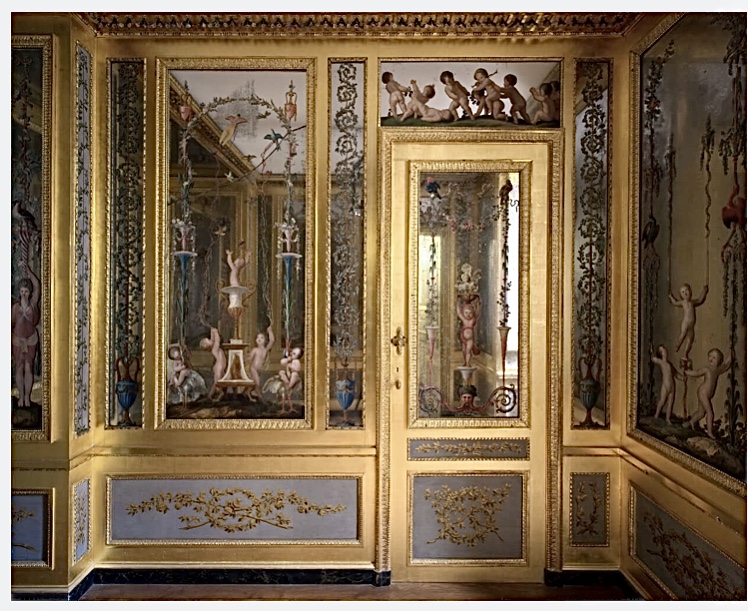
Il donne une idée du décor choisi par Marie -Antoinette pour son petit appartement des Tuileries créé à l’attique dans les années 1780. Nous n’avons plus, hélas, de représentation de ce décor. Une thèse de l’Ecole du Louvre a été faite sur le sujet, mais, malgré nos recherches, nous n’avons pu nous la procurer…
Avis aux amateurs…


Vicq d Azir- Messages : 3676
Date d'inscription : 07/11/2014
Age : 76
Localisation : Paris x
 Re: La peinture sous et sur verre au 18e siècle, et la technique du verre églomisé
Re: La peinture sous et sur verre au 18e siècle, et la technique du verre églomisé
Deux intéressantes compositions seront prochainement présentées en vente aux enchères...
Paire de tableaux en verre églomisé sur fond or
Angleterre, milieu du XVIIIe siècle
Le premier représentant deux silhouettes de jeunes femmes dans un intérieur richement décoré d'un paravent armorié, d'une table bouillotte et d'un tableau aux nymphes, le second représentant le marivaudage d'un galant auprès d'une jeune femme.
Chaque porte une signature « Laureince Delcravit » en bas à gauche.
Cadre en bois et stuc doré, XIXe siècle.
D. : 25.7 x 20.5 cm
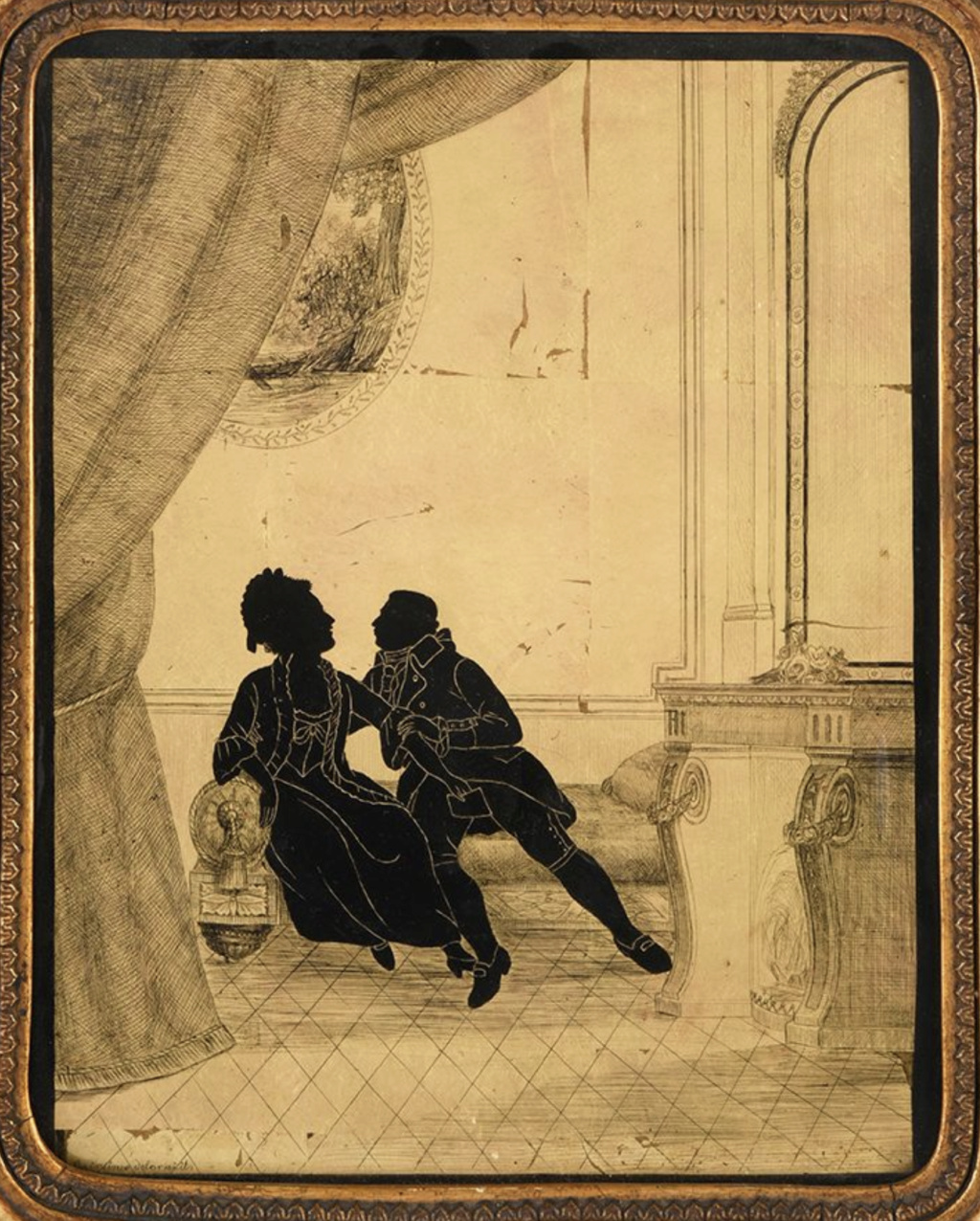

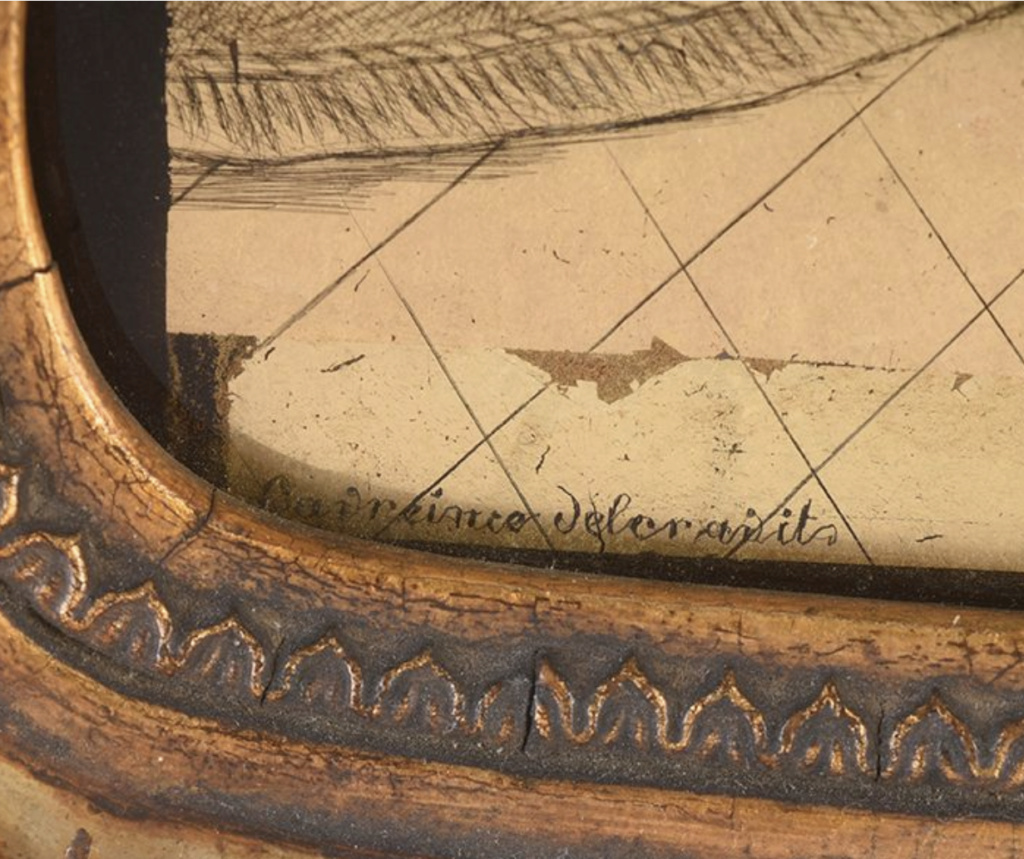



* Source et infos complémentaires : Coutau-Bégarie & Associés - Vente du 3 juin 2022
 Plutôt que " Laureince "
Plutôt que " Laureince "  , m'est avis que la piste à suivre est plutôt Lavreince, en référence au peintre Nicolas Lavreince dont, visiblement, ces deux verres églomisés se sont inspirés. Il s'agit du même " univers ", celui de charmantes petites scènes de genre.
, m'est avis que la piste à suivre est plutôt Lavreince, en référence au peintre Nicolas Lavreince dont, visiblement, ces deux verres églomisés se sont inspirés. Il s'agit du même " univers ", celui de charmantes petites scènes de genre. 
Voir quelques-unes de ses oeuvres notre sujet illustré :
 Niklas Lafrensen, dit Nicolas Lavreince (1737-1807)
Niklas Lafrensen, dit Nicolas Lavreince (1737-1807)
Je ne parviens pas à lire ni comprendre le second mot de la signature, : delecravit ? Deleravit(s) ?
 Si les " silhouettes " vous intéresse, je vous recommande aussi la consultation de notre sujet illustré :
Si les " silhouettes " vous intéresse, je vous recommande aussi la consultation de notre sujet illustré :
 L'art du " portrait en silhouette " ou " à la silhouette "
L'art du " portrait en silhouette " ou " à la silhouette "
 Enfin, qui saurait reconnaître les armes de ce blason ?
Enfin, qui saurait reconnaître les armes de ce blason ? 

Paire de tableaux en verre églomisé sur fond or
Angleterre, milieu du XVIIIe siècle
Le premier représentant deux silhouettes de jeunes femmes dans un intérieur richement décoré d'un paravent armorié, d'une table bouillotte et d'un tableau aux nymphes, le second représentant le marivaudage d'un galant auprès d'une jeune femme.
Chaque porte une signature « Laureince Delcravit » en bas à gauche.
Cadre en bois et stuc doré, XIXe siècle.
D. : 25.7 x 20.5 cm






* Source et infos complémentaires : Coutau-Bégarie & Associés - Vente du 3 juin 2022
____________________________
Présentation au catalogue a écrit:Chaque porte une signature « Laureince Delcravit » en bas à gauche.
 , m'est avis que la piste à suivre est plutôt Lavreince, en référence au peintre Nicolas Lavreince dont, visiblement, ces deux verres églomisés se sont inspirés. Il s'agit du même " univers ", celui de charmantes petites scènes de genre.
, m'est avis que la piste à suivre est plutôt Lavreince, en référence au peintre Nicolas Lavreince dont, visiblement, ces deux verres églomisés se sont inspirés. Il s'agit du même " univers ", celui de charmantes petites scènes de genre. Voir quelques-unes de ses oeuvres notre sujet illustré :
Je ne parviens pas à lire ni comprendre le second mot de la signature, : delecravit ? Deleravit(s) ?


La nuit, la neige- Messages : 18132
Date d'inscription : 21/12/2013
 Re: La peinture sous et sur verre au 18e siècle, et la technique du verre églomisé
Re: La peinture sous et sur verre au 18e siècle, et la technique du verre églomisé
Ne serait-ce pas un b : Deberavit ?
_________________
... demain est un autre jour .

Mme de Sabran- Messages : 55497
Date d'inscription : 21/12/2013
Localisation : l'Ouest sauvage
 Re: La peinture sous et sur verre au 18e siècle, et la technique du verre églomisé
Re: La peinture sous et sur verre au 18e siècle, et la technique du verre églomisé
Proposé prochainement en vente aux enchères...
Deux portraits miniatures circulaires peints avec la technique du fixé sous verre représentant respectivement Louis XVI et Marie-Antoinette.
Signés respectivement et indisctinctement : Bilcoq (?)France, fin du XVIIIe, début du XIXe siècle.
Ils sont compris dans un encadrement rectangulaire.
Diamètre de chaque portrait : 10,5 cm - Dimensions cadre : Hauteur : 18,4 cmLargeur : 30,2 cm



* Source et infos complémentaires : Aguttes - Vente du 30 juin 2022 (Paris)
Deux portraits miniatures circulaires peints avec la technique du fixé sous verre représentant respectivement Louis XVI et Marie-Antoinette.
Signés respectivement et indisctinctement : Bilcoq (?)France, fin du XVIIIe, début du XIXe siècle.
Ils sont compris dans un encadrement rectangulaire.
Diamètre de chaque portrait : 10,5 cm - Dimensions cadre : Hauteur : 18,4 cmLargeur : 30,2 cm



* Source et infos complémentaires : Aguttes - Vente du 30 juin 2022 (Paris)

La nuit, la neige- Messages : 18132
Date d'inscription : 21/12/2013
 Reverse-painted glass panels, 18th century
Reverse-painted glass panels, 18th century
Les amateurs de chinoiseries ne sont pas étonnés de retrouver des pièces en peinture sous verre et verre églomisé réalisées par les ateliers chinois, ou européens, à l'occasion de vente aux enchères de la collection d'Ann et Gordon Getty

Voici une petite sélection...
 Parmi les pièces les plus rares, nous retrouvons cette étonnante....
Parmi les pièces les plus rares, nous retrouvons cette étonnante....
A PAIR OF SOUTH ITALIAN GILT-LEAD AND REVERSE-PAINTED GLASS-MOUNTED GILTWOOD CHAIRS
SICILY, CIRCA 1780
Each with a rectangular padded backrest within reverse etched borders simulating stone and minerals, the seat rails similarly decorated, on square tapered legs, covered in silk and metallic thread fabric of large flower blossoms, formerly with monogram to crest-rails, with printed and inscribed Ann and Gordon Getty Collection inventory label
38 in. (97 cm.) high


Provenance : Possibly supplied for Don Francesco Ferdinando Gravina, Prince of Palagonia (1722-1789) ; Subsequently purchased by the Earl of Derby, Derby House, London, circa 1910 from Lenygon.
Lot Essay
With reverse-painted glass panels painted in imitation of various hardstones including Sicilian jasper in reds, yellows and greens, and lapis lazuli, these chairs are part of the celebrated suite reputedly made for the Prince of Palagonia for the Drawing Room of the Villa Palagonia at Bagheria, near Palermo, Sicily.
However, as A. González-Palacios noted in his “The Prince of Palagonia, Goethe and Glass Furniture,” Burlington Magazine, August 1971, the monogram does not correspond with the prince’s initials and may emanate from a different commission. (Quel monogramme ? )
)
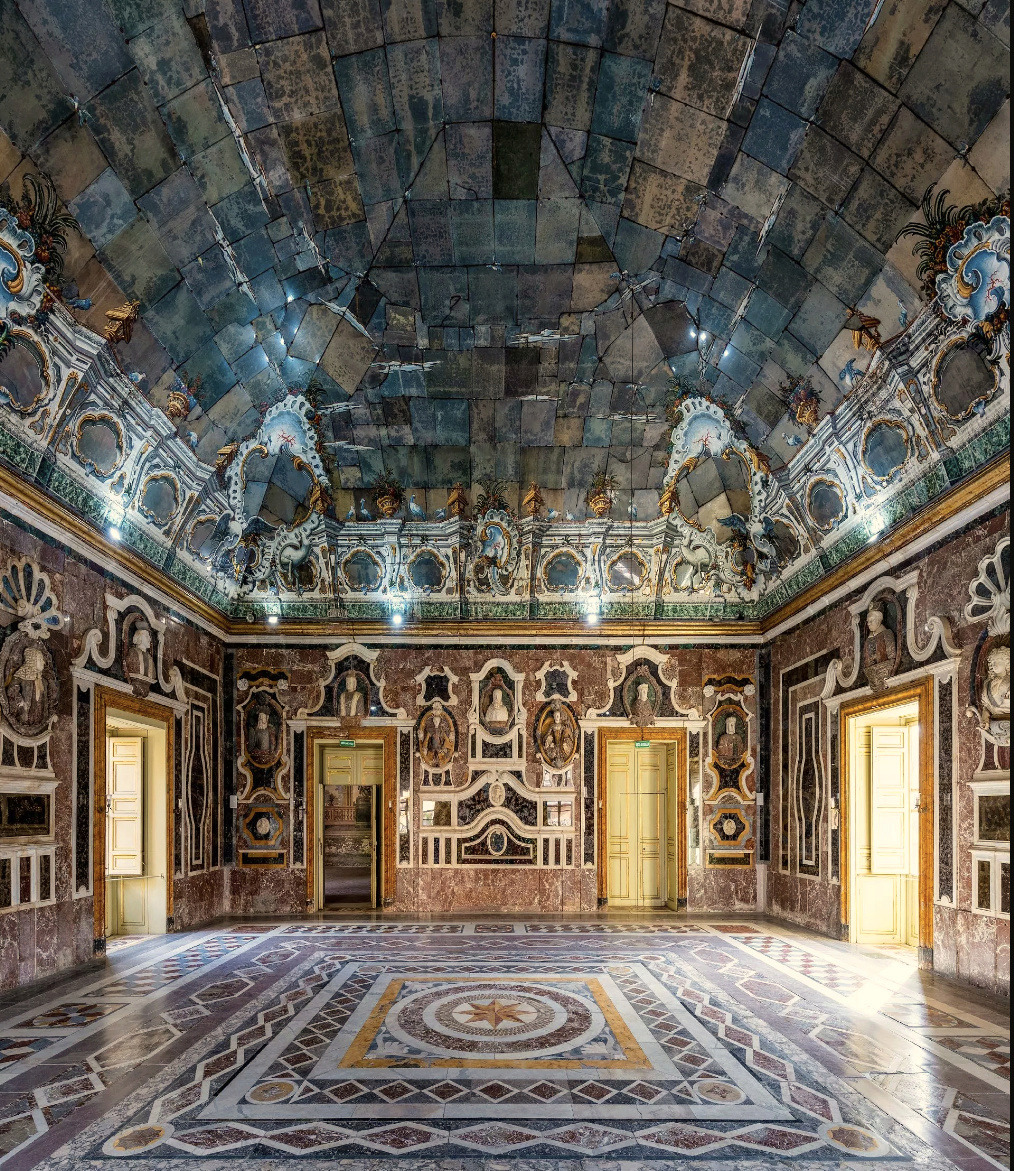
Villa Palagonia, Hall Mirrors
Image : https://villapalagonia.it
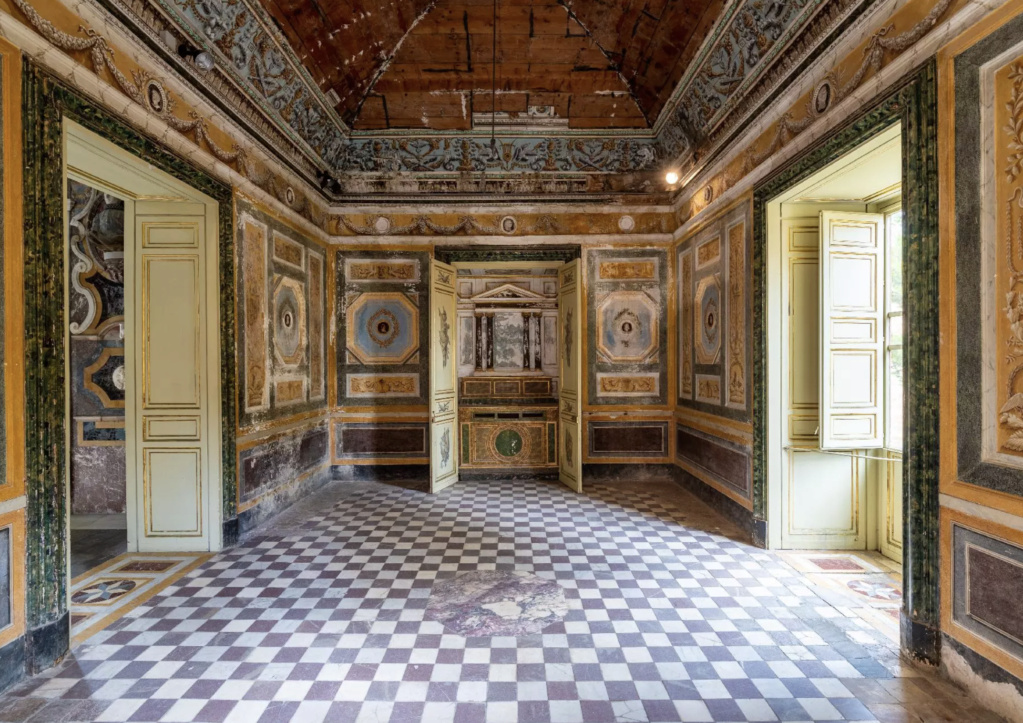
Image : https://villapalagonia.it
Voir notre sujet : Villa Palagonia, ou la villa des monstres
The Sicilian origin, however, seems to be validated by the closely related suite of furniture made for La Favorita, the pavilion built for King Ferdinand IV near Palermo circa 1799. Although confirmation of the original commission still remains a mystery, the precious quality of the labor intensive construction points to a likely commission by a powerful and wealthy Sicilian family as display pieces.

Voir notre sujet : Le Palais chinois de la reine Marie-Caroline, à Palerme
The suite was subsequently bought by the Earl of Derby circa 1910 from Lenygon’s for Derby House, Stratford Place, London. Pieces from this suite are in various private and public collections including, among others; a settee and four chairs formerly in the Alsdorf Collection and sold Christie’s, New York, 24 September 2020, lots 1002-1004; a side chair and a settee in the collection of The Metropolitan Museum of Art, New York (Inv. 1992.173.1 and 1992.173.2); two side chairs in the Art Institute of Chicago, see A. González-Palacios, Il Tempio de Gusto, vol. II, Milan, 1984, p. 275, no. 629; two settees and two chairs at the Ringling Museum of Art, Sarasota, Florida, (Inv. SN1799, SN1800, SN1801 and SN1802). A comparable table of Sicilian manufacture is in the Victoria and Albert Museum, London (Inv. W18-1970).
Voir ces meubles : Villa Palagonia, ou la villa des monstres
* Source et infos complémentaires : Christie's NY - The Ann & Gordon Getty Collection (Oct 2022)
 D'autres pièces proposées lors de cette vente aux enchères, plus " communes "...
D'autres pièces proposées lors de cette vente aux enchères, plus " communes "... 
A GEORGE III MAHOGANY AND EBONY TEA CADDY INSET WITH CHINESE EXPORT REVERSE PAINTINGS-ON-GLASS
THE PAINTINGS QING DYNASTY, THE TEA CADDY CIRCA 1770

The handled hinged top ornamented with checker-stringing and a later velvet backing, opening to a divided interior, inset to three sides with reverse paintings on glass of ladies and gentlemen in a landscape, the bottom right corner plaque replaced, lacking tea cannisters, with printed and inscribed Ann and Gordon Getty Collection inventory label
6 in. (15 cm.) high, 11 1/2 in. (29 cm.) wide, 6 in. (15 cm.) deep
Image : Christie's
Lot Essay
The technique for creating pictures on imported glass is thought to have been promoted in China by Father Giuseppe Castiglione (1688-1766) who reached Peking in 1715 and found favor with the Imperial rulers. The process had already been used in Europe, termed verre églomisé, and Chinese artists, already expert in painting and calligraphy, took up the practice, apply the pigments in the reverse of the normal order, beginning with the highlights and ending with the background.

Common designs included still lives, birds and groups of figures, usually depicted against backgrounds of rivers or pavilions and mediums included glass pictures as well as mirrors, and on the rare occasion special luxury items such as the present lot.
The finished articles were widely admired in European markets, and when sent back to Europe, enduring another hazardous sea voyage, they were quickly adopted along with Chinese porcelain, wallpaper, silks, and lacquer in the most fashionable circles desirous of the exotic.
(...)

A PAIR OF CHINESE EXPORT REVERSE-PAINTED MIRRORS
QING DYNASTY, LATE 18TH CENTURY
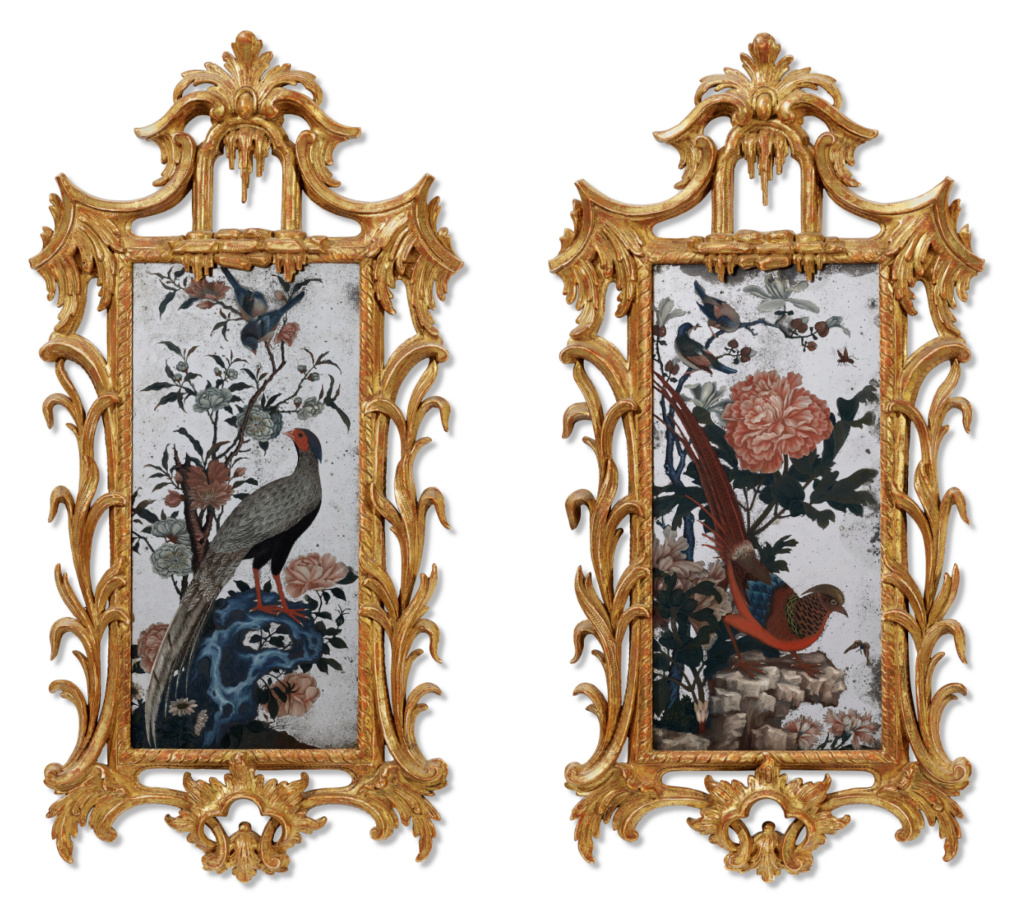
27 1/2 in. (70 cm.) high, 14 1/4 in. (36.5 cm.) wide
Image : Christie's
A PAIR OF CHINESE EXPORT REVERSE-PAINTED MIRRORS
QING DYNASTY, LATE 18TH CENTURY

22 1/4 in. (46.5 cm.) high, 13 3/4 in. (34 cm.) wide, overal
Image : Christie's
A CHINESE EXPORT REVERSE-PAINTED MIRROR SHADOWBOX
QING DYNASTY, LAST QUARTER 18TH CENTURY
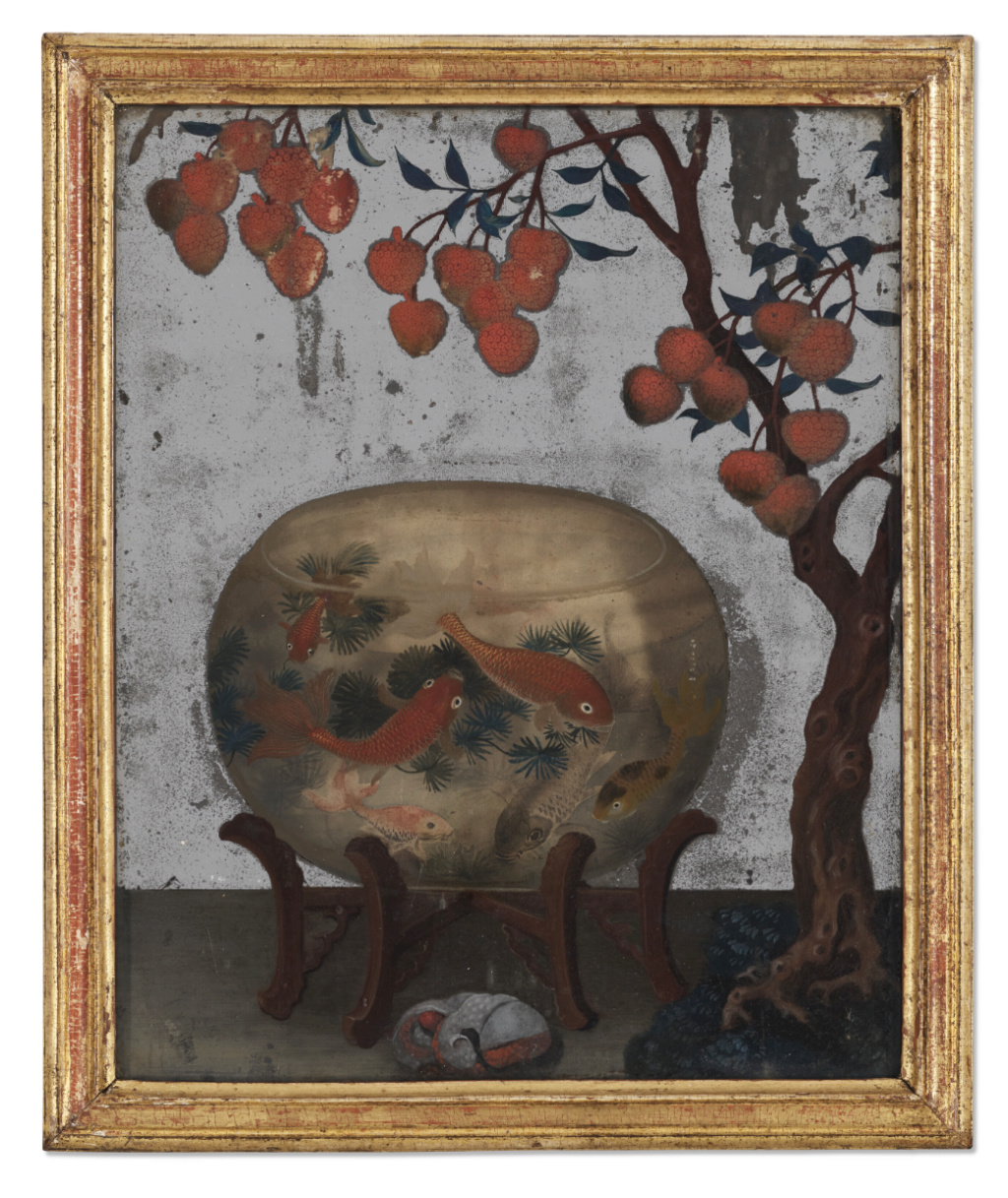
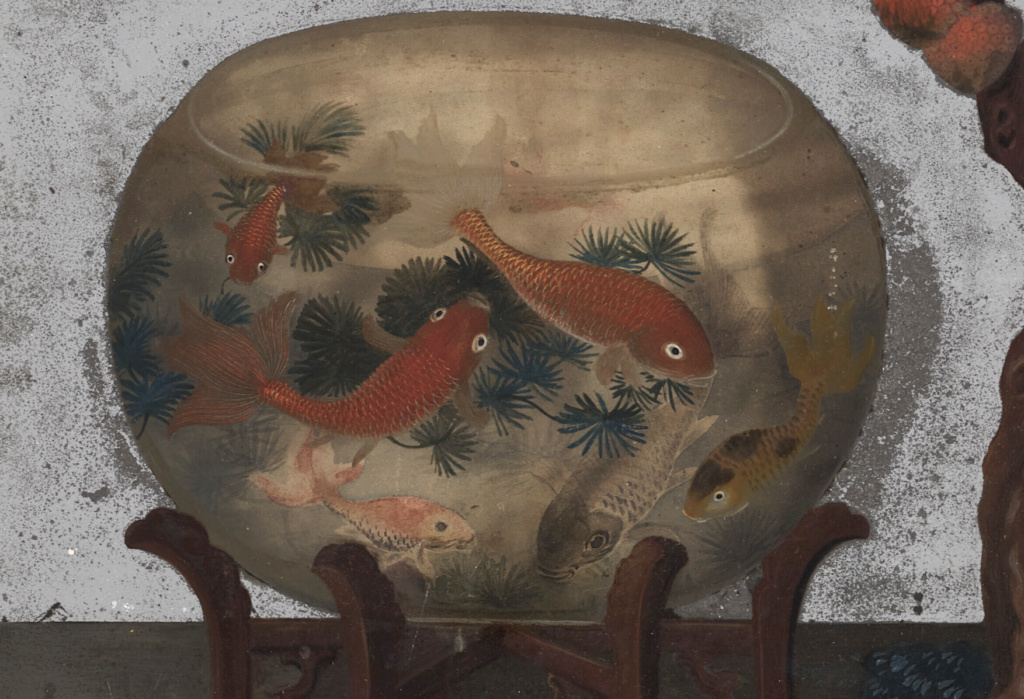
18 1/4 x 15 in. (46.5 x 38 cm.)
Image : Christie's
TWO CHINESE EXPORT REVERSE-PAINTED MIRRORS
QING DYNASTY, LATE 18TH CENTURY

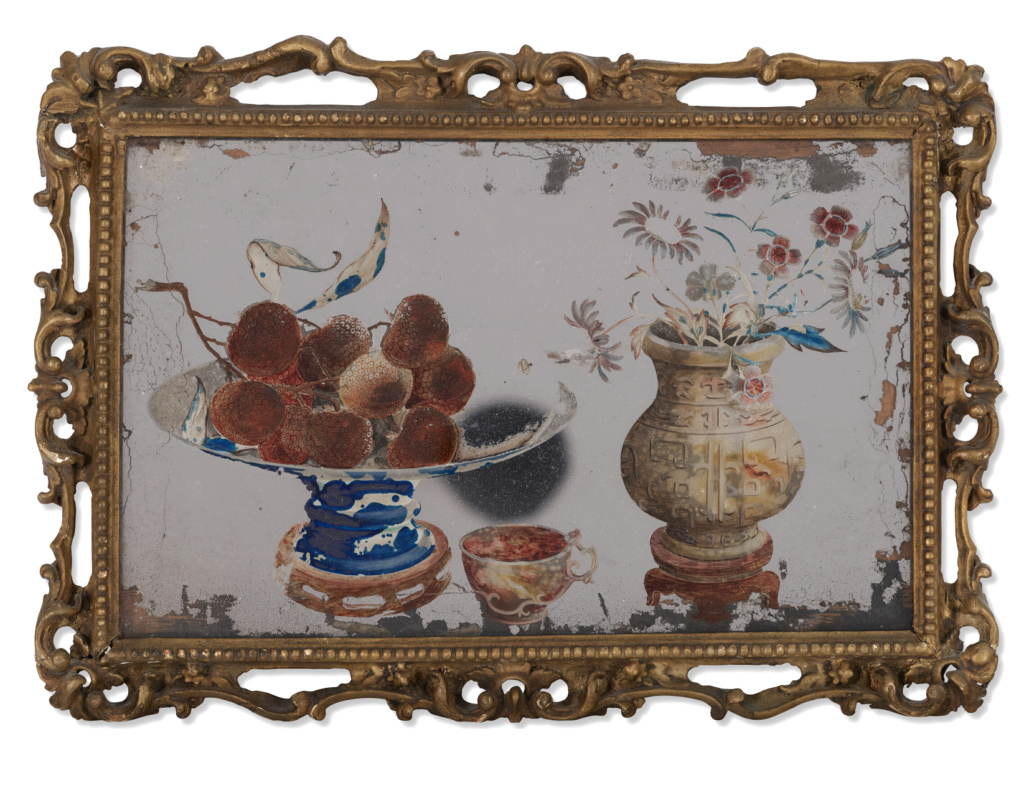
One: 111⁄2 in. (29.2 cm.) x 14 in. (35.6 cm.)
The other: 11 in. (27.9 cm.) x 153⁄4 in. (40 cm.)
Images : Christie's
A PAIR OF CHINESE EXPORT REVERSE-PAINTED MIRRORS IN GEORGE III GILTWOOD FRAMES
THE MIRRORS QING DYNASTY, THE FRAMES CIRCA 1760
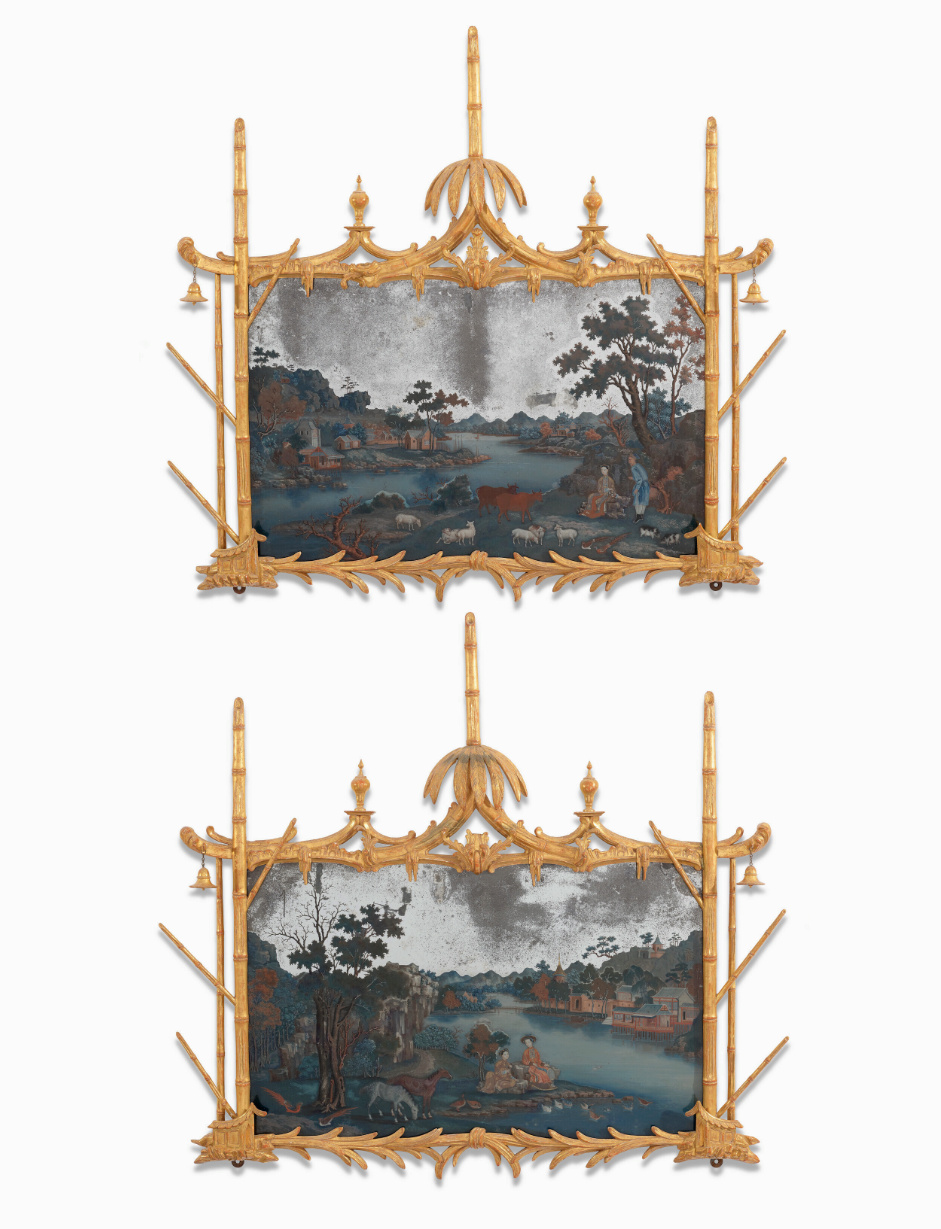


36 in. (91.5 cm.) high, 37 1/2 in. (95 cm.) wide
Images : Christie's
A PAIR OF CHINESE EXPORT REVERSE-PAINTED MIRRORS IN GEORGE III GILTWOOD FRAMES
THE MIRRORS QING DYNASTY, THE FRAMES CIRCA 1760

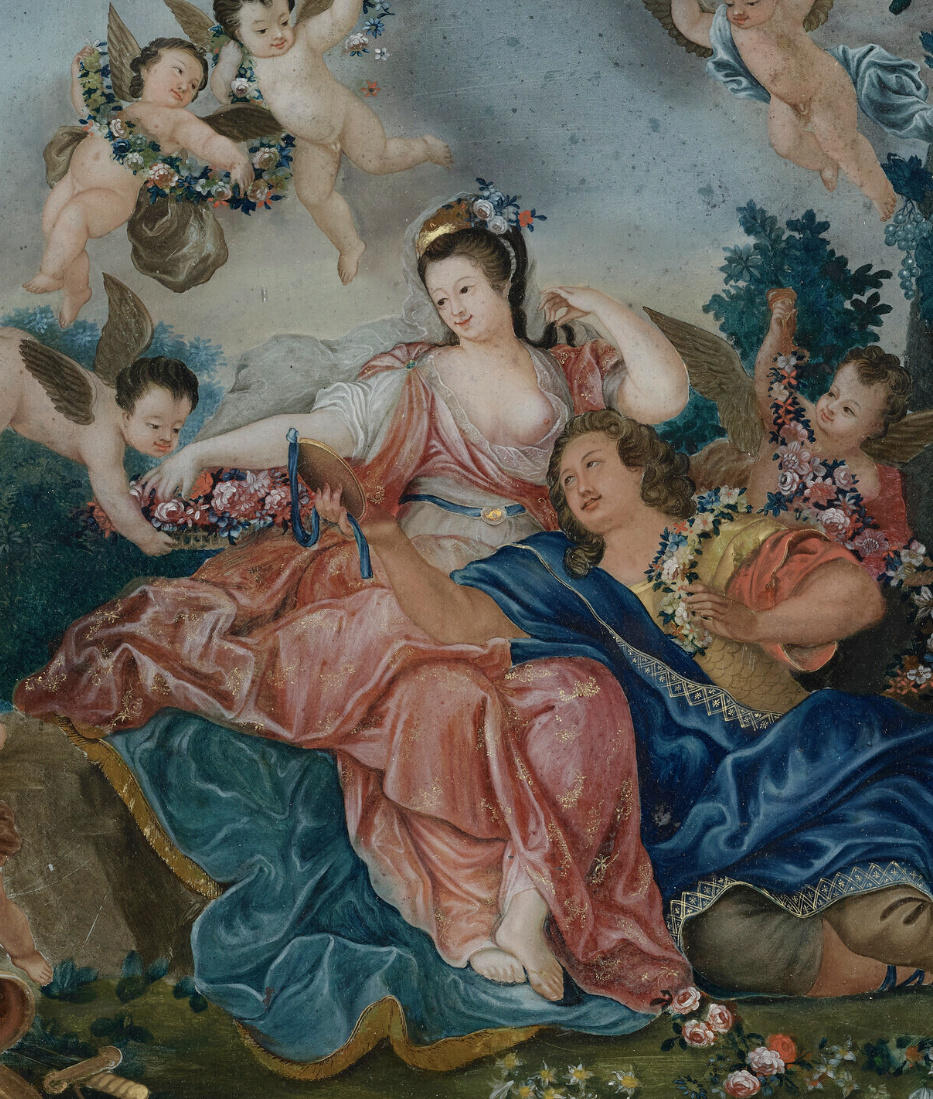
Depicting an allegory of Venus and Mars with attendant putti in a verdant landscape, in a contemporary frame, later gilt
36 in. (91.5 cm.) high, 37 1/2 in. (95 cm.) wide
Images : Christie's
A PAIR OF NORTH EUROPEAN REVERSE-PAINTED GLASS PANELS
SIGNED JC VOGEL, DATED 1776


191⁄2 in. (49.5 cm.) high, 221⁄2 in. (57 cm.) wide, framed
Images : Christie's
* Source et infos complémentaires : Christie's NY - The Ann & Gordon Getty Collection (October 22)

Voici une petite sélection...
A PAIR OF SOUTH ITALIAN GILT-LEAD AND REVERSE-PAINTED GLASS-MOUNTED GILTWOOD CHAIRS
SICILY, CIRCA 1780
Each with a rectangular padded backrest within reverse etched borders simulating stone and minerals, the seat rails similarly decorated, on square tapered legs, covered in silk and metallic thread fabric of large flower blossoms, formerly with monogram to crest-rails, with printed and inscribed Ann and Gordon Getty Collection inventory label
38 in. (97 cm.) high


Provenance : Possibly supplied for Don Francesco Ferdinando Gravina, Prince of Palagonia (1722-1789) ; Subsequently purchased by the Earl of Derby, Derby House, London, circa 1910 from Lenygon.
Lot Essay
With reverse-painted glass panels painted in imitation of various hardstones including Sicilian jasper in reds, yellows and greens, and lapis lazuli, these chairs are part of the celebrated suite reputedly made for the Prince of Palagonia for the Drawing Room of the Villa Palagonia at Bagheria, near Palermo, Sicily.
However, as A. González-Palacios noted in his “The Prince of Palagonia, Goethe and Glass Furniture,” Burlington Magazine, August 1971, the monogram does not correspond with the prince’s initials and may emanate from a different commission. (Quel monogramme ?
 )
)
Villa Palagonia, Hall Mirrors
Image : https://villapalagonia.it

Image : https://villapalagonia.it
Voir notre sujet : Villa Palagonia, ou la villa des monstres
The Sicilian origin, however, seems to be validated by the closely related suite of furniture made for La Favorita, the pavilion built for King Ferdinand IV near Palermo circa 1799. Although confirmation of the original commission still remains a mystery, the precious quality of the labor intensive construction points to a likely commission by a powerful and wealthy Sicilian family as display pieces.

Voir notre sujet : Le Palais chinois de la reine Marie-Caroline, à Palerme
The suite was subsequently bought by the Earl of Derby circa 1910 from Lenygon’s for Derby House, Stratford Place, London. Pieces from this suite are in various private and public collections including, among others; a settee and four chairs formerly in the Alsdorf Collection and sold Christie’s, New York, 24 September 2020, lots 1002-1004; a side chair and a settee in the collection of The Metropolitan Museum of Art, New York (Inv. 1992.173.1 and 1992.173.2); two side chairs in the Art Institute of Chicago, see A. González-Palacios, Il Tempio de Gusto, vol. II, Milan, 1984, p. 275, no. 629; two settees and two chairs at the Ringling Museum of Art, Sarasota, Florida, (Inv. SN1799, SN1800, SN1801 and SN1802). A comparable table of Sicilian manufacture is in the Victoria and Albert Museum, London (Inv. W18-1970).
Voir ces meubles : Villa Palagonia, ou la villa des monstres
* Source et infos complémentaires : Christie's NY - The Ann & Gordon Getty Collection (Oct 2022)
A GEORGE III MAHOGANY AND EBONY TEA CADDY INSET WITH CHINESE EXPORT REVERSE PAINTINGS-ON-GLASS
THE PAINTINGS QING DYNASTY, THE TEA CADDY CIRCA 1770

The handled hinged top ornamented with checker-stringing and a later velvet backing, opening to a divided interior, inset to three sides with reverse paintings on glass of ladies and gentlemen in a landscape, the bottom right corner plaque replaced, lacking tea cannisters, with printed and inscribed Ann and Gordon Getty Collection inventory label
6 in. (15 cm.) high, 11 1/2 in. (29 cm.) wide, 6 in. (15 cm.) deep
Image : Christie's
Lot Essay
The technique for creating pictures on imported glass is thought to have been promoted in China by Father Giuseppe Castiglione (1688-1766) who reached Peking in 1715 and found favor with the Imperial rulers. The process had already been used in Europe, termed verre églomisé, and Chinese artists, already expert in painting and calligraphy, took up the practice, apply the pigments in the reverse of the normal order, beginning with the highlights and ending with the background.

Common designs included still lives, birds and groups of figures, usually depicted against backgrounds of rivers or pavilions and mediums included glass pictures as well as mirrors, and on the rare occasion special luxury items such as the present lot.
The finished articles were widely admired in European markets, and when sent back to Europe, enduring another hazardous sea voyage, they were quickly adopted along with Chinese porcelain, wallpaper, silks, and lacquer in the most fashionable circles desirous of the exotic.
(...)

A PAIR OF CHINESE EXPORT REVERSE-PAINTED MIRRORS
QING DYNASTY, LATE 18TH CENTURY

27 1/2 in. (70 cm.) high, 14 1/4 in. (36.5 cm.) wide
Image : Christie's
A PAIR OF CHINESE EXPORT REVERSE-PAINTED MIRRORS
QING DYNASTY, LATE 18TH CENTURY

22 1/4 in. (46.5 cm.) high, 13 3/4 in. (34 cm.) wide, overal
Image : Christie's
A CHINESE EXPORT REVERSE-PAINTED MIRROR SHADOWBOX
QING DYNASTY, LAST QUARTER 18TH CENTURY


18 1/4 x 15 in. (46.5 x 38 cm.)
Image : Christie's
TWO CHINESE EXPORT REVERSE-PAINTED MIRRORS
QING DYNASTY, LATE 18TH CENTURY


One: 111⁄2 in. (29.2 cm.) x 14 in. (35.6 cm.)
The other: 11 in. (27.9 cm.) x 153⁄4 in. (40 cm.)
Images : Christie's
A PAIR OF CHINESE EXPORT REVERSE-PAINTED MIRRORS IN GEORGE III GILTWOOD FRAMES
THE MIRRORS QING DYNASTY, THE FRAMES CIRCA 1760



36 in. (91.5 cm.) high, 37 1/2 in. (95 cm.) wide
Images : Christie's
A PAIR OF CHINESE EXPORT REVERSE-PAINTED MIRRORS IN GEORGE III GILTWOOD FRAMES
THE MIRRORS QING DYNASTY, THE FRAMES CIRCA 1760


Depicting an allegory of Venus and Mars with attendant putti in a verdant landscape, in a contemporary frame, later gilt
36 in. (91.5 cm.) high, 37 1/2 in. (95 cm.) wide
Images : Christie's
A PAIR OF NORTH EUROPEAN REVERSE-PAINTED GLASS PANELS
SIGNED JC VOGEL, DATED 1776


191⁄2 in. (49.5 cm.) high, 221⁄2 in. (57 cm.) wide, framed
Images : Christie's
* Source et infos complémentaires : Christie's NY - The Ann & Gordon Getty Collection (October 22)

La nuit, la neige- Messages : 18132
Date d'inscription : 21/12/2013
 Re: La peinture sous et sur verre au 18e siècle, et la technique du verre églomisé
Re: La peinture sous et sur verre au 18e siècle, et la technique du verre églomisé
Proposé prochainement en vente aux enchères, et sans surprise en provenance des célèbres collections de Ann Getty grande collectionneuse de chinoiseries en tous genres, dont...
EARLY GEORGE III EBONY AND CHINESE REVERSE-PAINTED MIRROR BREAKFRONT BOOKCASE
CIRCA 1760
The broken arch pediment above two outset doors flanked by recessed doors, the whole inset with Chinese mirror paintings, the lower case with cabinet doors, with printed and inscribed Ann and Gordon Getty Collection inventory label
96 ½ in. (245.1 cm.) high, 93 ¼ in. (236.9 cm.) wide, 19 in. (48.3 cm.) deep

Lot Essay
This spectacular breakfront bookcase is unique and of utmost rarity. Constructed of solid ebony with a pine and teak carcass, the four upper doors show-off a dazzling display of sixty original Chinese reverse-painted mirrors, separated by moulded glazing bars forming an interlocking pattern of octagons and rectangles, over a continuous band of inlaid satinwood Chinese paling. The lower drawers are lined with camphorwood and adorned with gilt-brass lion mask handles and foliate escutcheons, the whole supported on a confirming plinth.
EBONY: THE WOOD OF EMPERORS, KINGS, AND PRINCES
In his seminal work, Woods in British Furniture-Making, 1400-1900, Adam Bowett writes: ‘Ebony might justifiably be described as the foremost of all cabinet woods…The attraction of ebony was both aesthetic and symbolic. Ebony was the wood of emperors, kings, and princes, and it was imbued with the authority of ancient texts… its heart was jet black, seemingly flawless and imperishable, a kind of vegetable marble. Its working qualities were also somewhat like stone, not only because of its hardness, but from its very fine texture. Ebony possessed a degree of perfection in surface, form, and colour not achievable in any other wood, while still being susceptible to established woodworking techniques’ (2012, p. 70). While highly desirable, ebony was also enormously expensive, which is probably why it was seldom used in mid-18th century English cabinet-making, except on rare occasions for decorative details. In addition to high shipping costs from Asia, ebony was subject to import duties roughly equivalent to £2,000 per ton (ibid., p. 72). Its use in this bookcase indicates supreme extravagance.
A UNIQUE DESIGN
There is no known precedent for this bookcase, other than a smaller padouk wood two-door cabinet, previously with Ronald Phillips, London, which shares a similar broken pediment with dentil molding. It also has Chinese reverse-painted mirrors with a comparable glazing bar pattern. The use of exotic timbers in both cabinets is notable, and the thematic similarities between the glass paintings suggests they must come from the same workshop, and were possibly even commissioned by the same supercargo.

The overall form of this bookcase is inspired by Chippendale's designs for a ‘Library Bookcase’ published in The Gentleman and Cabinet-Maker's Director (1754, pls. XCI and XCV). There are, however, no known comparisons with ebony as the primary wood, likely due to its great expense and difficulty to work as discussed above, and the use of it in this context predates later fashions. The inlaid satinwood band of Chinese paling is identical to that of a frieze molding illustrated in one of Sir William Chambers’s designs for a ‘Chinese Room’ (W. Chambers, Book of Chinese Buildings, Furniture, Dresses, Machines, and Utensils, London, 1757, pl. X, fig. . The gilt-brass lion’s mask mounts to which the pulls attach are the same pattern as those seen on the signed George III mahogany cabinet, dated 1763, by William Hallett (d. 1781) sold from The William F. Reilly Collection; Christie’s, New York, 14 October 2009. This cabinet shares the same broken pediment centered by a plinth and the cornice decorated with dentil molding, positing Hallett as a possible maker, though the designs were hardly exclusive to him.
. The gilt-brass lion’s mask mounts to which the pulls attach are the same pattern as those seen on the signed George III mahogany cabinet, dated 1763, by William Hallett (d. 1781) sold from The William F. Reilly Collection; Christie’s, New York, 14 October 2009. This cabinet shares the same broken pediment centered by a plinth and the cornice decorated with dentil molding, positing Hallett as a possible maker, though the designs were hardly exclusive to him.
THE CANTONESE WORKSHOP: SIOU-SIN SAANG?
Chinese reverse-painted mirrors are rarely incorporated into furniture of this period, with the Ronald Phillips cabinet being the only other known example. Thus, in this profusion, they are certainly unique. The sixty panels here are symmetrically arranged, following a coherent overall plan. Each section has obviously been made specifically to fit its intended space, thus the drawings or specifications of the glazing bars pattern must have accompanied the glass when it was originally sent from England to China to be painted.
The paintings form part of an ordered scheme: each door has at the top a hanging basket with flowers, followed by a still life comprising vases and flowers, a central octagonal panel depicting Chinese figures, a further still life with fruit and flowers, and finally a seascape. The mirror panels surrounding these scenes are also conforming and are decorated with birds, insects, and flowers. Together they form what must be one of the most beautiful collections of 18th century Chinese reverse glass paintings ever assembled.


The mirror paintings can be attributed to a Cantonese workshop in operation from at least c. 1740-1760, based off the very similar depictions of Chinese notables also seen in the overmantel mirror paintings at the Drottningholm Chinese Pavilion in Stockholm, Sweden. As Thierry Audric suggests in Chinese Reverse Glass Painting 1720-1820, the workshop which provided the mirror paintings for the Drottningholm overmantel and also this bookcase, is possibly the same one visited by Sir William Chambers, which he called Siou-Sin Saang (T. Audric, Chinese Reverse Glass Painting 1720-1820 - An Artistic Meeting Between China and the West, Peter Lang, 2020, pp. 120-125).

The Chinese Pavilion, in the grounds of the Drottningholm Palace park
Image : Commons wikimedia
Perhaps best known as architectural advisor to King George III, Sir William Chambers (1722-1796) was born in Gothenberg, Sweden to Scottish parents. He was educated in England before starting a mercantile career and joining the Swedish East India Company. He made three separate voyages to Asia between 1740 and 1749. The first (1740-42) was to Bengal, India, while the second (departing 1743) and third (1748-49) were both to China. On the voyages to China, Chambers acted as an assistant supercargo, and thus was responsible for managing and selling the cargo, as well as buying and receiving goods for the return voyage, hence his familiarity with the Siou-Sin Saang workshop. It was an extremely lucrative position and it was during these trips that he made his first-hand observations that later formed the basis of his drawings published to great renown (see: W. Chambers, Book of Chinese Buildings, Furniture, etc., 1757).
While no explicit connection between Chambers and this bookcase can be made yet, it is conceivable that he advised on such a commission. For, whomever commissioned the bookcase circa 1760 would have been exceedingly wealthy, could have their order executed on the spot in Canton, and therefore must have had a strong relationship with the East India Company.

Portrait of Sir William Chambers,
Oil on panel, ca. 1780
Sir Joshua Reynolds
Image : Royal Academy of Arts, London. Photographer: Prudence Cuming Associates Limited
SINGLETON ABBEY, SWANSEA — THE VIVIAN FAMILY
MOYNS PARK, ESSEX — JOSEPHINE HARTFORD BRYCE
* Source et infos complémentaires : Christie's NY - The Collection of Ann & Gordon Getty: Wheatland
EARLY GEORGE III EBONY AND CHINESE REVERSE-PAINTED MIRROR BREAKFRONT BOOKCASE
CIRCA 1760
The broken arch pediment above two outset doors flanked by recessed doors, the whole inset with Chinese mirror paintings, the lower case with cabinet doors, with printed and inscribed Ann and Gordon Getty Collection inventory label
96 ½ in. (245.1 cm.) high, 93 ¼ in. (236.9 cm.) wide, 19 in. (48.3 cm.) deep

Lot Essay
This spectacular breakfront bookcase is unique and of utmost rarity. Constructed of solid ebony with a pine and teak carcass, the four upper doors show-off a dazzling display of sixty original Chinese reverse-painted mirrors, separated by moulded glazing bars forming an interlocking pattern of octagons and rectangles, over a continuous band of inlaid satinwood Chinese paling. The lower drawers are lined with camphorwood and adorned with gilt-brass lion mask handles and foliate escutcheons, the whole supported on a confirming plinth.
EBONY: THE WOOD OF EMPERORS, KINGS, AND PRINCES
In his seminal work, Woods in British Furniture-Making, 1400-1900, Adam Bowett writes: ‘Ebony might justifiably be described as the foremost of all cabinet woods…The attraction of ebony was both aesthetic and symbolic. Ebony was the wood of emperors, kings, and princes, and it was imbued with the authority of ancient texts… its heart was jet black, seemingly flawless and imperishable, a kind of vegetable marble. Its working qualities were also somewhat like stone, not only because of its hardness, but from its very fine texture. Ebony possessed a degree of perfection in surface, form, and colour not achievable in any other wood, while still being susceptible to established woodworking techniques’ (2012, p. 70). While highly desirable, ebony was also enormously expensive, which is probably why it was seldom used in mid-18th century English cabinet-making, except on rare occasions for decorative details. In addition to high shipping costs from Asia, ebony was subject to import duties roughly equivalent to £2,000 per ton (ibid., p. 72). Its use in this bookcase indicates supreme extravagance.
A UNIQUE DESIGN
There is no known precedent for this bookcase, other than a smaller padouk wood two-door cabinet, previously with Ronald Phillips, London, which shares a similar broken pediment with dentil molding. It also has Chinese reverse-painted mirrors with a comparable glazing bar pattern. The use of exotic timbers in both cabinets is notable, and the thematic similarities between the glass paintings suggests they must come from the same workshop, and were possibly even commissioned by the same supercargo.

The overall form of this bookcase is inspired by Chippendale's designs for a ‘Library Bookcase’ published in The Gentleman and Cabinet-Maker's Director (1754, pls. XCI and XCV). There are, however, no known comparisons with ebony as the primary wood, likely due to its great expense and difficulty to work as discussed above, and the use of it in this context predates later fashions. The inlaid satinwood band of Chinese paling is identical to that of a frieze molding illustrated in one of Sir William Chambers’s designs for a ‘Chinese Room’ (W. Chambers, Book of Chinese Buildings, Furniture, Dresses, Machines, and Utensils, London, 1757, pl. X, fig.
THE CANTONESE WORKSHOP: SIOU-SIN SAANG?
Chinese reverse-painted mirrors are rarely incorporated into furniture of this period, with the Ronald Phillips cabinet being the only other known example. Thus, in this profusion, they are certainly unique. The sixty panels here are symmetrically arranged, following a coherent overall plan. Each section has obviously been made specifically to fit its intended space, thus the drawings or specifications of the glazing bars pattern must have accompanied the glass when it was originally sent from England to China to be painted.
The paintings form part of an ordered scheme: each door has at the top a hanging basket with flowers, followed by a still life comprising vases and flowers, a central octagonal panel depicting Chinese figures, a further still life with fruit and flowers, and finally a seascape. The mirror panels surrounding these scenes are also conforming and are decorated with birds, insects, and flowers. Together they form what must be one of the most beautiful collections of 18th century Chinese reverse glass paintings ever assembled.


The mirror paintings can be attributed to a Cantonese workshop in operation from at least c. 1740-1760, based off the very similar depictions of Chinese notables also seen in the overmantel mirror paintings at the Drottningholm Chinese Pavilion in Stockholm, Sweden. As Thierry Audric suggests in Chinese Reverse Glass Painting 1720-1820, the workshop which provided the mirror paintings for the Drottningholm overmantel and also this bookcase, is possibly the same one visited by Sir William Chambers, which he called Siou-Sin Saang (T. Audric, Chinese Reverse Glass Painting 1720-1820 - An Artistic Meeting Between China and the West, Peter Lang, 2020, pp. 120-125).

The Chinese Pavilion, in the grounds of the Drottningholm Palace park
Image : Commons wikimedia
Perhaps best known as architectural advisor to King George III, Sir William Chambers (1722-1796) was born in Gothenberg, Sweden to Scottish parents. He was educated in England before starting a mercantile career and joining the Swedish East India Company. He made three separate voyages to Asia between 1740 and 1749. The first (1740-42) was to Bengal, India, while the second (departing 1743) and third (1748-49) were both to China. On the voyages to China, Chambers acted as an assistant supercargo, and thus was responsible for managing and selling the cargo, as well as buying and receiving goods for the return voyage, hence his familiarity with the Siou-Sin Saang workshop. It was an extremely lucrative position and it was during these trips that he made his first-hand observations that later formed the basis of his drawings published to great renown (see: W. Chambers, Book of Chinese Buildings, Furniture, etc., 1757).
While no explicit connection between Chambers and this bookcase can be made yet, it is conceivable that he advised on such a commission. For, whomever commissioned the bookcase circa 1760 would have been exceedingly wealthy, could have their order executed on the spot in Canton, and therefore must have had a strong relationship with the East India Company.

Portrait of Sir William Chambers,
Oil on panel, ca. 1780
Sir Joshua Reynolds
Image : Royal Academy of Arts, London. Photographer: Prudence Cuming Associates Limited
SINGLETON ABBEY, SWANSEA — THE VIVIAN FAMILY
- Spoiler:
- The commissioner of this bookcase remains a mystery for now, as the earliest record of it is from Singleton Abbey, Swansea, Wales. The original structure of Singleton Abbey was an octagonal villa named Marino, which was built in the latter half of the 18th century by Swansea architect William Jernegan for Edward King, Esq. (1750-1819), the Deputy Comptroller of Customs for the Port of Swansea and later the Collector of Customs (S. Littlejohns, Singleton Abbey: The History of the Singleton Estate, Swansea, singletonabbey.co.uk, 2023). In 1816, John Henry Vivian, Esq., FRS, (1785-1855) began leasing the home from King, eventually acquiring it for his family residence. He came from the old Cornish family whose seat was Trelowarren House at Meanage, and had ‘arrived in Swansea on a packet boat from Ilfracombe’ in 1806 to expand the family’s copper-works in the area. John Henry and his wife Sarah were living at Marino in 1817 and began expanding and re-furbishing the house within the year. They eventually hired London based architect Peter Frederick Robinson (1776-1858) to complete the work on the house, which was done in the Tudor Style, and thus the house became known as Singleton Abbey (ibid.). The bookcase was well-suited for such a house, in which ebony furniture would have been seen as the correct choice for a neo-gothic interior, especially by an antiquarian like John Henry. He was an avid collector and amassed a variety of amazing objects for Singleton throughout his life. The Singleton Abbey sale in 1919, as documented in the auction catalogue by Knight, Frank, & Rutley, provides compelling evidence of this. The catalogue lists an abundance of ebony and ebonized furniture, which includes Florentine cabinets inlaid with ivory and tortoiseshell, William and Mary marquetry and parquetry tables, as well as artworks dating back to the Tudor and Elizabethan periods. All in keeping with the taste, it also boasted exceptional Old Master paintings, some of which can now be traced to prestigious institutions including the Louvre.
This bookcase was not included in the 1919 Singleton Abbey sale, as it was kept in the Vivian family and at some point had been taken to Clyne Castle, the neighboring residence of John Henry Vivian’s son, William Graham Vivian. He had no children, and so it ultimately descended to his nephew Algernon Walker Heneage, who was obligated to take the surname Vivian upon inheritance. On his death in 1952 the castle and its surrounding lands were purchased by Swansea Borough Council and its contents sold by auction that same year, with this bookcase as lot 382.
MOYNS PARK, ESSEX — JOSEPHINE HARTFORD BRYCE
- Spoiler:
- In the early 20th century, Josephine Hartford Bryce (1870-1922), known as ‘Jo’ or ‘Jo-Jo’ was a glamor girl and famously part of the much-discussed triumvirate of New York heiresses along with Barbara Hutton and Doris Duke. She was the daughter of Edward V Hartford (1870-1922), the heir to the A&P grocery chain, and nee Henrietta Guerard Pollitzer (1881-1948) of Charleston, who later married Prince Guido Pignatelli (1900-1967). Jo was an accomplished pianist, linguist, equestrienne, and later in life, a pilot. She had an extensive art collection and was a celebrated member of the international jet set. By all accounts she lived nothing short of a momentous life (C. Burns, 'The Life and Times of Josephine Hartford', The New York Social Diary, 8 January 2021 [Part I], and 12 January 2021 [Part II], accessed July 2023).
Jo’s fourth and final marriage was in 1950 to the ‘dashing Englishman’ John Felix Charles Bryce, known as Ivar (1906-1985). Jo acquired Moyns Park, an Elizabethan manor house in Essex, for Ivar, as it had previously belonged to his maternal family, and he had many fond childhood memories there. Together they sympathetically restored the house and furnished it beginning in 1952, hiring the famous decorating firm Colefax and Fowler in what was one of their earliest major commissions. The bookcase was almost certainly acquired through Colefax and Fowler from the Clyne Castle sale for the Drawing Room at Moyns Park, where it was listed in the 1958 inventory.
* Source et infos complémentaires : Christie's NY - The Collection of Ann & Gordon Getty: Wheatland

La nuit, la neige- Messages : 18132
Date d'inscription : 21/12/2013
 Re: La peinture sous et sur verre au 18e siècle, et la technique du verre églomisé
Re: La peinture sous et sur verre au 18e siècle, et la technique du verre églomisé
C'est pure merveille ! 
Je remarque que le fauconnier tient son oiseau sur le poing droit au lieu du gauche. A moins que ce ne soit nullement un fauconnier, car j'avoue ne pas bien discerner ... c'est sans doute la meilleure explication !
A moins que ce ne soit nullement un fauconnier, car j'avoue ne pas bien discerner ... c'est sans doute la meilleure explication !

Je remarque que le fauconnier tient son oiseau sur le poing droit au lieu du gauche.
_________________
... demain est un autre jour .

Mme de Sabran- Messages : 55497
Date d'inscription : 21/12/2013
Localisation : l'Ouest sauvage
 Re: La peinture sous et sur verre au 18e siècle, et la technique du verre églomisé
Re: La peinture sous et sur verre au 18e siècle, et la technique du verre églomisé
Ou encore....
PAIR OF CHINESE EXPORT REVERSE-PAINTED MIRRORS
QING DYNASTY, QIANLONG PERIOD, LATE 18TH CENTURY
Finely painted with river scenes showing couples seated on the bank under trees, one couple in summer dress, he with a fan, the other in embroidered robes, she with a basket of flowers, each in original Chinese giltwood frames, and with additional pegged paneled backings of deal and poplar probably added in France in the 19th century, one of which is inscribed 115 dusol in pencil, and each with printed and inscribed Ann Getty Collection inventory labels
70 ½ in. (179.2 cm.) high, 44 ½ in. (113 cm.) wide, 2 in. (5.1 cm.) deep

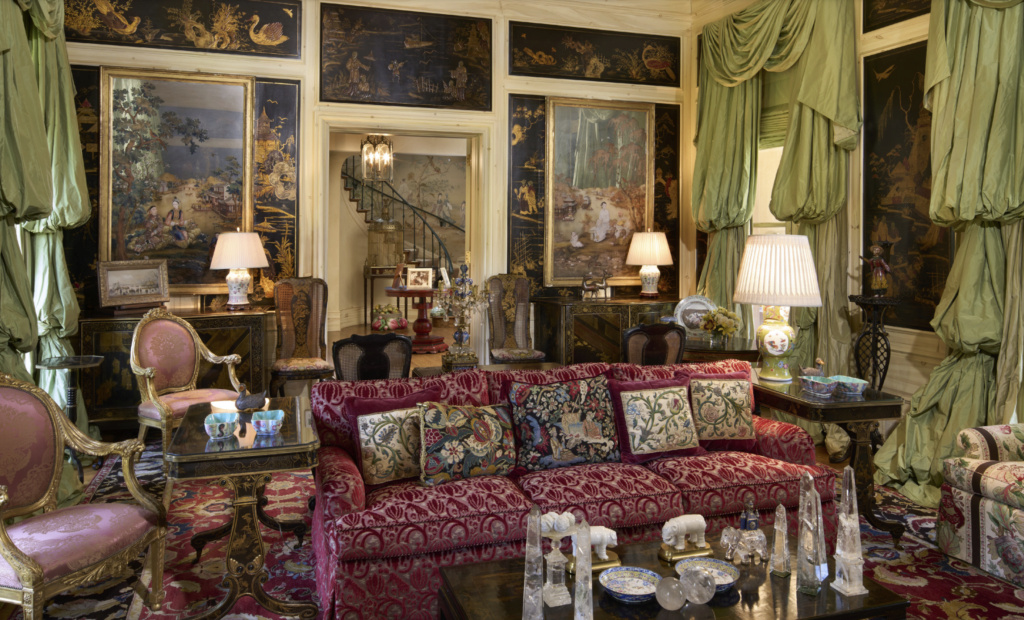
Lot Essay
A REMARKABLE SURVIVAL
At nearly six feet high, these enormous and superbly executed Chinese Export reverse-painted mirrors are a remarkable survival. In the 18th century, the journey to China was long and treacherous. It took twenty months of sailing during which crew faced violent storms, strong and dangerous currents, as well as flat calms and reefs. In addition to the natural challenges, they had to survive raids from pirates - which were expected when travelling through the Sunda and Malacca Straits. All of this was notwithstanding unfortunate strokes of bad luck, such as boardings for inspections, typically provoked by foreign rivals (T. Audric, Chinese Reverse Glass Painting 1720-1820 - An Artistic Meeting Between China and the West, Peter Lang, 2020, p. 15).

The port of Canton was the sole point of contact for all Westerners with China. Their large ships could not proceed to Canton itself, they had to moor at Whampoa, a little island in the Pearl River beyond Canton. From there, the crew had to row small boats up the river to access Canton, where all trade took place. But first, the ‘supercargoes’, the name for the representatives of the merchant ship's owner, had to negotiate terms of their trade deals with China that were to occur over the following four months. The supercargoes had to prepare for a visit from the Hoppo, the equivalent of a general customs inspector for the province of Canton. These meetings involved elaborate ceremony and profuse exchanging of gifts. If all went well, the supercargoes hoped to obtain favorable trade conditions and a warehouse on Whampoa in which to store their goods until it was time for them to make their return journey. After the meetings and an agreement was reached, the crew and cargo were then permitted to proceed to Canton (ibid.).

Many Cantonese painters took inspiration from their surroundings, and the subject-matter of many reverse-painted mirrors are scenes from along the Pearl River. Firsthand Western accounts of the journey often describe it as fantastically colorful, bustling with commerce and people from foreign lands, with exotic fruit trees bending over the water and towering pagodas in the distance. It must have been a breathtaking sight for those witnessing it for the first time.

This pair of mirrors show the Pearl River in the background, and in the foreground one depicts spring and youth, and the other depicts autumn and old age. The banks of the Pearl River were dotted by the luxurious dwellings that undoubtedly belonged to wealthy merchants or city leaders. After navigating up the Pearl River, and likely stopping at various posts along the way to show their necessary travel documents, the Western sailors finally reached the spot where the river widened. The row boats then had to navigate around hundreds of commercial sampans, colorful junks, and beautiful ‘flower boats’ where wealthy Cantonese were often seen dining. Only then could they moor in the quay and set foot in Canton to begin trading (ibid., pp. 15-16).

THE ORIGINAL FRAMES
The thickness of the glass and the style of the original Chinese frames on these mirrors suggests they were made for the European market, and were likely in a French collection. The later added pegged paneled backings of deal and poplar support this theory, as does the stencil inscription to the back of one: 115 dusol. It is possible they were supplied through the agency of the Compagnie des lndes, which maintained an important presence at the port of Canton. A single related example of comparable size was formerly in the collection of Sir James Horlick, Bt., sold Sotheby's, London, 10 November 1995, lot 66. A further comparable pair of mirrors, albeit of a much smaller scale and depicting interior scenes, was sold from the Estate of Doris Merrill Magowan, Christie's, New York, 22 May 2002, lot 25 ($361,500).
PAIR OF GEORGE III SATINWOOD, AMARANTH, MAHOGANY, AND ITALIAN REVERSE-PAINTED GLASS CABINETS-ON-STANDS
ATTRIBUTED TO INCE AND MAYHEW
CIRCA 1780
Each inset with reverse-painted glass panels depicting various Grand Tour landmarks, the sides fitted with doors opening to mahogany-lined drawers, on a conforming stand, the legs and feet replaced
81 in. (205.7 cm.) high, 46 in. (116.8 cm.) wide, 17 ½ in. (44.5 cm.) deep

Lot Essay
A SPECIAL ‘GRAND TOUR’ COMMISSION
This extraordinary pair of cabinets was specially designed to show off a splendid array of Italian reverse-glass paintings depicting various buildings and landmarks from the ancient and modern world, which were undoubtedly acquired as Grand Tour memorabilia.

The paintings are after designs by some of the most quoted printmakers including Maarten van Heemskerck (1498-1574), Maerten De Vos (1532-1603), and Lieven Cruyl (1634-1720). The cabinets, firmly attributed to the Golden Square partnership of Messrs. Ince and Mayhew, echo the classical themes of the paintings with their domed pediments and central segments evocative of temples, centered by an arched panel flanked by ionic columns beneath a dentilled frieze. The use of exotic timbers, such as satinwood and amaranth in this instance, is a common characteristic in the firm’s oeuvre. Likewise is the clever inclusion of concealed compartments, such as the discreetly opening doors on either side of the cabinets, which reveal a series of small drawers.

From 1764, Ince and Mayhew worked with Robert Adam on several notable commissions, culminating in their 'ability to produce very early on furniture in the most startling advanced Neo-classical taste' (G. Beard and C. Gilbert, Dictionary of English Furniture Makers 1660-1840, Leeds, 1986, p. 592). Indeed, this pair of cabinets closely relate to the Kimbolton Cabinet, ‘one of the most celebrated pieces of English neoclassical furniture in existence’ (H. Roberts and C. Cator, Industry and Ingenuity: The Partnership of William Ince and John Mayhew, London, 2022, p. 162).

Kimbolton Cabinet
by Robert Adam (1728-92), made by Matthew Boulton (1728-1809)
London, England, c.1771-76.
Mahogany and oak, with marquetry satinwood and rosewood, pietra dura plaques and ormolu (gilt-broze) mounts.
Collection of Victoria & Albert Museum, London
Image : From the book 'Art of the Royal Court: Treasures in Pietre Dure from the Palaces of Europe'
The 4th Duke of Manchester (1737-1788) commissioned Robert Adam to design the ‘highly individual’ cabinet for his wife Elizabeth Montagu, Duchess of Manchester. It was also created to display Grand Tour memorabilia, in this case a set of 11 Florentine pietra dura panels (ibid.). The 4th Duke commissioned Ince and Mayhew to make the cabinet around 1774, presumably once the design was finalized. The firm chose to partner with Boulton and Fothergill to supply the their finest quality ormolu mounts to the specified design (ibid., pp. 162-163). The masterful fusion of Grand Tour panels seamlessly integrated into the architectural cabinet, further adorned with ormolu accents and refined satinwood and rosewood marquetry was together exemplary of the firm’s best work of the 1770s, and the commissioner of this pair of cabinets, which are a more sober manifestation of the concept, surely must have been inspired by it.



POSSIBLE PROVENANCE
A CHINESE EXPORT REVERSE-PAINTED MIRROR
QING DYNASTY, QIANLONG PERIOD, THIRD QUARTER 18TH CENTURY
Depicting a reclining courtesan under a tree with birds and an approaching huntsman with attendants by a river with buildings beyond, with the original Chinese giltwood frame, the reverse with printed and inscribed Ann and Gordon Getty Collection inventory label
24 in. (61 cm.) high, 30 in. (76.2 cm.) wide, 1 ½ in. (3.8 cm.) deep

Lot Essay
The frame of this reverse-painted mirror is almost certainly original, and an example of a type produced in a Chinese workshop and kept after delivery to the West. Constructed in giltwood and carved with naturalistic motifs, in Chinese Reverse Glass Painting, 1720-1820, Thierry Audric points out that frames like this sometimes also had, 'lucky charm motifs, such as the characters for happiness or longevity, the attributes of Taoist Immortals, Buddhist symbols, and so on' (Peter Lang, 2020, p. 113).
The backboards of this frame are probably also original, and maintain remnants of applied Chinese paper. A related mirror with a nearly identical original giltwood frame and painting was sold Christie's, New York, 8 April 2004, lot 215, and is certainly from the same workshop.


A CHINESE EXPORT REVERSE-PAINTED MIRROR
QING DYNASTY, QIANLONG PERIOD, THIRD QUARTER 18TH CENTURY
The rectangular landscape scene depicting an amorous couple in front of a lake, with a child and a brace of pheasants, the later giltwood frame with a gadrooned molding and waved pierced foliate and serpentine border, with printed and inscribed Ann and Gordon Getty Collection inventory label
20 in. (50.8 cm.) high, 30 in. (76.2 cm.) wide



A CHINESE EXPORT REVERSE-PAINTED MIRROR
QING DYNASTY, LATE 18TH CENTURY, IN A LATER GILTWOOD FRAME
Depicting two pheasants perched on rocks amidst flowering branches with two smaller birds, in later giltwood frame, with printed and inscribed Ann and Gordon Getty Collection inventory label
43 in. (109.2 cm.) high, 21 ½ in. (54.6 cm.) wide, 1 ½ in. (3.8 cm.) deep


* Source et infos complémentaires : Christie's NY - The Collection of Ann & Gordon Getty: Wheatland
PAIR OF CHINESE EXPORT REVERSE-PAINTED MIRRORS
QING DYNASTY, QIANLONG PERIOD, LATE 18TH CENTURY
Finely painted with river scenes showing couples seated on the bank under trees, one couple in summer dress, he with a fan, the other in embroidered robes, she with a basket of flowers, each in original Chinese giltwood frames, and with additional pegged paneled backings of deal and poplar probably added in France in the 19th century, one of which is inscribed 115 dusol in pencil, and each with printed and inscribed Ann Getty Collection inventory labels
70 ½ in. (179.2 cm.) high, 44 ½ in. (113 cm.) wide, 2 in. (5.1 cm.) deep


Lot Essay
A REMARKABLE SURVIVAL
At nearly six feet high, these enormous and superbly executed Chinese Export reverse-painted mirrors are a remarkable survival. In the 18th century, the journey to China was long and treacherous. It took twenty months of sailing during which crew faced violent storms, strong and dangerous currents, as well as flat calms and reefs. In addition to the natural challenges, they had to survive raids from pirates - which were expected when travelling through the Sunda and Malacca Straits. All of this was notwithstanding unfortunate strokes of bad luck, such as boardings for inspections, typically provoked by foreign rivals (T. Audric, Chinese Reverse Glass Painting 1720-1820 - An Artistic Meeting Between China and the West, Peter Lang, 2020, p. 15).

The port of Canton was the sole point of contact for all Westerners with China. Their large ships could not proceed to Canton itself, they had to moor at Whampoa, a little island in the Pearl River beyond Canton. From there, the crew had to row small boats up the river to access Canton, where all trade took place. But first, the ‘supercargoes’, the name for the representatives of the merchant ship's owner, had to negotiate terms of their trade deals with China that were to occur over the following four months. The supercargoes had to prepare for a visit from the Hoppo, the equivalent of a general customs inspector for the province of Canton. These meetings involved elaborate ceremony and profuse exchanging of gifts. If all went well, the supercargoes hoped to obtain favorable trade conditions and a warehouse on Whampoa in which to store their goods until it was time for them to make their return journey. After the meetings and an agreement was reached, the crew and cargo were then permitted to proceed to Canton (ibid.).

Many Cantonese painters took inspiration from their surroundings, and the subject-matter of many reverse-painted mirrors are scenes from along the Pearl River. Firsthand Western accounts of the journey often describe it as fantastically colorful, bustling with commerce and people from foreign lands, with exotic fruit trees bending over the water and towering pagodas in the distance. It must have been a breathtaking sight for those witnessing it for the first time.

This pair of mirrors show the Pearl River in the background, and in the foreground one depicts spring and youth, and the other depicts autumn and old age. The banks of the Pearl River were dotted by the luxurious dwellings that undoubtedly belonged to wealthy merchants or city leaders. After navigating up the Pearl River, and likely stopping at various posts along the way to show their necessary travel documents, the Western sailors finally reached the spot where the river widened. The row boats then had to navigate around hundreds of commercial sampans, colorful junks, and beautiful ‘flower boats’ where wealthy Cantonese were often seen dining. Only then could they moor in the quay and set foot in Canton to begin trading (ibid., pp. 15-16).

THE ORIGINAL FRAMES
The thickness of the glass and the style of the original Chinese frames on these mirrors suggests they were made for the European market, and were likely in a French collection. The later added pegged paneled backings of deal and poplar support this theory, as does the stencil inscription to the back of one: 115 dusol. It is possible they were supplied through the agency of the Compagnie des lndes, which maintained an important presence at the port of Canton. A single related example of comparable size was formerly in the collection of Sir James Horlick, Bt., sold Sotheby's, London, 10 November 1995, lot 66. A further comparable pair of mirrors, albeit of a much smaller scale and depicting interior scenes, was sold from the Estate of Doris Merrill Magowan, Christie's, New York, 22 May 2002, lot 25 ($361,500).
PAIR OF GEORGE III SATINWOOD, AMARANTH, MAHOGANY, AND ITALIAN REVERSE-PAINTED GLASS CABINETS-ON-STANDS
ATTRIBUTED TO INCE AND MAYHEW
CIRCA 1780
Each inset with reverse-painted glass panels depicting various Grand Tour landmarks, the sides fitted with doors opening to mahogany-lined drawers, on a conforming stand, the legs and feet replaced
81 in. (205.7 cm.) high, 46 in. (116.8 cm.) wide, 17 ½ in. (44.5 cm.) deep

Lot Essay
A SPECIAL ‘GRAND TOUR’ COMMISSION
This extraordinary pair of cabinets was specially designed to show off a splendid array of Italian reverse-glass paintings depicting various buildings and landmarks from the ancient and modern world, which were undoubtedly acquired as Grand Tour memorabilia.

The paintings are after designs by some of the most quoted printmakers including Maarten van Heemskerck (1498-1574), Maerten De Vos (1532-1603), and Lieven Cruyl (1634-1720). The cabinets, firmly attributed to the Golden Square partnership of Messrs. Ince and Mayhew, echo the classical themes of the paintings with their domed pediments and central segments evocative of temples, centered by an arched panel flanked by ionic columns beneath a dentilled frieze. The use of exotic timbers, such as satinwood and amaranth in this instance, is a common characteristic in the firm’s oeuvre. Likewise is the clever inclusion of concealed compartments, such as the discreetly opening doors on either side of the cabinets, which reveal a series of small drawers.

From 1764, Ince and Mayhew worked with Robert Adam on several notable commissions, culminating in their 'ability to produce very early on furniture in the most startling advanced Neo-classical taste' (G. Beard and C. Gilbert, Dictionary of English Furniture Makers 1660-1840, Leeds, 1986, p. 592). Indeed, this pair of cabinets closely relate to the Kimbolton Cabinet, ‘one of the most celebrated pieces of English neoclassical furniture in existence’ (H. Roberts and C. Cator, Industry and Ingenuity: The Partnership of William Ince and John Mayhew, London, 2022, p. 162).

Kimbolton Cabinet
by Robert Adam (1728-92), made by Matthew Boulton (1728-1809)
London, England, c.1771-76.
Mahogany and oak, with marquetry satinwood and rosewood, pietra dura plaques and ormolu (gilt-broze) mounts.
Collection of Victoria & Albert Museum, London
Image : From the book 'Art of the Royal Court: Treasures in Pietre Dure from the Palaces of Europe'
The 4th Duke of Manchester (1737-1788) commissioned Robert Adam to design the ‘highly individual’ cabinet for his wife Elizabeth Montagu, Duchess of Manchester. It was also created to display Grand Tour memorabilia, in this case a set of 11 Florentine pietra dura panels (ibid.). The 4th Duke commissioned Ince and Mayhew to make the cabinet around 1774, presumably once the design was finalized. The firm chose to partner with Boulton and Fothergill to supply the their finest quality ormolu mounts to the specified design (ibid., pp. 162-163). The masterful fusion of Grand Tour panels seamlessly integrated into the architectural cabinet, further adorned with ormolu accents and refined satinwood and rosewood marquetry was together exemplary of the firm’s best work of the 1770s, and the commissioner of this pair of cabinets, which are a more sober manifestation of the concept, surely must have been inspired by it.



POSSIBLE PROVENANCE
- Spoiler:
- The early provenance of these cabinets remain a mystery that, when solved, will undoubtedly provide a key link in unravelling an as yet unidentified Ince and Mayhew commission. In 1964 they were sold from Northwick Park, Gloucestershire. At the time the sale was known for the collections, notably of Old Masters, formed by Captain E.G. Spencer Churchill, M.C. (1876-1964). Exactly what at Northwick had been collected by Captain Spencer-Churchill and what had been inherited is impossible to guess. There were three other lots in the sale that suggest a wider Ince and Mayhew commission: a demi-lune satinwood commode, a chamber organ, and a satinwood and floral marquetry breakfront bookcase (most recently sold: 50 Years of Collecting; Christie’s, London, 14 May 2003, lot 40, for £229,250). If it emerged that these were indeed from an earlier commission, there are at least two possible sources.
The first possibility is that the cabinets were commissioned for Northwick. Captain Spencer-Churchill inherited Northwick from his mother's family, the Rushouts, Barons Northwick. It is possible that some of the furniture survived the colossal Northwick collection sales of 1859. Any commission from Ince and Mayhew would possibly have been by John Rushout, 1st Baron Northwick (1738-1800).
While a Rushout-Northwick commission is conceivable, it does seem less likely than the alternative. Captain Spencer-Churchill was great-great grandson of the 4th Duke of Marlborough (d.1817) who was a long term client of the firm, at Blenheim Palace and probably for his son at Whiteknights, near Reading (H. Roberts, 'Furniture for the 4th Duke of Marlborough', Furniture History, 1994, pp. 130-139). It seems more likely that the four lots attributable to Ince and Mayhew at Northwick Park in 1964 had descended to Captain Spencer-Churchill as remnants of this branch of his family's enormous commission, rather than their having remained in Northwick throughout.
A CHINESE EXPORT REVERSE-PAINTED MIRROR
QING DYNASTY, QIANLONG PERIOD, THIRD QUARTER 18TH CENTURY
Depicting a reclining courtesan under a tree with birds and an approaching huntsman with attendants by a river with buildings beyond, with the original Chinese giltwood frame, the reverse with printed and inscribed Ann and Gordon Getty Collection inventory label
24 in. (61 cm.) high, 30 in. (76.2 cm.) wide, 1 ½ in. (3.8 cm.) deep

Lot Essay
The frame of this reverse-painted mirror is almost certainly original, and an example of a type produced in a Chinese workshop and kept after delivery to the West. Constructed in giltwood and carved with naturalistic motifs, in Chinese Reverse Glass Painting, 1720-1820, Thierry Audric points out that frames like this sometimes also had, 'lucky charm motifs, such as the characters for happiness or longevity, the attributes of Taoist Immortals, Buddhist symbols, and so on' (Peter Lang, 2020, p. 113).
The backboards of this frame are probably also original, and maintain remnants of applied Chinese paper. A related mirror with a nearly identical original giltwood frame and painting was sold Christie's, New York, 8 April 2004, lot 215, and is certainly from the same workshop.


A CHINESE EXPORT REVERSE-PAINTED MIRROR
QING DYNASTY, QIANLONG PERIOD, THIRD QUARTER 18TH CENTURY
The rectangular landscape scene depicting an amorous couple in front of a lake, with a child and a brace of pheasants, the later giltwood frame with a gadrooned molding and waved pierced foliate and serpentine border, with printed and inscribed Ann and Gordon Getty Collection inventory label
20 in. (50.8 cm.) high, 30 in. (76.2 cm.) wide



A CHINESE EXPORT REVERSE-PAINTED MIRROR
QING DYNASTY, LATE 18TH CENTURY, IN A LATER GILTWOOD FRAME
Depicting two pheasants perched on rocks amidst flowering branches with two smaller birds, in later giltwood frame, with printed and inscribed Ann and Gordon Getty Collection inventory label
43 in. (109.2 cm.) high, 21 ½ in. (54.6 cm.) wide, 1 ½ in. (3.8 cm.) deep


* Source et infos complémentaires : Christie's NY - The Collection of Ann & Gordon Getty: Wheatland

La nuit, la neige- Messages : 18132
Date d'inscription : 21/12/2013
 Re: La peinture sous et sur verre au 18e siècle, et la technique du verre églomisé
Re: La peinture sous et sur verre au 18e siècle, et la technique du verre églomisé
Ou bien il était d'usage ou possible de tenir l'oiseau sur sa main droite en Chine, je ne sais pas ? Aussi c'est une simple décoration, n'est-ce pas, pas un traité de fauconnerie...Mme de Sabran a écrit:
Je remarque que le fauconnier tient son oiseau sur le poing droit au lieu du gauche.A moins que ce ne soit nullement un fauconnier, car j'avoue ne pas bien discerner ... c'est sans doute la meilleure explication !



La nuit, la neige- Messages : 18132
Date d'inscription : 21/12/2013
 Re: La peinture sous et sur verre au 18e siècle, et la technique du verre églomisé
Re: La peinture sous et sur verre au 18e siècle, et la technique du verre églomisé
C'est cependant peu probable : l'utilisation du poing gauche s'impose parce qu'elle libère la main droite.La nuit, la neige a écrit:Mme de Sabran a écrit:
Je remarque que le fauconnier tient son oiseau sur le poing droit au lieu du gauche.
Ou bien il était d'usage ou possible de tenir l'oiseau sur sa main droite en Chine, je ne sais pas ?

_________________
... demain est un autre jour .

Mme de Sabran- Messages : 55497
Date d'inscription : 21/12/2013
Localisation : l'Ouest sauvage
 Re: La peinture sous et sur verre au 18e siècle, et la technique du verre églomisé
Re: La peinture sous et sur verre au 18e siècle, et la technique du verre églomisé
La nuit, la neige a écrit:Les amateurs de chinoiseries ne sont pas étonnés de retrouver des pièces en peinture sous verre et verre églomisé réalisées par les ateliers chinois
C'est ravissant toutes ces chinoiseries !

_________________
« elle dominait de la tête toutes les dames de sa cour, comme un grand chêne, dans une forêt, s'élève au-dessus des arbres qui l'environnent. »
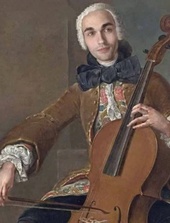
Comte d'Hézècques- Messages : 4390
Date d'inscription : 21/12/2013
Age : 44
Localisation : Pays-Bas autrichiens
 Sujets similaires
Sujets similaires» Portraits de Marie-Antoinette non attribués
» Le XVIIIème siècle vu en peinture par le XIXème
» La peinture française du XVIIIème siècle au Louvre
» Meubles à secrets au XVIIIe siècle et sous l‘Empire
» Les dessous ou sous-vêtements féminins au XVIIIe siècle
» Le XVIIIème siècle vu en peinture par le XIXème
» La peinture française du XVIIIème siècle au Louvre
» Meubles à secrets au XVIIIe siècle et sous l‘Empire
» Les dessous ou sous-vêtements féminins au XVIIIe siècle
LE FORUM DE MARIE-ANTOINETTE :: La France et le Monde au XVIIIe siècle :: Les Arts et l'artisanat au XVIIIe siècle :: Les arts graphiques et la sculpture
Page 1 sur 1
Permission de ce forum:
Vous ne pouvez pas répondre aux sujets dans ce forum
